Dragonmech by Mors Rattus
Intro
Original SA post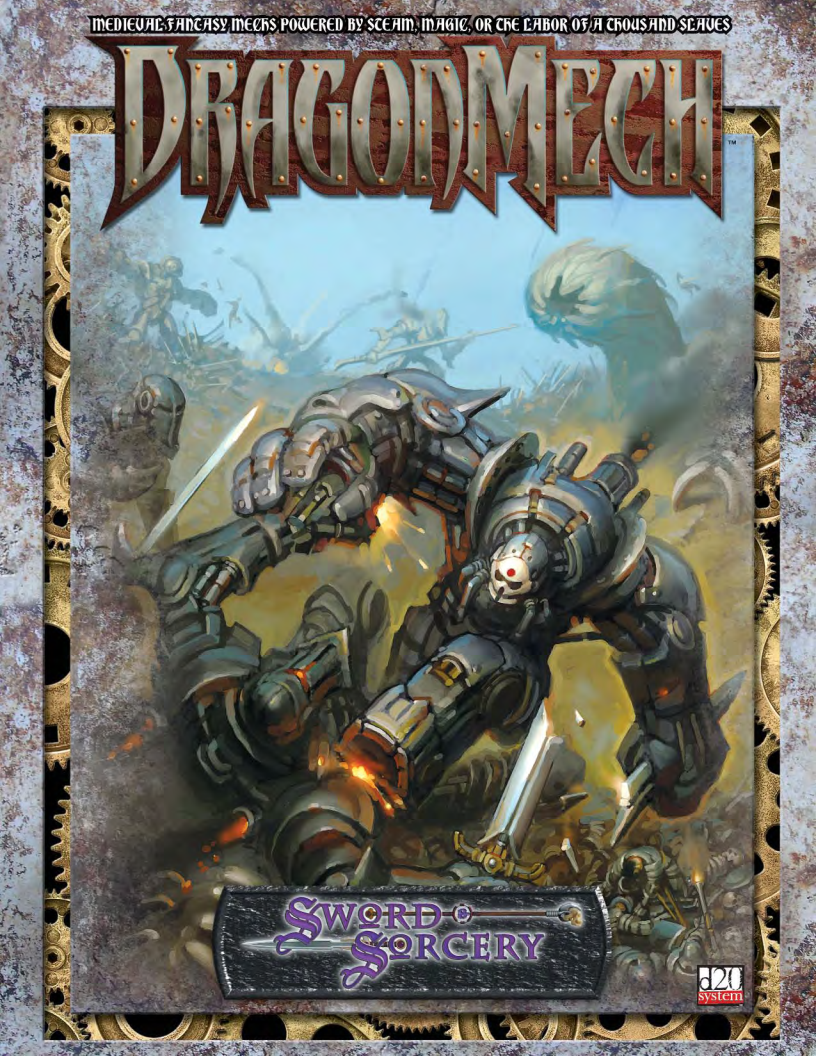
I love Dragonmech. It is the best, stupidest RPG setting in 3.5, bar none. It was produced largely by Justin Goodman via Sword and Sorcery - a White Wolf-owned d20 press, though it also received development from White Wolf alum C. A. Suleiman. It is an extremely fun setting with extraordinarily bad rules - bad even for a d20 supplement. So, what is Dragonmech?
It's D&D where giant robots exist and are fighting evil alien dragons from the moon. Once upon a time, the entire surface world was under siege, because the alien monsters were literally faliing out of the sky from the moon and rampaging all over, and they resisted most normal magic. Plus, even if you won against the lunar monsters, the next wave showed up only days later. The surface races were being pushed to their limits and forced underground. The dwarves, in their ancient underground stronghold Duerok, were in the best position, safe from monsters - but not from refugees or those who would invade it to claim its safety. All hope seemed lost until the arrival of the dwarf Parilus, who claimed to be eldest of the Master Gearwrights. The Gearwrights Guild had been an ancient organization, forgotten even by most dwarves, who were said to have risen in the Age of Walkers, long since forgotten.
Parilus taught the dwarves how to make immense machines - walkers, powered by steam. He showed them the power of ten tons of metal that walked like a man and could face a lunar dragon by itself. He helped the dwarves in the construction of the first citymech, a thousand feet tall and able to face many dragons. Then he left, forever. Now, it's a century later. It is the Second Age of Walkers. Five dwarven city-mechs house thousands of people and patrol the surface near Duerok. They face off against the lunar rain with weapons enough to take down nearly anything, and even then, they are need of constant maintenance and repair. These five citymechs are known as the Stenian Confederacy, and they are the center of surface life in the world of Highpoint. Their safe haven is where trade is centered, and while the lunar rain is slowing now, they are the center of society. Trader-mechs travel between settlements, and explorer-mechs are sent to the ruins of old cities to pick through them.
However, all is not peaceful. Resource disputes between the Confederacy and its neighbors are beginning, now that the human nomad tribes have united under the demagogue Shar Thizdic and have built a citymech of their own. Now, Shar's Legion heads into regular fights against the Stenians, and mercenaries are used on both sides. Besides, not everyone likes the Confederacy's harsh rules. Its order and peace are enforced by martial law, and vigilantes are on the rise to fight it. Many priests believe the Confederacy is shortsighted, as well, and that nothing has been done to understand and stop the lunar rain. Some clerics and paladins plan to invade the moon itself, but the Confederacy cares only for territory.
Most old customs and societies were lost to the rain, and almost all of the old gods are forgotten, replaced by new faiths. The newest of these is the machine-god Dotrak, who whispers to prophets, but it is not the only one. The lunar gods recruit in secret, hiding behind masks, as well. Old kingdoms are forgotten, replaced by the power of mechs. The Gearwrights now outpower some nations of old, commanding entire citymechs. They push the limits of technology and hunt for ruins of the First Age of Walkers.
The elves are the old guard - they remember before the lunar rains began, and they resent the new order of mechs and gearwrights over magic and history. They use magical mechs made from living trees, hunting down their lost and stolen treasures. The orcs of the south, meanwhile, have grown to love mechs and the power they represent, and have begun to raid for parts more and more often. Thieves profit now, so much that even the Stenians pay certain concessions to thieves' guilds, using them to keep the lower levels of the citymechs in line.
The heroes of this world are the mech jockeys, who pilot warmechs into battle in search of resources to keep the citymechs alive or to face the lunar hordes. They are smugglers, traders, glory-seekers. The most famous of them are the Irontooth Clans, a network of families who owe no loyalty to any but themselves and who practice the art of mech fu, merging ancient tradition and modern technology. Their greatest pilots, the mech devils, are feared by anyone with sense.
Next time: But what can I play?
Off to the Races
Original SA post Dragonmech: Off to the RacesAll of the standard D&D races are around still. Humans have, typically, been nomads on the plains of Highpoint. They were protected on all sides by the natural barriers around the plains and largely fought each other, with kingdoms rising and falling constantly, or with the orcs that also lived there. The few non-nomadic human cultures built impregnable fortresses to protect themselves from the nomad tribes. However, the lunar rain has reduced all these human cities to ruin. Many have been turned into lairs by the lunar dragons. However, some humans do still survive in the tunnels and smaller areas in the ruins, where the dragons can't reach - hundreds or even thousands of refugees with nowhere else to go. The nomads did better than the city-dwellers, as the dragons mostly ignored them, but the lunar rain forced them into refuge in caves, mountains and forests - sometimes hundreds of miles away, with many dying en route. The humans that were more friendly with the dwarves did better than others. Older humans tend to be cynical refugees, having been constantly fighting or running or both for fifty years or more. They've never known peace, and they see mechs as just the latest in a string of temporary refuges. Younger humans take mechs for granted, having known nothing else. Human groups are described in more detail much later, but there are a few groups that give special abilities and weaknesses.
E: Specifically:
There's a tribe of mounted people, the Stavians, who argue over whether horses or giant bugs are better mounts. They get Ride as a class skill and +2 to all Ride checks, but no matter what class they take they lose all proficiency with any weapon that can't be used on horseback, which includes all Large weapons. To get it back they need to spend feats.
There's also a tribe of sneaky people, the Wisps, who get Hide and Move Silently as class skills and +1 to Spot checks, but don't get the +4 skill points at first level (though they get the +1 skill point per level after that like all other humans).
Dwarves are the dominant species of Highpoint, insofar as anyone can be called dominant against the lunar hordes. Their underground homes were safe from the lunar rain, and the dragons too big to fit in their tunnels. However, the other peoples of Highpoint sought refuge with them and often used force to do it, laying siege to the dwarven kingdoms. As aresult, they've been at war for nearly a century, though the violence has lessened recently. Most of the invaders are dead now, and refugees are turning to mechs. During the Years of Blood Rain, as the dwarves refer to the invasions, nearly two thirds of the entire dwarven nations were killed, and some dwarven cities were lost to humans, elves or orcs. Dwarves tend to be stoic and weary defenders, distrustful of outsiders, who see their mechs as a mixed blessing - they're great, but they mean leaving behind the traditions of stone and dwarfdom.
The dwarven bonus to Craft checks with metal applies to mechcrafting. However, dwarves raised in mechs do not get the dwarf stonecunning ability - instead, they get +2 to Mech Pilot checks. (That's a new skill.) Also, the bonuses to fighting giants, orcs and goblinoids do not apply to fighting orc mechs - it's for personal combat, not mech combat.
The elves were protected for a time by the forests they lived in, but eventually, the lunar rain wore them down. The elves, with their long lifespans, suffered hard. Humans were shortlived and adapted well as a result, and dwarves at least kept their culture in their former realms. The elves have lost all their woodland realm. Tens of thousands of years of civilization are ruined except for a few portable libraries and half-forgotten songs. Barely half a generation has passed for the elves since the rain began, and every living elf is fully aware of what has been lost. Worse, they now have to live in cramped spaces, and they're not good at it. Elves are a deeply sad race. However, they welcome mechs - a tall, mobile mech is far preferable to living underground. The most advanced mechs today are made by elf magic, built from the partially destoryed ancestral trees that had been the center of elven fvillages, crafted into still-living mechs. These wooden mechs must root in the ground for an hour a day, but are still extremely potent, and carry the traditions of the elf villages. Elves tend to be sad and distant, but also hopeful. They live for seven centuries - that's plenty of time to fight off the lunar rain and its creatures and reestablish the elven culture.
Gnomes suffered much the same fate as dwarves, with their underground burrows raided by others. However, they lacked the defenses of the dwarf lands and did much, much worse, despite their illusion powers. Most gnome villages are wastelands now. Gnomes, however, have been the builders of many of the mechs of the world. Dwarves invented them, humans developed the craft, but the gnomes built them and were welcomed for it. They aren't so useful with elven mechs, but most anyone else will welcome a gnome technician and their clan. Besides, gnomes are fun. They like jokes and pranks, and any laugh is a good one in a place like Highpoint.
Half-elves have always had trouble - elves and humans in Highpoint don't really get along. Elves are stable, humans nomadic. Most half-elves never really belonged in either, but they were accepted. Most identified with one side or the other, but now, they have a chance to define themselves. Half-elves find the societies that have sprung up in the lunar rain easier to fit into and love mechs, working in human and elven crews alike.
Half-orcs are born from one of the most despised races in Highpoint, and they are liked only slightly more than full orcs. They are not accepted anywhere, and orcs see them as weaklings. They are typically found on mechs only when they pay for the privilege, or as slaves on an orc mech. They tend to be crude and coarse, having never known another way. They also tend to be blase about the lunar rains - it's not as though they made life any worse for half-orcs. They tend to be quite well-adjusted to the new world, in fact, having had little pride to lose.
The halflings of Highpoint never really controlled any land - they were hangers on to other civilizations. They've adapted well to the new world, having escaped the dragons by being small and easy to hide. They didn't have to fight to find hiding places, and they've always been good at seieng opportunity. Many are now traders, scouts or technicians. Often they are known on mechs as coglings, able to fit into tight spaces to perform complex repairs better than anyone else. Many halfling communities live entirely inside mechs, serving as the labor that keeps the engines running. Often, these communities are stowaways, even feral tribes that live in the gears without anyone knowing. They tend to be cynical but not jaded. The new world has brought htem new opportunity, after all.
Next time: Classes in Dragonmech, and why being a cleric is the worst.
You Have No Class
Original SA post Dragonmech: You Have No ClassYour standard classes mostly work fine. Barbarians are especially common in the ruins of the surface, outside the mechs. Bards are rare but welcomed anywhere they go, as people are desperate for entertainment. But clerics, now...clerics have a hard time. People wonder why the gods allowed all this to happen, see. Either the gods don't care, or they were too weak to stop the disaster. The truth is, the old gods are fighting the lunar gods. The lunar gods have a strong foothold on Highpoint now, and the old gods are battling back as best they can on other planes, but they're not winning. Thus, clerics receive spells only when their deities have the strength to spare. Ever day, a cleric has to make a DC 6 Wisdom check after the hour of prayer to get spells. A 1 always fails, too. The DC can also be modified. For every day that you don't get spells, the DC goes up by 2. So if you fail once, it's gonna get harder. However, if on the previous day, you helped defeat the forces of the lunar gods or their allies and agents, the DC gets -2. Further, if on the previous day you otherwise helped your god in some major way, like making temple, founding a sect, beating an enemy cleric or other stuff, you get -1 to the DC.
Every cleric has to roll the check, even if they're of the same faith, because "it dpeends not just on the deity's ability but also the cleric's piety and the deity's power on that day." However, clerics can also tap into the power of the gods to fight the lunar horde. On any day in which a cleric gets their spells, they may attempt to channel divine energy into a spontaneous spell, as long as they are opposing a lundar creature or effect, which can include protecting or healing someone from the lunar rain or damage caused by lunar beings. To do that, you just try to cast any spell you could normally cast, even if you didn't memorize it, and make a Wisdom check. Succeed and you cast the spell without losing a spell slot. Fail, and nothing happens. The DC is 20, modified the same way the check to get spells, but the DC goes up by +4 cumulatively after each attempt to get a free spell, success or failure. Oh, and clerics and paladins serving terrestrial gods can automatically sense if a creature they face is Lunar by making a Wisdom check against DC 15, rolled by the DM.
Druids are exceptionally rare these days. The natural world has mostly been devastated by the lunar rains, and those few that remain are fanatics. "A player must explain how his druid character has come to such a profession in the world of Highpoint." Helpfully, examples are provided - apprenticed to an older druid who predated the rain, a refugee hidden in a burrow and raised with knowledge only of the postapocalyptic world, and so on.
Fighters are common in underground areas, largely from the cities of Chemak and Duerok. Monks are rare, but no rarer than they were before the rain, and are commonly found in the Irontooth Clans, learning the ways of the mech devils. Paladins are out there as champions of the faith, though they suffer the same limitations on spellcasting as clerics. Their other abilities are not affected. Rangers are pretty rare these days, and there is a new core class that is a ranger variant, the clockwork ranger. Rogues are really, really common. Sorcerers have shown up in increasing nmber with the lunar rain, touched by the power of the moon, and their spells tend to manifest in moon-themed ways, which can make them hated in some places. Many find it irritating that their powers are not respected more than those of mech jockeys or machinists. Wizards are exceptionally rare outside of elf territories, as most places of learning have been destroyed entirely and the world is mostly turning to machines instead.
So, the clockwork ranger. They tend to live in 'gear forests' - the vast, chaotic engine rooms that are within the citymechs. They are in many ways quite like normal rangers - they study the beasts of the gear forests and those that invade them. They tend to be loners. However, they have an instinctive understanding of engineering rather than nature. They are identical to normal rangers, except that they get Knowledge (Steam Engines) as a class skill, their spellcasting is off a more mechanically-oriented spell list, their Track ability treats the grimy floors of the gear forests as firm ground and really sludgy areas as soft ground, and their animal companion must be native to the gear forests. The list they are given is, specifically: dire rat, grease lizard, Medium or Large centipede, Medium spider or Small or Medium snake.
The coglayer is another new base class. They tend to be neutral or chaotic, caring far more about knowledge and technology than loyalty. They are often shy and retiring except when showing off their inventions. They rarely worship any god except Dotrak, and even then, mostly not. They are usually trained by the Gearwrights Guild or a similar group, though their trianing is quite informal. They are often gnomes or dwarves, followed by humans or half-orcs; elves prefer magic and halflings tend to be less interested in building mechs. They are mostly craftsmen, focusing on Intelligence and Dexterity to build the powerful weapons and mechs that they use. In fact, they're basically this game's wizards, in a way. They have d4 hit dice and their class skills are Craft (Blacksmith), Craft (Mechcraft), Disable Device, all Knowledges, Listen and Mech Pilot. They get 8 base skill points and are naturally prificient with clubs, dagters, heavy and light crossbows, quarterstaffs, all shields except the tower shield, and padded, leather, studded leather, pilot's, chain shirt, scale mail, gearmail and chainmail armor. They have wizard BAB progression and a good Will save.
At first level (and every level divisible by four) a coglayer gets a free exotic weapon proficiency from the list of: buzzaxe, buzzsaw, chattersword, flame nozzle, lobster claw, steambreather and steam gun. Further, they get the Machine Empathy ability which lets them add their level to all Craft (Mechcraft), Knowledge (Mechs) and Knowledge (Steam Engines) checks and gives them the Craft Steam Gear feat free. At second, fifth, ninth, 13th and 16th level, they gain proficiency with any single mech weapon. They also get a number of Steam powers - 2+Int mod at 1st level and gaining more as they level up, to a max of 16+Int mod. Any powers you have at 1st level are considered already built and part of your equipment, but any new ones must be built and paid for as per the rules for that, found later. The powers you have are what you are able to maintain, and you don't have to specify which powers you have in your slots until you actually build a device that uses that power, as long as you never exceed your limit. If a device is destroyed, that slot is freed up again and can have any power put into it. Each morning, the coglayer has to spend an hour maintaining their steam powers, doing maintenance and so on, and must be able to concentrate in that time. For every day in which this doesn't happen, the coglayer loses one power. All powers are restored after a full hour of maintenance.
At third level and every four levels after that, a coglayer may integrate two steam powers built into the same device into a single unit, which weighs as much as the smaller of the two did before combining. (This is because coglayers are usually low-Strength and have encumbrance problems.) It doesn't matter how much sense this makes, because, quote, "this is fantasy engineering!" Lastly, at 12th level or higher, a coglayer may take the That Piece Is Important ability of the Stalker class rather than a normal feat, and if they do, they may identify stalker sabotage in half the usual time. No, we haven't seen the Stalker class yet.
Next time: Constructors, Mech Jockeys, Stalkers and Steamborgs
My Boyfriend Is A Pilot
Original SA post Dragonmech: My Boyfriend Is A PilotThe constructor is a wizard variant that specializes in making constructs. They've only been around ofr a few decades and mostly are organized into the College of Constructors, who work to expand the science of constructs beyond golems. They focus on spells that mimic construct triats and work to match the machines of the coglayers. All constructors must be members of the College of Constructors, but they accept anyone that wants to join. Their spell list includes all wizard spells, plus a few divine spells they've adapted and several variant spells focused on affecting constructs instead of the old targets. These restricted, constructor-only spells are regulated by the College nad may never be taught to nonmembers, and so can only be leanred by membership or stealing a member's spellbook. All constructors are specialist wizards, as per the PHB, and must ban one school. It's almost always necromancy, as the special constructor spells contain spells from all the other schools. Constructors can also build a clockwork familiar rather than getting a normal familiar. More on that later in the magic section.
The mech jockey is a pilot. It's been clear since mechs were made that making and piloting them were not the same skills, and mech jockeys are chosen for piloting skill, not technical skill. They are the heroes of the new world, and they love their job. Most are cocky and self-assured, but for good reason. Their talent is exceptionally useful now, far more than the old days when they might have just raced buggies or chariots. While their main skill is piloting, most are amateur technicians to better maintain their machines or juicing them up. While they aren't as atheistic as coglayers, they still tend to focus on machines over gods, and most follow Dotrak to a greater or lesser extent. They are usually human, as humans seem to love the thrill of piloting. Other races have mech jockeys, but not so many as humans and rarely with as little disregard for their own safety. Dwarves, especially, tend to have coglayers as pilots.
Mech Jockeys favor high Dex and Int. They have a d6 HD and have Balance, Climb, Craft (Mechcraft), Jump, Knowledge (Mechs), Knowledge (Steam Engines), Listen, Mech Pilot and Spot as class skills. They get 4 base skill points and are proficient with all simple weapons, rapiers, short swords, all crossbows, steam guns, light and medium armor, pilot's armor and gearmail, but no shields. They are proficient with all mech weapons automatically. They have midrange BAB outside a mech and full BAB in one, and good Reflex. They add their mech jockey level to all Mech Pilot checks, and get Quick Draw and Weapon Finesse for free, even if they don't meet the prereqs, due to their excellent reflexes, hand speed and coordination. At levels 2, 4, 7, 10, 13, 16 and 19, they get a bonus feat off a special list focusing on mech feats. At level 2, they can do patchwork repairs once per day as a full round action, repairing the effects of a single critical hit but not healing any HP damage to the mech. These repairs last 1d6+(half mech jockey levels) hours.
At third level, a mech jockey can "push the envelope" once per day, giving their mech +2 to attack and damage rolls, +2 to saves and +10 feet to move speed. This lasts for (3+Int mod) rounds, and when that ends, the mech is overheated for 1d4 rounds and gets -2 to attack and damage rolls. An extra use of this per day is gained every 3 levels, and at 12 th level, the bonuses double. At 18th level, there is no more overheating period. Pushing the envelope is a free action and can be done at any point, even when it's not your turn. At 5th level, a mech jockey treats crits as if they were one critical threshold less dangerous, to a minimum of green. At level 11, two increments. At level 20, three increments. (This matters for mech combat; we'll get to it later.) At 6th level, a mech jockey may use the Dodge, Expertise, Cleave, Great Cleave, Improved Trip, Power Attack and Whirlwind Attack feats during mech combat, if they have any. (Improved Critical, Improvited Initiative and Improved Sunder already work in mech combat, while Shot on the Run and Spring Attack are usable if you have the Mechwalker feat.)
The stalker is a rogue variant. They are essnetially sabotage and infiltration specialists. They get Knowledge (Mechs), Knowledge (Steam Engines), Craft (Mechcraft) and Mech Pilot as class skills on top of the normal Rogue list, but lose Appraise, Forgery, Perform and Swim. At 10th level and every 3 levels after that, they get a special ability. 10th level must be Contortionist and 13th must be That Piece Is Important, but the rest can be chosen from the usual rogue list. Contortionist lets you dislocate any joint at will, giving +5 to Escape Artist checks, which stacks with the Agile feat, and allows you to squeeze into just about any opening. That Piece Is Important lets you study a mech's engines for at least an hour (on a small mech of merely Large size) and up to six months (for the largest citymechs). After that, you can make a Disable Device check but may not take 10 or 20 on it. The DC is 16 on the Large mech and up to 42 on the largest citymech, size City-mech F. If you succeed, the entire mech is forced to a grinding halt within 2d6 minutes, with all systems tied to the central engines failing. The mech takes no damage but must be repaired as if it was dropped by 15% of its normal HP, and this takes at least half as long as you spent studying the mech. If you fail, you must wait a week to make another check, and must make a Bluff check against the same DC to avoid your work being detected. This power cannot be used on necromantic or magically animated mechs. Also, any rogue or stalker can freely multiclass as the other as if it were their race's favored class.
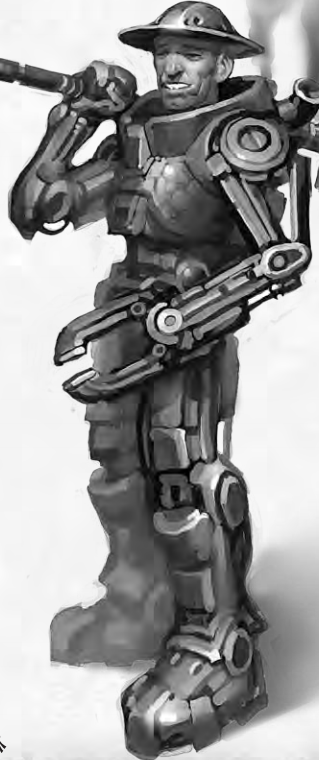
The other class art has been boring, but this guy?
The steamborg is someone who's taken their engineering to a dangerous level, turning themselves into a steampunk cyborg. They were born of rising technology meeting postapocalyptic nihilism. People needed artificial limbs, and the engineers began to experiment - and found they could make artificial limbs better than the originals. The experiments of the first steamborg, a dwarf named Darius, formed a group of obsessive dwarven engineers, and it wasn't long before they dispensed with the polite fiction of helping the disabled in favor of voluntarily doing surgery on each other until they were more steam engine than dwarf. Steamborgs tend to Neutral or Chaotic, as they must breach all kinds of cultural boundaries and are rarely especially disciplined. Instead, they embrace risk. They have no respect for the old gods, with power coming from machines. If they have any religion at all, it is towards Dotrak, but evne that is rare. Almost all of them are dwarves,though gnomes are the second most common, followed by humans. Most people, however, of any race or background, find them incredibly disturbing. (Except orcs, who respect physical strength in any form.)
Steamborgs favor Constitution above all else, followed by Intelligence (to understand the tech) and Charisma (to retain their personhood). They have a d8 hit die and have Balance, Climb, Concentration, Carft (Mechcraft), Disable Device, Heal, Jump, Knowledge (Steam Engines), Listen and Profession (Engineer) as class skills, and get 4 base skill points. They are proficient with simple weapons, buzzaxes, buzzsaws, chatterswords, flame nozzles, lobster claws, steambreathers, steam guns, light and medium armor, and all shields except the tower shield. They have midrange BAB and good Will and Fort. At 1st level, all they get is the steam engine implant, usually in the chest cavity but it could really go anywhere. It's protected but always quite abovious thanks to the gauges and pipes that are visible and the smokestack that spews exhaust, giving -4 to all Hide checks. This penalty can be removed for up to 5 minutes by disabling the exhaust, but after 5 minutes the exhaust must be turned back on or you start to suffocate. The steam engine is protected from exposure, except for total submersion. It will cease functioning if submerged for more than 30 minutes, losing all of its special abilities until repaired (as if it had lost 20% of its HP, which is a minor repair) - but note that if you have two artificial arms you can't fix it yourself because they won't be working. The engine draws water from the steamborg's body, requiring them to drink three times as much as a normal person to avoid malfunctions. At first level, the thing doesn't actually do anything, though.
At second level and every even level after that, you get a new artificial part bonus. You can redistribute what these do, as long as your total effects are no more than your total bonus. You may replace any body part except your head, and what you replace should at least be tangentially related to the effect of your new body part. Each part does something for you, with a related cost - usually +1, but extra hit dice cost +2 bonus and extra attacks cost +3. You can get +1 Strength, +1 Dex, +1 to attack rolls, +1 to Str-based attack damage, +1 AC, +1 to Fort save, +1 to Ref saves, +5 feet of movement, increase the damage die of a natural weapon or unarmed attack by one step, get +1 HD or get an extra attack (to a max of two extra attacks) at your lowest attack bonus. You can take a bonus more than once, too. If your steam engine breaks down, so do all the bonuses you get - and any side stuff that mechanical part did, such as 'be an arm.' And yes, if you get an artificial heart, you die if the engine breaks down. Also, your total bonus can never be more than twice your Con mod, even if the class lets you go higher. Also, each time you change your abilities, it costs 1000 GP per point of bonus changed, though it costs nothing to just add a new part.
On top of all this...you add your maximum bonus to all Craft (Mechcraft), Disable Device and Knowledge (Steam Engines) checks. If you have an artificial arm, you can use it as a club for 1d6 damage, or can buy weapons and staple them to your arm, preventing it from ever being disarmed. However, you are now weak to rust attacks, though you can always make a Fort save to resist, though with your current total bonus as a penalty to the check. You also gain steam powers as you level, starting at 3rd level, and maxing out at 5+Int mod powers, which are associated with your parts and cannot be changed unless you change out those parts. At 5th level, you get +2 to AC as a natural armor bonus stacking with other armor (including the natural armor you get from your parts, if you have any), but it costs 2000 GP to get these implants and a DC 25 craft check, though you can do it on yourself fine. The operation takes a day of work and two weeks of convalescence. At 9th level you can remove your skeleton and replace it with metal, getting +2 Con and +2 to Fort saves (on top of the increased Constitution), though the Fort bonus is built into the class's chart. This costs 5000 GP and a DC 30 check, but you can't do it to yourself this time. It takes 5 days of work and 4 weeks of rest after. At 19th level, you cease to age for as long as you have the tools to maintain your body.
However, starting at 3rd level, a steamborg must make a Cha check each morning at a DC of 10+(total current artificial parts bonus). Fail and for the rest of the day, your aligment is True Neutral and you think like a machine, ignoring emotion entirely in favor of utility and suffering -4 to all Cha-based checks. You may also, at the DM's whim, become overly logical or repetitive, or some other 'mechanical' trait, as long as it disrupts your normal interactions with people without making you unplayable.
Next time: Prestige classes!
Anklebiters. Really.
Original SA post Dragonmech: Anklebiters. Really.So since the steamborg is a lot of text, I'm just going to note: it sucks. It is awful. It is extremely overcomplicated, and most of that complication is downside. Its actual class powers are super underwhelming, and they cost money to get. At first level it gets literally nothing useful, and their steam implants are all far, far less useful than the game thinks they are. Steamborgs are fuckin' awful. Also, mech jockeys are better at mech piloting than anyone else and will automatically win any mech fight against a non-mech jockey, so that's fun. Mech fights are weird and we'll get to how they work eventually. They don't even get many steam powers, which are interesting if ultimately also really underwhelming. (So hey, coglayers aren't great either.) Now, let's look at prestige classes.
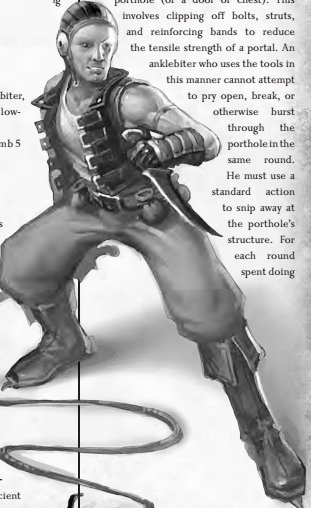
The anklebiter - yes, really - are specialists in taking down mechs while on foot. They run at mechs, jump or climb onto them, then make their way up and/or into the mech, get to the cockpit and kill the pilot. Becoming one isn't that hard - there's a ton of people who know the techniques and they're widely used by anyone that has to fight mechs regularly, so it's not locked behind any organization. To become an anklebiter, you need 5 ranks in Balance, Climb and Jump, a Reflex save of +4 or higher, and a BAB of +3 or higher. You get a d10 hit die, and your class skills are Balance, Climb, Jump, Knowledge (Mechs), Listen and Spot. You gain proficiency with all simple and martial weapons, plus the net, whip, and all armor and shields except the tower shield. You also get the Mech Rider feat free, even if you don't meet its prereqs. You get good BAB progression, good Ref and a half-decent Fort save.
On top of that, anklebiters get a set of masterwork tools. These give a +4 bonus to prying open doors, chests and mech portholes. However, they also have another use - they can be used slowly and methodically to reduce the DC to do any of those things. By taking a standard action, you can clip bolts and bands and so on. For each round you do this, the DC to break open the door/chest/porthole goes down by 1, to a maximum reduction of 5. If you fail, the DC goes back up, but you can reduce it again if you want. At level 2, you get the connections to get up to 1d4 pressure bombs per day. At level 3, you can also get up to 1d4 magnet bombs per week, and at level 4 you can get up to 1d4 rust bombs per month. And by 'get' I mean 'buy' because apparently you still have to pay for those. At second level, you also get a +1 bonus to Climb checks made to climb a mech's legs, ranged touch attacks to hook a mech with grappling hooks and Jump checks to grab onto mechs. This goes up by +1 every even level. At 3rd level, anklebiters may choose, before trying to break open a porthole or entrance (or a chest), to make a 'bloody invasion' and make a Fort save as a free action at DC 10. If they succeed, for every point by which the save exceeds 10, they get +1 to their STrength roll to break open the entrance, but take 1 subdual damage. So if you roll a 14, you get +4 to the Strength roll and take 4 subdual damage. You can do this once per round but as often you like other than that. At level 5, you get evasion, but only against mech tramples. At 7 and 9, you get a bonus feat off the fighter list.
The anklebiter is...well, underwhelming. It's a neat concept, but its bonuses are small and its abilities are pretty limited. I mean, it gets really good at breaking doors open, but that's really it. It doesn't get any tools to actually be better at, say, killing the guy inside the mech. (Also, for some reason, its BAB goes up to +10 but doesn't split into multiple attacks. I don't know why.)
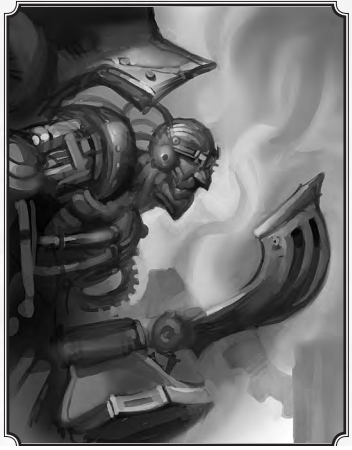
The assimilated is insane even by steamborg standards. They're what happens when someone becomes so attached to their mech that they decide to literally attach themselves to it, hardwiring themselves into the mech until, eventually, they're basically a torso stuck, immobile, in the cockpit. Only a handful actually exist and are seen as insane by everyone else. They tend to believe normal people are insane, and that being a mech fucking owns. To become an assimilated, you need to, first, not have a Lawful alignment. Second, you need a Constitution of at least 18. Third, you must have 10 ranks of Craft (Mechcraft) and 15 of Knowledge (Mechs), Knowledge (Steam Engines) and Mech Pilot. You need the Mech Dancer, Mechidextrous and Mech Walker feats. You need to have lost your sense of humanity - mostly, this means you fail the steamborg daily Charisma check five times in a row, but the DM can rule that something else counts, like a deep personal tragedy, as long as it's extreme. Last, you need to have a level 10 or higher coglayer or steamborg to help you and, of course, you need a mech to assimilate with. It is also suggested you get enough steam power abilities to create clockwork puppets to serve as your hands on a personal level, but this is not strictly required. Just, by the time you're done you will be unable to move your human body at all.
The assimilated gets a d4 hit die and has Concentration, Craft (Mechcraft), Disable Device, Knowledge (Mechs), Knowledge (Steam Engines), Listen, Mech Pilot and Spot as class skills. They gain proficiency with any weapons ever mounted on their mech. Their BAB actually goes down at every level - at level 1, it's -2, and at 2, it's -4. After that they become incapable of actually attacking personally. Their mech BAB goes up in leaps and bounds, however. They have no good saves. Further. they add double their assimilated class levels to all Mech Pilot checks, and gain the Mech Fu feat if they didn't have it already.
At level 2, the assimilated's legs are physically locked into the mech. Their upper body and hands remain mobile, but from the waist down, nothing is moving. They can detach themselves, but require a wheelchair or similar to move about, and they may no longer take any additional ranks in skills affected by this limited mobility. In exchange, they may now communicate with their mech telepathically, operating it without need for movement or speech, though they sitll need to use their eyes to pilot unless the mech has sufficient optical interface. At level 3, the assimilated is permanently installed in the mech, immobilizing them entirely from the neck down. They can no longer be removed from the cockpit. They also gain one of the Gearhead, Natural Pilot or Speed Freak feats, provided they meet the prereqs. At level 4, they get another feat off that list, and also have perfect knowledge at all times of their mech's physical condition and damage, receiving direct input from any sensory devices built into the mech and feeling any damage to it or its engine, essentially treating it as his 'real' body. This also grants the ability to 'push the envelope' per the mech jockey class five times a day, which stacks with any uses of that ability from mech jockey levels. At 5th level, they get the third feat off that list, but are now incapable of moving even their mouth and eyes - their brain is wired directly into the mech. They are now actually the mehc. Their soul is contained in the entirety of the mech and can now be targeted with necromantic effects and death effects aimed at the mech, as well as psionic attack and spells like 'detect thoughts'. They are a living construct, basically. If you remove the human body inside, it is destroyed, but the character remains alive in the mech. Their HP is added to the mechs as a shared pool, though removing the human body removes the human body's HP from the pool.
Oh, and assimilated can only take levels in other classes if their physical limitations do not get in the way - so you're not really going to be a fighter after level 3. In fact, the only real classes that are able to work with the assimilated are mech jockey, coglayer and steamborg, though the DM may allow caster classes as long as the character has Still Spell or otherwise uses only spells with no somatic components and is not required to use an actual, physical spellbook. The weird thing about this class: if you want to be a mech pilot it's actually really, really good, though the fifth level's sudden weakness to certain spells in your mech is irritating. But like, these guys have the mech jockey problem of 'automatically wins against non-mech jockeys' but worse. Also, they can't actually interact with normal party-scale stuff after a while unless you want to get balls deep in the steam powers shit and make a robot puppet to be their mouthpiece.
Next time: MECH DEVILS
mech devils (and also mechanics)
Original SA post Dragonmech: mech devils (and also mechanics)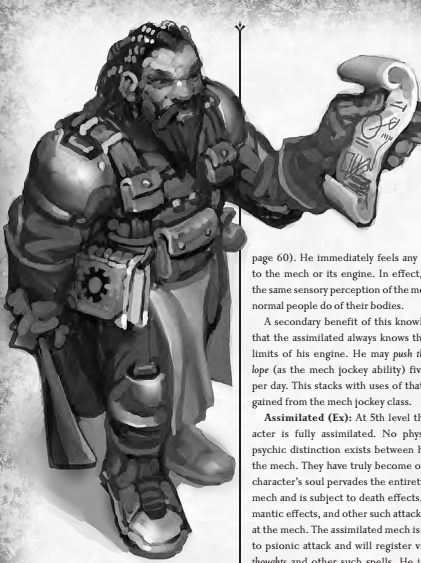
Gearwrights are the best of the best when it comes to steam engineering. They are members of the Gearwrights Guild and have access to information dating back to the first Age of Walkers, plus the superior resources offered by the Guild. However, they're quite exclusive. To become a gearwright you must, first, be a dwarf, gnome or human...and if you are a human, well, assume any numbers listed in this paragraph are 20% higher. You must have a Neutral alignment, Dexterity 16+, Intelligence 18+, and 10 ranks in Craft (Mechcraft), Knowledge (Mechs), Knowledge (Steam Engines) and Mech Pilot. You must also pay 500 gp per year in dues and be sponsored by an existing gearwright, and you have to swear loyalty to the Guild over everything else, even your family and friends, and pledge to devote all your efforts to expanding knowledge.
Gearwrights get a d4 hit die and Craft (Blacksmith), Craft (Mechcraft), Disable Device, all Knowledge skills, Listen, Mech Pilot and Spot as class skills. They get no proficiencies, but at level 2, 5, 8 and 11, they get proficiency with any one mech weapon of their choice. They get bad BAB and good Will saves. They also get access to steam powers, which stack with any steam powers they got previously, and add their gearwright levels to all Craft (Mechcraft), Knowledge (mechs) and Knowledge (steam engines) rolls, until 6th level. After 6th level, you get a different bonus - the first +6 to those rolls stays, but further levels depend on how you specialize. If you choose to be a repositor (academic), you get +2 per level past 6th to all Knowledge checks. If you are a maintenor (mechanical engineer), you get +2 to every level past 6th to Craft (mechcraft) and Craft (engineering) checks. If you are a cogulor (researcher), you get to just keep adding +1 per level to those rolls from before. Also, at level 1, you are considered to be an apprentice.
At level 3, and every 3 levels after, you can integrate two steam powers as per the coglayer ability. You also get the Craft Powered Mech feat if you didn't have it. At level 4, you are qualified for the rank of Journeyman, though you need to be actually promoted via RP. At level 7, you are qualified for the rank of full Gearwright and choose your specialization. You are also granted limited access to the Master Repository, and for each week you spend researching there, you get +1 to a Knowledge check, to a max of +5. At level 10, you are qualified for the rank of Junior Officer (though theire are never more than 20 per specialization at any time). Further, any time you could take 20 on a skill check related to mechs or steam engines, you may take 30 times the normal time rather than 20 times to take 30 instead. At level 12, you qualify for Senior Officer (of which there are never more than 10 per specialization) and at level 13 you are qualified to be a Master Gearwright, but there's only three of those total, and you only get the job if all three agree you should have it because one of them is retiring, which only happens about once every three centuries.
Honestly? The only real reason to take this class is if you're a coglayer that wants more steam powers, or the take 30 ability.
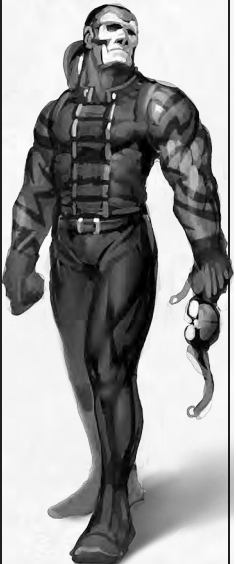
Mech devils are the most feared pilots, found only among the Irontooth Clans. Any attempts by outsiders to develop similar techniques have failed, and many claim they have some kind of supernatural or infernal influence - hence the name, though it's not true. The Irontooths have just claimed the name as a term of honor. Just about every mech jockey wants to become one, and at heart, most don't blame the ones who forsake their loyalties to join the Irontooth Clans to become one. To become a mech devil, you must have Dexterity 18 and Intelligence 16, 13 ranks of Mech Pilot, and all of the Mech Dancer, Mech Fu, Mechidextrous, Mechwalker and Natural Pilot feats. You must also be a member of an Irontooth clan, which you can join by beating a skilled Irontooth mech jockey in a ritual joust and then formally forswearing all loyalties to other nations. You must also find a master mech devil to train you, which you must pay for - about 2000 gp per year, minimum. You can't have any assimilated levels, because the Irontooths consider those guys to be bugfuck crazy. However, there is one way around some of the requirements. Monks of at least level 5 are automatically accepted into any Irontooth clan they want to join, and provided they meet the attribute requirements and take Mech Dancer and Mech Fu as soon as they can, they will be accepted as mech devils regardless of other prereqs, though they must reach them as soon as possible. These monks may also freely multiclass as mech jockeys.
Mech devils get a d10 hit die and Blanace, Bluff, Climb, Craft (Mechcraft), Escape Artist, Jump, Knowledge (Mechs), Knowledge (Steam Engines), Listen, Mech Pilot, Sense Motive, Spot and Tumble as class skills. They get half decent BAB on foot and good BAB in a mech, plus good Ref saves. They gain no proficiencies, but their 'unarmed' mech attacks deal bonus damage - +1d6 at 1st level and going up by 1d6 at 3, 5, 7, 9 and 10. This bonus applies only if the mech's hand has no weapon in it. Monks who join the class can also use their flurry of blows as an attack bonus for their mech at no penalty, which normal monks cannot do at all. Further, mech devils get new uses for their skills. For every 4 full ranks of Balance, they get +2 to resist enemy trip attempts (both on foot and in mechs). They may make a Bluff check against enemy pilots to remove any bonus to the mech's AC from the pilot's Dex (which is only gained from the Mech Dancer feat to begin with). They get +2 to climbing a mech if they have at least 4 ranks in Climb. They may use Escape Artist at half their normal skill ranks and with the mech's Dexterity to allow their mech to escape being trapped by weapons like hooked axes or barbed blades. They may use their Tumble skill to tumble between opponents in their mech (as long as it has Good or better maneuverability) as if they were on foot, except that the distance moved is half the mech's normal speed rather than 20 feet. Oh, and they add their mech devil level to all Mech Pilot rolls.
At level 2, they may use their knowledge of mechs and their function to stun enemy mechs with attacks to the joints, loose panels, the cockpit or other such areas. Once per day per mech devil level, they can make an unarmed stunning attack against a mech within 2 size categories of their mech, which must be declared in advance. If they deal damage, the enemy mech must make a Fort save of DC 10+(mech devil levels) or be stunned for around. The crew and passengers can act, but the mech itself can't no matter what they do, and it loses any Dex bonus to AC. Anyone attacking it gets +2 to their attack roll. At level 3, any mech the mech devil pilots that has Average or better maneuverability gets +1 to Reflex saves, which goes up by +1 every at 6 and 9. At 4, any mech they pilot gets their speed improved by 10 feet due to the mech devil's natural sense for terrain and mech movement, which stacks with the Speed Freak feat and any other boosts. At 6th level, the mech devil gets the benefits of the Improved Trip feat when making trip attacks with their mech, even if they don't meet the prereqs. At level 7, the mech devil gets the Deflect Arrows feat regardless of prereqs and may use it while in a mech, as long as the mech has a free hand or you're okay with damaging your mech's weapon. This works as normal except it's based on the mech's Reflex save. Further, they can learn Snatch Arrows with a feat choice without meeting any prereqs, and if they do, it works in their mech. At 8th level, any mech they pilot gets a +2 dodge bonus to AC.
Again: mech devils are just Better at mech piloting, to the extent that they're going to win against anyone not similarly superskilled.
Next time: Inexplicably, planeswalkers.
Some guys who can probably just leave, really
Original SA post Dragonmech: Some guys who can probably just leave, really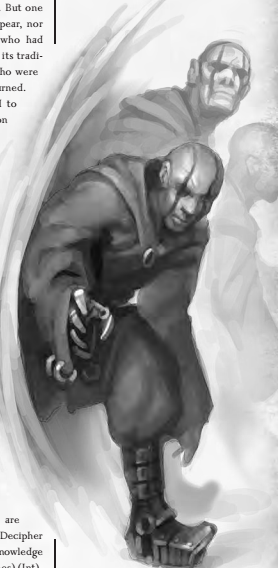
The riftwalker dates back to the early days of the lunar rain. Most people tried to hide in castles, then underground, and so on. That led them to eventually make mechs. Others, however, found another wy: planar travel. Some mages just left, others teleported with nightfall to the other side of the world. Most, however, established temporary beachheads on other planes, blinking their homes there when the moon rose and coming back at sunrise. Riftwalkers are those who specialize in this - mostly wizards and sorcerers, but a few others, too. The first known major riftwalker was Fasil of the Aurora Plains, who had been playing with the idea even before the rians began. He taught many students at a small school he named the School of the Aurora Walkers, but one day, neither his tower nor his school - or anyone in the - reappeared. Those that left carried on the tradition, at least, but Fasil's tower has never been seen again. Some say they went to another plane, wqhile others say they were found and destroyed by some extraplanar being. To become a riftwalker, you must have 5 ranks in Knowledge (The Planes), Search, Spot and Survival, and you must either be able to cast second level spells or use ki strike (magic).
Riftwalkers have a d6 hit die and get Concentration, Craft, Decipher Script, Diplomacy, Knowledge (arcana), Knowledge (the planes), Listen, Profession, Search, Spellcraft and Spot as class skills. They get no proficiencies, but do get access to a (rather limited) spell listthat goes up to 8th level and never gives them that many spells per day. Their main use for this is to channel their spell slots into opening dimensional rifts rather than casting spells, but they do get some wizard spells and a spellbook. They have half-decent BAB and good Will. Also, they have the supernatural ability to search for planar rifts. Planes are defined here as material, transitive, inner and outer, in that order, and the DC is 20 to find a rift between one-step planes, 25 for two steps and 30 for three. If you want to go between planes in the same group, like astral to ethereal or shadow, that's DC 20. This doesn't let you use the rift, mind, just detect that it exists. It takes one minute per five feet searched, and you can't retry or take 10 or 20. However, it's safe to assume a rift exists if you pass the check, as they are common (just hard to locate or use).
At level 2, a riftwalker can, once they have found a rift, expend spell slots to pass through it. A single-step switch requires two spell levels, two steps twakes four and three steps takes eight. You must sacrifice that amount of spell levels - so two level two spells is 4 spent, for example. At this point, stepping through a rift is a combination of standard action to sacrifice the spells and move action to pass through, and you can't bring anyone with you. You seem to just vanish through an invisible door. You have a 1% chance (at least non-cunulative) per riftwalk to arrive in an unexpectedly dangerous area, such as inside a solid object, in a lava flow or inside something's stomach. If this happens, you take 1d6 damage per step down the chain and are shunted back to the material. At level 4, you can now open the rifts big enough to have others go with you. You must spend as many spell levels as it took to open the rift in the first place, but if you do, one person up t Medium size can also go through. Double that for a Large creature, quadruple for Huge, and so on. The rift closes when you go through, so you have to go last. It takes a move action for someone else to pass through the portal, but you can move the portal itself with a Concentration check per round, moving it up to 20 feet per round. Doing this, you can actually envelop entire buildings.
At 5th level, it now only takes you one round tosearch a five foot square for a rift, and if you beat the Search DC by 5 or more, you find it fast enough to pass through it on the same round. At 7, you can now semi-shift yourself at any time, making a Spot check as a free action to find rifts that will let you walk through solid objects, at the same DC as the Search check for rift sensing. If you succeed, you may expend a single spell level to move up to ten times your usual speed in a single move action, and pass through any solid objects in the way as you do, as long as you can see your end point. You may charge at up to 20 times usual speed. You appear to flicker in and out of existence as you move, moving a great distance between flickers. You must physically touch at least one fourth of the distance for real, though you can use this to bypass threatened squares to avoid attacks of opportunity and so on. Also, you now halve the spell level cost to open rifts for yourself and others. At 8th level, you gain the rogue's Evasion ability, but as a supernatural power, as you subconsciously flicker into rifts as you get hit. You also get a constant +2 dodge bonus to AC for the same reason, which applies at any time you are conscious, even if you're flatfooted. If you fight defensively, the dodge bonus rises to +4 AC on top of the normal benefits. At 10th level, your evasion becomes improved evasion. Overall, it's neat but definitely very limited in what it can actually...do, so it isn't really any good. Especially if you got in via the ki strike option and have fewer spell levels to sacrifice.
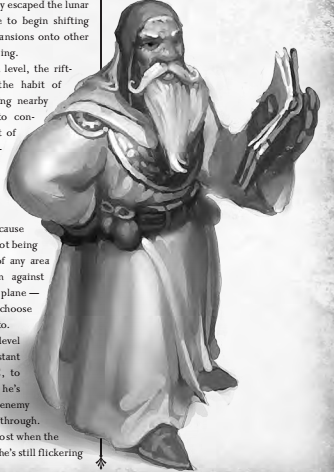
A steam mage is that rare person who studies both magic and coglaying. They aren't common, but they are able to learn how to synergize these two entirely seperate disciplines, mixing magic and machinery. They are, thus, much more dangerous to constructs and mechs than a wizard of the same power...but the cost is high to learn how to do magic through steampunk machines. You need Intelligence 16, Charisma 16, 8 ranks of Knowledge (steam engines), the Craft Steam Gear feat and the ability to cast 2nd level arcane spells. For this, you get a d4 hit die, bad BAB and a good Will save, a few steam powers as you level, and increases in your spellcasting every odd level. Also, at first level and every four levels after that, you get a free Item Creation feat. You may also make yourself a clockwork familiar, though as steam mages are not constructors, they don't have the College of Constructors' support and so it costs them a week and 500 gp to make it.
At level 2, steam mages gain the power to mix magic items and steam power devices, allowing them to augment their magical items with steam powers. (This makes steam powers much more formidable, as magic items actually have base effects worth a damn.) This takes the cost and construction time of both things and doubles them, and the end result is permanently fused, and can be modified only by being entirely destroyed and remade. At level 4, the steam mage can expend a 1st level spell slot to keep any steam-powered device fnctioning for a day, though each device requires a new spell slot. This can only be used to power steam powers, not regular steam engines. At 10th level, this power allows them to convert raw magical energies into heat, light and motion. This allows them to make magical engines of any kind via the Craft Wondrous Item feat, and also allows them to spend spell slots to power any engine, even a mech's. The bigger a mech is, the more spell levels it takes, with 5 at Medium and 5000 at City-mech F. Zero-level spells count as half a spell level. At least 20% of the cost must be paid up front, but the rest can be spent over the course of the rest of the day. (There's also a magic item, the spell furnace, that lets any caster do this.)
On the whole, the steam mage is...decent, but really there's no reason to stick with it after you hit level 2, when you get the actual good thing of the class: the ability to augment magic items with the steam power buffs that would let you, say, make an amplified wand of fireball that targets and fires itself independently.
Next time: A prestige class that decides by itself when you get to level it.
I love first levels that don't do anything
Original SA post Dragonmech: I love first levels that don't do anything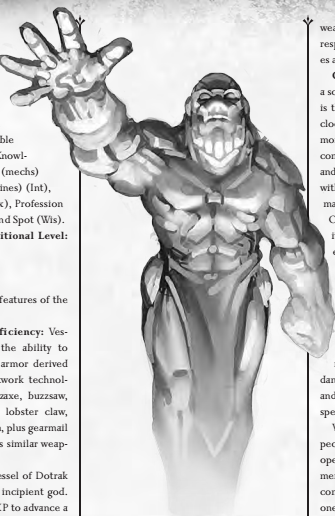
The Vessel of Dotrak is a really weird prestige class. The god Dotrak may or may not be real, but there's some evidence of its existence - the trak traks, which are animate piles of gears that wander around aimlessly, and these guys. These guys, being...more than random pile of gears walking around, are more convincing. They aren't true clerics and have very little control over their powers or growth as vessels, and they can't commune with Dotrak like clerics can with their gods, but their power clearly comes from somewhere. There are less than two dozen of them in all of Highpoint, and all are dwarves at present, but there's no reason a non-dwarf couldn't become a vessel. You do have to meet certain criteria to be chosen. First, you must be Neutral. Second, you need Int 16 ands Wis 16. Third, you need 10 ranks of Knowledge (Steam Engines). And last, you need to worship Dotrak. At that point, the DM must decide if you'll be chosen, based on how well you spread engineering knowledge, spread the word of Dotrak and serve the few principles Dotrak can be said to have. If you do, there is a 10% chance each time you level that you will, instead, gain the first level of this prestige class. But, you know, further levelling is not guaranteed. Whenever you have enough XP to level, you roll 1d6. If you roll less than or equal to your level in this prestige class, you gain a level in it. Otherwise, you get a level in one of the classes you had before this. At 6th level you may choose to advance in this class automatically, but once you hit level 7 you may no longer advance in any other class except this one.
Vessels of Dotrak have a d6 hit die and their class skills are Concentration, Craft (Blacksmith), Craft (Mechcraft, Disable Device, Heal, all Knowledge skills, Listen, Mech Pilot, Profession (Engineer), Spellcraft and Spot. They are proficient with all exotic weapons and armor derived from steam or clockwork technology and get half-decent BAB and good Fort and Will. They do gain divine spells, cast as a cleric in all ways...but received differently. There's no prayer or meditation - the spells just appear spontaneously at a different time every day. (If this is relevant, roll 2d12 to determine what hour they show up.) You may choose which spells you receive...but Dotrak's not a real god yet, and so there's a 10% chance each day that 1d4 of your spells are randomly selected instead. Your domain spells are never substituted this way. Your domains are Engines and Knowledge, because Dotrak, and your favored weapon is a metal quarterstaff. Also, at level 1, you have two spells total - one, and your domain one.
Beyond this, all you get at level 1 is your heart is mystically transformed into a clockwork device - beautifully made of gold, silver and steel, though no one will see it until you die. Its ticking is audible to anyone within 5 feet with a DC 10 Listen check. It cannot rust and is immune to spells that normally damage constructs and engines. Pretty much all it does is tick. At level 2, however, you gain the ability to rebuke and command constructs in the way evil clerics do undead. This works only on animate constructs that move of their own will, like golems or shield guardians, not mechs or anything piloted. This requires a holy symbol of Dotrak, which takes the form of a toothed gear inset with ornate gold and platinum scrollwork, which costs 300 gp to make. Also at level 2, your fingernails become hard and silvery aluminum. At level 3, your teeth are also encased in metal. Neither of these do anything. At level 4, however, your entire skeleton is turned to steel, giving you +2 Constitution and a bonus +2 to your Fort saves on top of that. At level 6 - remember, the last one you can take if you want to level in any other class - your eyes become metal orbs, your joints become sockets and your skin is a thin layer of steel with extreme tensile strength. Its appearance varies as you like, but it gives a +2 natural armor bonus to AC and cannot be removed any more easily than skin can. You are now vulnerable to rust abilities, just as steamborgs are, but you only take half damage if you fail the Fort save and no damage on a success, because a sort-of-god likes you.
At lvel 8, your skin begins to glow faintly silver. This doesn't do anything. At level 9, however, your body is now entirely wrought from clockwork and is in all ways a living construct. You are immune to mind-influencing abilities of all kinds, to poison, sleep, paralysis, stunning, disease, death and necromancy. You are also immune to crits, subdual damage, ability damage, ability drain and energy drain, and anything requiring a Fort save unless it works on objects. You cannot die of massive damage, but you can no longer go into negative HP - if you hit 0, you are dead. Period. You can be resurrected or raised, as you have a soul, however, and you do heal normally and still need to eat and drink. At level 10, you become a prophet of Dotrak. Once per day, with a touch, you may restore a damaged mechanical or clockwork device to perfect functionality, though you can't fix any magical problems with it. This works on anything from a watch to a citymech as long as the thing only has one engine. You don't clean or improve it or make it look nicer - it just works at peak condition. This can repair up to half of an object's HP lost in battle - the rest has to be repaired normally as the damage is nonmechanical. Also, you are able to meditate for 30 minutes up to three times a day before examining a device. If you do, you get a +20 competence bonus to any Craft (Mechcraft), Disable Device, Knowledge (Mechs) or (Steam Engines), Profession (Engineering) or other skill rolls to identify or fix a problem, or build something, as you are communed with Dotrak, the Great Engine. Last, once per day, you may as a standard action animate any pile of gears as a trak trak for 3d10 minutes. It will obey you and, when the duration ends, collapse back into a pile of junk.
if you were somehow to stop worshipping Dotrak, you would lose all spells and abilities of this class, revert back to normal flesh and be unable to gain any more levels in this class, ever. So...good job, idiot. You fucked up being a rather underwhelming cleric variant that spent half its time giving you a robotic cosmetic makeover.
Anyway, then we get the new skills. Craft (Mechcraft) is used to make and repair steampunk shit, especially mechs, and to salvage from same. Handle Animal has a note - clockwork rangers and only clockwork rangers - can use this to influence constructs and clockwork robots in the same way as animals, provided they aren't made to go against their programming. No one else can do that. Mech Pilot is not needed to just operate a mech - anyone can do that, though without an appropriate feat you can either move or attack in the same round, and without an appropriate feat or a class that gives you a mech BAB, your BAB is equal to half your normal BAB. However, you need to make Mech Pilot checks to remain standing on uneven ground, to board or launch from a citymech, to stand up once your mech has fallen and, if your mech can even do it, to jump or climb.
Now, on to feats. One feat of note is a new metamagic one, Combine Spell. See, Dragonmech has decided that normal spells can only affect 'creatures' no more than twice the caster's size. Combine Spell allows multiple casters to combine the same spell together to double some aspect of it - or for one caster to cast the same spell several times in succession for the same effect. Each use can double range, target size or duration - though this doubles arithmetically, so x2 twice is x3, not x4. So, say you want to cast Endure Elements on a Gargantuan mech and you're Medium - you need three castings chained together with this feat to do it, and all casters involved need to have this feat. So mechs are actually pretty decent against wizards...at the moment, anyway...because wizards have to slow their roll pretty damn hard to be able to hit a mech at all.
Beyond this, there's feats for making steamtech stuff, mechs, etc., feats to gain more steam powers, a feat that lets you avoid hazards in a gear forest (what's that, you ask? it's the engine room of a citymech, they're dangerous places), one that lets you worship one of the moon gods to be able to mutate your body essentially at random, kind of like Jivya in Crawl...and some I want to talk about, the mech combat skills.
Mech Dancer (Dex 13+, Mech Pilot 10): You add your Dex mod to your mech's AC, its trip checks, the DC to avoid being trampled by it, to its Reflex saves and basically all mech stuff that relies on Dex. Also, you can make your mech dance. This has no mechanical effects, you can just do it.
Mech Fu (Dex 15+, Mech Dancer, trained by the Irontooths): 1/round, you may use unarmed mech attacks to counter melee mech attacks. You must ready an action to do this, but if the enemy mech hits you, you make a Mech Pilot check vs their attack roll, and if you succeed, you take no damage and the enemy loses any further attacks or movement. If you succeed by 5 or more, you also deal unarmed attack damage to them.
Mech Rider (Dex 13+, trained by rust riders or anklebiters or make a DC 13 Wis and Dex check): You don't have to make Balance checks to hold onto a moving mech or attack while doing so. You can also make a ride-by attack while on it by delaying to its initiative or having it delay to yours, at any point in the mech's movement.
Mech Weapon Proficiency: Pick a mech of size Colossal 3 or less. You can use any weapons mounted on it, or any different-sized version of those weapons.
Mechanized Combat Practice (Dex 13+): You can use your normal BAB while in a mech rather than halving it and losing any extra attacks.
Mechidextrous (Dex 15+, Mechwalker feat): You can use two mech weapons per round, as long as the mech's construction allows it, though you get -3 to both atacks. This is just flat impossible for other people.
Mechwalker (Dex 13+): You can attack and move in a mech in the same round.
Natural Pilot: You increase the maneuverability of any mech you are in by one level.
Speed Freak (Mech Pilot 5): Any mech you pilot is 10 feet faster than normal.
Unnatural Pilot (Natural Pilot, can cast divination spells, worships Dotrak): You are a newtype. You can spend two levels of spell slots to get a Newtype flash, improving your mech's maneuverability by one level for this and the next round only, stacking with Natural Pilot, gain +4 insight bonus to AC and +4 insight bonus to oppose enemy trip attacks, falling or otherwise losing control of your mech. Activating this is a free action and can be used for as long as you have spell slots to sacrifice.
This is to give you some idea of what mech combat is like. It's...it's real slow. Things fall over a lot. Unless you really invest in mech piloting, mechs are basically rockem-sockem robots. Sometimes guys with swords hang onto their knees to attack people as they go past.
Next time: It's magic, you know. Never believe it's not so.
Stupid Robot Powers
Original SA post Dragonmech: Stupid Robot PowersFirst, the game introduces a number of spell variants for constructors and clockwork rangers, which basically take all of their 'talk to plants or animals' shit and replaces 'plants or animals' with 'robots'. Speak with constructs, Clockwork messenger, Hold construct, Gear stride (which lets you teleport between gears like tree stride), that kind of thing. The College of Constructors only accepts constructors, who need to pay 200 GP in dues per year. What you get for those dues is simple: you have access to all the new variant spells, to labs to make constructs in, to constructor-exclusive spells and to materials for the construction of clockwork familiars. Sharing any of the new or variant spells is grounds for punishment and possibly spellbook destruction. The labs are great - normally, you need a 500 gp lab to build golems and shit in, but you get access free in many major citymechs. Plus, working in a constructor lab reduces the cost of components and labor by 10%. Constructor-exclusive spells, never taught to any outsiders ever, are Animate gears, Clockwork double, Detect clockworks, Enginemaster's Grasp, Ironclad, Tick tock knock, Transpose spirit and Vanquish spirit.
Clockwork familiars are made by doing a familiar summoning ritual on a tiny robot. It is given life, and acts exactly like a normal familiar, with all the normal benefits and the normal drawbacks when it dies. However, it is a construct and so has all construct immunities, but cannot be healed - only repaired, for 2 gp per 1 HP restored and taking 10 minutes per HP restored. It has darkvision, gets a +2 natural armor bonus on top of the normal familiar bonuses and it can speak with intelligent constructs rather than animals of any kind. So...that's...worth it...?
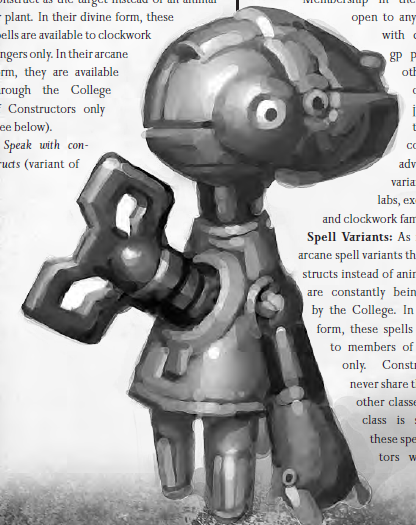
We also get the Engines cleric domain, exclusive to Dotrak and his chosen. Its special power is that once a day, you can cause or cure 1d6 damage per caster level to any single construct, mech or other engine-driven thingy you touch. Very impressive, I'm sure. For new spells, the only real standouts are...
Animate Gears (Constructor 5/Clockwork Ranger 4): You make a pile of gears turn into a humanoid mass of angry metal that is basically a zombie.
Ironclad (Constructor/Clockwork Ranger 5): You temporarily turn someone into a robot that is super tough to hurt.
Rebuild Soul (Constructor/Cleric 4, Wizard/Sorcerer 5): You reincarnate someone as a robot, permanently.
Tick Tock Knock (Clockwork Ranger/Constructor/Engines Domain 3): You disrupt physics inside a relatively small machine, stunning it for quite some time if it can't make a Will save, which most robots can't.
Transpose Spirit (Constructor 7): Shove an elemental spirit into a golem to make it break temporarily.
Anyway, let's talk Steam Powers. These are what coglayers and a few other classes get to mess with, and they aren't magical in any way, though a few require magical components to create. They all require a steam engine, however, and water to keep it running. Steam powers, unlike spells, have no levels. Instead, they are constructed from parts. Say you want to make a flamethrower. First, you start with the Pilot Light, which is basically a tiny torch that lights up a small area and can deal 1d4 damage and maybe start some fires. Then you attach a Pump, which lets you shoot the fire effect up to 20 feet. Now you add an Amplifier, boosting the damage to 1d6 and making it easier to set shit on fire. Then you add a Billows to make the damage effect a cone spread. And this is all extremely diverse and cool and kind of stupidly complicated...
Except that it's all based on the base effects. You can make some really great utility stuff here - a walkie talkie, a telephone, a TV that shows you what's going on a mile away. You can give yourself a robot arm that is able to tell friend from foe and will automatically attack people with the sword you gave it to hold. That's all jsut fine. But see the flamethrower? All the amplifier does is raise die sizes and areas of effect. You will never go above, say, 1d20 without a lot of cash. Of course, once you get past that hurdle you'll be rolling multiple d20s, but that's gonna take you lots of cash and most of your steam powers. Meanwhile, your mage friend is rolling like 5d6 with his wand of fireball. That said, you can get some really crazy utility stuff going - and if you're doing a steam mage and can combo magic items and these parts, well, the sky's the limit when it comes to making wand-based murder machines. What parts do you have to work with?
- Amplifier: You take any input that gives energy and boost it by one increment of its base value - if something had range 50, it's now range 100 with one amplifier, 150 with two, etc. If the effect causes damage, it increases by one die size per amplifier. The DC of any saves goes up by 2.
- Animator: A steamwork brain that can allow a device to move on its own to perform a specific but open-ended function, such as 'fight in melee' or 'shoot things' or 'pilot a mech.' However, the rudimentary AI can't, say, tell friend from foe on its own. You need another power for that.
- Automater: A device that performs a simple task on its own, such as 'reload a crossbow' or 'polish armor' or 'pick up a dropped object'. It isn't needed if you're making, say, an automaton that can already move on its own, but good if you want an autoloading crossbow. What task it does is determined when you make it, and that's all it will ever do.
- Billows: Turn a normal attack into a cone with a range equal to its previous edge, and width at its farthest point equal to its raneg. So, say you have a light that hits 20x20 square. Now it's a cone with a range of 20 feet.
- Blood Pump: A device that can fuel a steam engine with blood instead of water, and can slowly drain HP from someone or function as a particularly macabre artificial heart. They're illegal in most places.
- Boiler: A device that doubles the physical output of another effect. It can lift twice as much now or hit twice as hard, say. Like the Amplifier, all increases are based on the original effect.
- Cauterizer: A rudimentary healing device that restores 1d4 HP, but can only be used on a given target once a day. It can stack with itself for multiple dice, but each additional Cauterizer makes it take one turn longer.
- Clockwork Puppet: A Tiny-size robot. Use two for Small, four for Medium, eight for Large, etc. It can't go over Huge. Unless given an Animator, it will just stand there; after that, it can mimic people if operated via its control box. Adding a Discriminator and Voice Command lets you tell it to attack stuff.
- Darkness Generator: Produces a 20x20 field of darkness centered on itself (barring a Pump or whatever). Dispel magic can't get rid of it, but darkvision works in it and a Light Generator can cancel it out.
- Dehumidifier: Produces half a pint of water every hour by pulling moisture from the air, or double that in rainy conditions, or half that in dry conditions. Extremely dry areas reduce it to a quarter but it still works.
- Descrambler: Shove it in a lock and it will pick the lock in rounds equal to the lock's DC, as long as the lock isn't magical.
- Discriminator: A steamwork brain that allows a device to make basic categorical decisions, such as determining friend from foe. It has effective Int 1 and, without an Animator, can't make anything actually do stuff without direct commands.
- Drill: A foot-long steel drill bit that is two inches wide at the base and can drill through six inches of stone per round and deals 1d4 damage, doubled against grappled foes. Adding more doubles all those values each time.
- Fin Apparatus: A device that can steer aerial or submarine vehicles or direct energy, such as making our flamethrower fire at a right angle. Adjusting the fire pattern is a free action once per round. Additional fins can make more complex patterns, like an S shape for two.
- Flywheel: Double the movement speed of whatever it's attached to. Can't be used more than once.
- Fog Generator: Make a 15x15x10 cloud centered on the device, expanding at 5 feet per round if you keep it going. It obscures all sight, even darkvision, beyond 5 feet and disperses in 1d4+1 rounds in normal conditions. It can be used four times before it runs out of water, and holds a gallon of water in its tank.
- Folder: A device that folds up another device, reducing its size by one increment but rendering it unusable while folded. And yes, if you stack more of them together, it shrinks thinks even more. Add enough and you can store your mech in your pocket.
- Force Generator: Creates a force barrier up to ten square feet in area in whatever shape you like as a full round action. The force field can float up to 3 feet off the ground and functions as per the spell Wall of force, except that it only takes 20 damage to puncture and has AC 10 and 10 Hardness. It can be used in combat to gain cover as per a large shield. You can't float the generator on the force field.
- Identifier: Can identify any nonmagical, natural substance as if it had 20 ranks of the appropriate Knowledge skill, as long as it has an ounce of material to destroy.
- Imagemaker: Can produce or transmit silent images with a transmission and reception range of 5 miles on a clear day without obstructions, or a mile or less underground or in a mech.
- Iron Arm: A big robot arm with Strength 18 and Dexterity 8. It has Hardness 10 and 20 HP, and can attack for you. (If you use a Discriminator and Animator on it, it can attack on its own each round, so you get a free extra attack.)
- Iron Jacket: A mechancial exoskeleton for Medium or smaller creature, giving +2 AC, but a max of +1 AC from Dex and a -4 armor check penalty. It can be locked in place with a switch on the back to restrain people.
- Light Generator: Illuminates a 20x20 area centered on it. Can be used to blind people if mixed with a Pump and Amplifier.
- Lobber: Turns an attack into an exploding glob - so a Pilot Light becomes an exploding fireball. The attacks have a burst radius equal to the attack's normal area and a range increment of 30 feet.
- Metal Ear: Can detect noises. If combined with a Wavemaker, can transmit what it hears.
- Metal Legs: Robot legs good enough to support up to a Large creature of no more than 1000 pounds.
- Noisemaker: Can record and play up to one hour of noise on storage units similar to a CD.
- Nozzle: Lets you swap what output source your device is using as a free action.
- Optical Orb: A glass eye that can see things but is easily broken.
- Pilot Light: Produces a small flame that illuminates a 5x5 area and deals 1d4 damage, but can't ignite a target unless it stays still for 2 rounds and has enough fuel to be fired 10 times. If the fuel source is ruptured it will explode, but requires a specific piercing attack, a long fall or extreme heat to rupture.
- Pump: Fires an input out in a line to a maximum range equal to the input's total area divided by 5.
- Ranger: Gives a +1 enhancement bonus to ranged attacks against targets more than 20 feet away. Does not stack with itself.
- Rotor Arm: A 5-foot steel rod that rotates at speed. It can be used to get a +1 shield bonus to AC or to attack the two corner squares in front of you for 1d8 damage, but no the square directly in front of you. Any attack made by a rotor arm automatically hits both those front corner squares without any penalty. If pointed upwards, it also produces 40 pounds of lift at a speed of 40 feet and clumsy maneuverability.
- Scanner: A detector that can detect any purely physical quality, such as 'is an elf' or 'is a dragon' or 'is made of gold.' It displays approximate location within 100 feet and approximate quantity. The thing detected is determined at construction and can't be changed.
- Spark Generator: Produces a steady electrical current that at its highest setting can deal 1d4 subdual damage and gets a +2 circumstance bonus against metallic creatures or people in metal armor. If amplified, it first becomes normal damage, then goes up to 2d4 or 3d4 or whatever rather than increasing die size. Its range on a pump is 5 feet.
- Targeter: Automatically acquires a target for a weapon. Without a discriminator, this is always the nearest creature. With one, it's the nearest enemy, and with a scanner it will target the nearest scan result.
- Translator: Translates sound from one lanague to another, both chosen at creation.
- Voice Command: Can detect its owner's voice at 5 feet, or 30 feet with a shout and allows verbal operation of controls. Will only respond to the owner's voice, determined at creation.
- Wavemaker: transmits and receives sound via radio waves within 5 miles on a clear day, or a few dozen yards underground.
Figure out your own combinations! For added bonus, use magic items as a steam mage! It can get real stupid. And remember: order of operation counts. If you have a light source, pilot light and amplifier, it matters which you connect the amplifier to! The big limiter is that each part has a GP cost, a construction time, sometimes some esoteric components you need, and sometimes some assistants to help construct it. Oh, and how many steam powers you are capable of maintaining at once.
Next time: Religion, death and robots.
Elf Atheism
Original SA post Dragonmech: Elf AtheismThe religion section actually doesn't cover most of the actual religions of Highpoint - they get covered in other supplements. It just notes that most older faiths are broken. The disaster of the lunar rains has had people questioning their faith for a solid century. The gods do still exist, and still mostly grant their power to their clerics, but there's some solid reasons they couldn't stop the apocalypse. Firstly, physics. Altering the moon's orbit is far more than any one god could do. If they had all worked together collectively, it might have been possible to prevent the lunar rain...except there was a second reason: the lunar gods. The creatures of the moon have their own pantheon of gods, strange and otherworldly as they are, and those gods welcomed the invasion. It gave them a chance to escape the moon and find even more worshippers below, expanding their influence. They used the power gained by the moonfall to attack the old gods and slowly overwhelm them. The battle between the gods is what saps the strength from clerics, and the bickering earthly gods were too disorganized to work together properly.
A lot of people have become atheists, rejecting the gods and their faiths because the gods did not protect them properly. They believe in the power of machines and hard work. Why worship gods when you are building demigods with your own hands? There's also been a major rise in cults, ranging from the Regenerators who seek to bring life back to the surface of Highpoint to the cult of the treants of Lilat, who have been driven insane by the devastation of nature and now call themselves the forestrati, devouring the flesh of dragons and attacking anyone who gets too close. Others seek answers by studying the world, trying to understand why water works the way it does and why steam engines came along when they did, claiming that Dotrak, dwarven for 'the great engine,' set these things in motion and then sat back to watch the world. As yet, no one has proven that Dotrak actually exists. He has no churches or clerics - only his vessels. His worshippers tend to be pretty agnostic gearwrights. He has no myths, no legends - he just set the gears in motion. Other faiths scorn the Dotrak-worshippers because Dotrak, if he even exists, is clearly weak and lacks power.
The truth is that Dotrak does't quite exist yet. He will, and soon. The steam engine is a new thing, and the collective energies of the gearwrights who make them and believe in them has created a consciousness, an embryonic deity - at the moment, little more than a thought dancing through the world and slowly gaining power. This is Dotrak, and it does create the trak traks and the Vessels. He will continue to grow and, should he get enough followers, become a true deity. He is neutral, and while he lacks the power to grant spells to clerics, his domains are Engines and Knowledge.
Andakakilogitat is the lunar god of dragons. He is Chaotic Evil, and his name is spoken only in chants by the lunar dragons that worship him. He has many titles - One-God, Black Death, Enemy Watcher. He is depicted as a twisting mass of limbs, wings, dragon heads and so on. His symbol is an asymmetrical swiling pattern of dragon heads, and he is the only being that lunar dragons acknowledge as more potent than they are. Some earthly dragons have begun to worship him in the hopes that he will help them survive. He has wanted to take Highpoint for his own for millenia and has no care for the mortals that live there - they're just things to conquer. His domains are Chaos, Destruction and War.
Erefiviviasta is the lunar goddess of flight - goddess because her appearance is slightly more feminine than her peers. Sexes in lunar creatures aren't really...a thing, quite. A few lunar dragons follow her, but most have turned instead to her rival, Andakakilogitat, who was once a dragon but became a god. They are bitter rivals, but have put aside their differences for now in favor of attacking Highpoint and supporting the conquest by the lunar dragons. Her domains are not listed.
Seroficitacit is the lunar god of change. It - definitely it - is a pulpy mass of evershifting flesh. It has no symbol - each follower is expected to make their own. Many of the lunar races worship it, at least in part, but there is no cohesion or unity - even to the extent that anyone can understand unity among lunar beings. They seem to oppose tradition, and the god seems to gain power not from the number of worshippers, but from the changes its worshippers undergo. Since the rains started, it has grown steadily more powerful, and even some terrestrial creatures worship it now, thinking that the time of change has come. It also has no listed domains.
In addition to cleric stuff working weirdly in Dragonmech, so does resurrection. The gods feel that mortal souls after death are needed for their war on the lunar gods. Thus, they aren't eager to let them go back. Any attempt to resurrect a dead person by any means requires the raised character to make a Will save. The base DC is 10, but any cleric or paladin levels are added to the DC. If the save is made, the character returns to life as normal. If failed, however, they have been conscripted by the gods for service. They can never be resurrected by any means, and their soul is beyond any mortal reach.
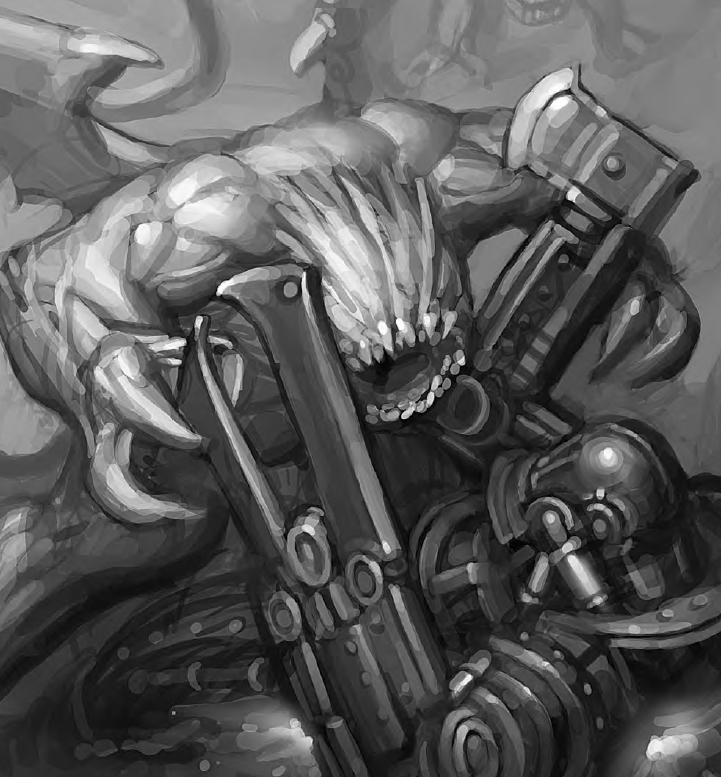
Now, let's talk mechs. The real origins of mechs are long forgotten. The First Age of Walkers is entirely a mystery except in a few fragmented records and artifacts held by the Gearwrights Guild or the elves. Parilus spread the knowledge, and now mechs are everywhere. Even the orcs build mechs - hell, even some underdeep cultures are doing it, on a smaller scale. Mechs exist both to protect against the lunar rain and its creatures, and to keep moving. A castle that is sieged by a dragon either falls or starves - a mobile citymech, however, can find supplies for itself. The steam engine is the key, and since magic existed, at first no one thought much of them. Magic could make much better stuff. However, Parilus demonstrated that steam engines, long used for minor work by the dwarves, could efficiently be used to power much larger vehicles - larger than dragons, enough to match even the best magic. Now, there was a weapon that could fight lunar dragons, when before it had taken entire siege forces or potent mages. Now, a mech could just carry a siege weapon with it, or use giant axes or such at close range. One dwarf in a mech could do more than an army against a dragon, and could be trained in a tenth of the time a mage needed to become powerful. Early mechs were primarily wood and stone, with iron frames. Now, steel, adamantite and mithral are used. Humans prefer iron, and elves use magically maintained living trees. Some mages have made immense hollow golems, and some necromancers even make mechs out of corpses and dragon bones.
Most mechs are only brought out for patrols, raids and battles. After that, they return to their hangars in a city or citymech. Mech jockeys are invariably aggressively competitive, though they vary by race on other issues. Different forces often spawn terrible rivalries between opposing jockeys, who remember every detail of the enemies they face off against and will often go out of their way to get rematches. While no one officially allows these grudge matches, most groups look the other way when they happen on the field. The citymechs, meanwhile, sustain entire populations. Most of that is crew, support personnel and military, but there's a growing wealthy aristocracy that bribes its way onto citymechs, despite the fact that officially only 'useful' people can get on. They are the safest places to live in Highpoint right now, and in the early days, the rules about living there were strict. Crew first, then military, with only useful civilians getting on - blacksmiths, say. Traders were allowed only briefly. The Stenians and Legion are still pretty strict about this kind of thing, and miners, bankers and other specialists not useful to the citymech are going to be rare among them. They exercise martial law to enforce order on their citymechs, to ensure smooth functioning even when it's cruel.
However, residency has gotten less strict even there. The citymechs are no longer in constant siege mentality. 'Nonessential' residents are now just required to pay rent each month to prove their 'use'. It's like living in a big metal condo. Many thieves' guilds have sprung up to take advantage of this new laxity, controlling black market 'land' ownership and getting stowaways aboard. Daily life is much like in old surface cities, but more cramped. The best places have ended up being those at the top of the mechs, with common areas and peasants in the middle and criminals and poverty lower down. The legs are usually ghettos of the poor and menial laborers. Below these are the gear forests, the massive engine rooms that power the citymechs. The 'depths', as the feet and shins are known, vary wildly between citymechs. The better-built ones, usually Stenian or Legion, might have guard posts or mech hangars. The more advanced Gearwright citymechs often hold entire mech fleets. Others, such as Irontooth or orc mechs, intentionally leave these areas open for settlement and seal them off from the rest of the mech, allowing stowaways on baord to fight each other for the space. Some get filled by monsters or bandits. It's terrifying for those on levels near the depths, but it makes those mechs much harder to board, see. The depths inhabitants fight boarders off. Orc mechs are especially notorious for this, and unruly slaves are often sent to die in the depths.
Next time: I'm a pilot and so can you.
My Giant Robot Is A Clock
Original SA post Dragonmech: My Giant Robot Is A Clock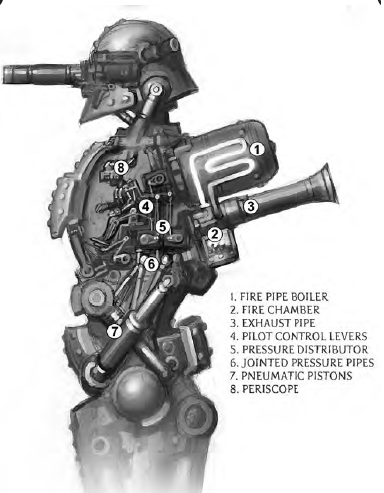
Being inside most mechs is dark, with the exception of the cockpit, firing ports and anywhere right next to a porthole. Dwarves tend to leave them pitch black, but elves use magic to light them up and humans use gas lamps and torches. Citymechs have room to walk, but other mechs are more cramped, with little room to stretch out or move. Staying armored in a mech is painful - it chafes - and requires a DC 15 Fort save to avoid having to remove the armor...if it isn't plate, which takes more space to remove than exists. Keeping the armor on anyway causes 1 subdual damage per day. Normal mechs also move around in really jerky, jarring ways. The first time a character rides a normal mech, they need to make a DC 10 Fort save to not be nauseated for 1d4 hours and get a -1 to all rolls for a day. The controls, at least, are simple enough to learn, though. One lever for each leg, push them forward to make the leg go forward. The trick is just timing the levers and not falling over. Learning all the tricks is harder than it sounds, though, as it involves matching stride lengths properly and figuring out how to turn, among other things. Weapons are usually controlled by large joysticks that move the arms, to swing or aim, and then, if a ranged weapon, a button to fire with. This is part of why it's so hard to move and fire at once - there's too much to do. Advanced mech jockeys learn to mod their cockpits to better allow for multitasking, such as using a specially made bar to control both legs at once. It takes training to use properly, of course, but it's like the handlebars on a bike, really.
Steam-powered mechs also take lots of water and fuel - usually wood or coal. Most are designed to suck up water from rivers through their feet when they can, and often have built-in pulleys to load fuel. Other types of mechs typically do not require fuel, which makes them easier to maintain. Communications between mechs varies a lot. Elven mechs typically use magic items or spells to allow telepathy, while dwarven citymechs or especially large mechs use steam powers such as wavemakers. Others rely on signal flags, with signals varying by race and faction. (Orcs, infamously, have only three: attack, stop and retreat.) It's usually easy to tell at a glance which race made a mech, just from design and aesthetics. Beyond that, they usually fly a flag or paint a coat of arms on to declare allegiance, and smaller symbols are painted on to declare unit and any personal insignia of the pilot. There are also a few universal flags. A mech flying a sky blue flag is a merchant's, for example, and will usually not be shot at before questioning.
Mechs are generally classed by power source into five types: Steam-powered, man-powered, clockwork, animated and undead. Steam-powered mechs are the most common, and were the first ones built. Dwarves and humans favor them, and they're known to be durable and rugged if a bit slow and requiring a lot of maintenance to avoid mechanical problems. Man-powered mechs are more primitive, relying on human labor to make them move. Typically, that means dozens or hundreds of slaves on treadmills or manning gears. Orcs are the only race that regularly uses them, and they're slow and prone to slave revolts. Clockwork mechs are the peak of craft, made with extreme precision. They require winding every few days, but otherwise they run on their own power as the spring within uncoils and keeps the rest of the mech moving. They are rare and mostly owned by very good gearwrights. Animated mechs are essentially hollow golems, but rather than being self-motivated, they are designed to obey their pilots. Only the elves make regular use of them. They are easily the fastest, most agile of any mechs, but they have one fatal flaw: they can be taken down by coordinated dispellations, and the dwarves are learning how to make use of that. Undead mechs are quite rare, and rumored to mostly be made of zombie dragons. Little is generally known about these creations, which no nation fields.
Mech stats are somewhat different than those of creatures. All mechs have d10s for hit dice and always get 5.5 HP per HD. Their AC is generally so low that it's impossible to miss one, but they rely heavily on Hardness for protection instead. They also have 'critical thresholds' - divisions of HP which, as you get to the lower ones, make the mech more likely to take crits. These cause not just extra damage but also system failures. Every mech has four thresholds: green, yellow, orange and red, divided at various intervals depending on the mech. Mechs often have quite a few potential attacks but can rarely use all of them at once due to crew requirements. Mechs can make Fort and Ref saves but have no Will save, and their Ref save is usually negative. They have Strength and Dexterity but nothing else. In addition, they have a new stat: Payload Units. These determine how much space the mech has for...well, anything. Weapons take up PU, crew take up PU. Living space takes up PU. A Medium creature or weapon is 1 PU, and living space for a creature is at least equal to its PU - usually double that, for better living conditions, and even that's cramped. A mech stored aboard another mech takes up PU equal to twice its own PU, and 1 PU is also enough space for about 216 cubic feet of cargo (or 1000 pounds). Mechs also have crew requirements, with steam- and man-powered mechs often needing quite a few crewmen to keep them going. They also will have a number of firing ports to allow crew to shoot normal weapons through, plus a size and a maneuverability rating based on that size. Smaller mechs are more maneuverable, and larger ones are less. Man-powered and undead mechs have a penalty, while clockwork and animated mechs have a bonus. They will also have a rating for how far they have to move to be able to turn, and how much they can turn in a round, as well a modifier to trip attempts on the mech. Different mech types also use different crit tables. Basically, when a mech is hit by a crit, you roll percentile dice and check on its appropriate table, with the column for what crit threshold it is currently in.
Steam-powered mechs, by default, are big, noisy and hot. They hit Yellow threshold at 50% HP, Orange at 25% and Red at 10%. 25% of their PU must be taken up by crew - usually a jockey and a few gunners on a smaller mech, or a commander, lesser pilots, a navigator, engineers and gun crew on a big one. Crit effects range from 'lose some Strength until repaired' to 'lose use of one arm' to 'everyone on board has a 50% chance each round to take 1d3 damage from steam' to 'the boiler explodes, the mech is on fire and everyone on board is taking damage'.
Man-powered mechs are still noisy, but that's drumbeats rather than engines. They hit Yellow at 60%, Orange at 35% and Red at 20%. 50% of their PU must be taken up by 'crew' - usually slaves. All they do is power the mech, they aren't pilots or gunners. The rest of the crew is in the other 50% and is determined by the mech's arms and needs. Most of their crits are 'shit breaks, lose a limb' or 'damage random crew' but also include 'the mech attacks things randomly for a few rounds' and 'the robot begins to collapse on the crew'.
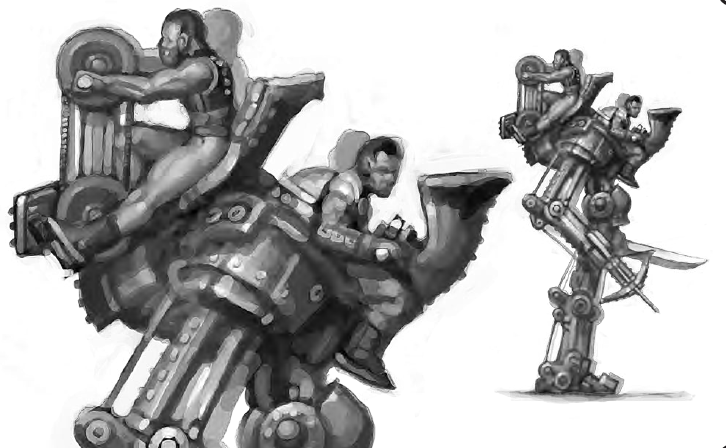
Clockwork mechs are smooth, sleek and actually quite quiet, apart from a minor humming or purring noise. Once a week, they need to rewind themselves, usually via an internal steam engine. The only real downside is that they're fragile - while they're tough, they have pretty bad Fort saves. They hit Yellw at 50%, Orange at 25% and Red at 10%. Only 10% of their PU needs to be crew, minimum 1. Their crits are usually broken gears causing nasty debuffs, damaged limbs, or 'gears explode and damage crew.'
Animated mechs run on magic and, in theory, could be made of any material. In practice, they're elven and made of wood. The larger ones resemble treants, while the smaller ones usually incorporate mithral or adamantine and look more artificial. Unlike mechanical mechs, they suffer no critical hits at all, having no engines or motors to damage. Only 10% of their PU needs to be crew, minimum 1.
Undead mechs are put together from a number of corpses. They are hideous, ugly and smell terrible. A necromancer rides inside to control them, and usually they also contain a small force of undead servants. They resemble gigantic zombies and are mostly hollow. They are silent, but their smell is clearly noticeable far before they are seen. They never require more than a single crew member - the animating necromancer. Any other crew is entirely optional. Like animated mechs, they are immune to critical hit effects - and, indeed, critical hits in general.
Next time: Mech loadouts and building a mech.
Making a robot
Original SA post Dragonmech: Making a robotBefore we get to construction rules, we learn that mech armor doesn't give AC, because that's based on mech size and you can't really miss most mechs. Rather, their armoring gives them Hardness, determined by what they're made of. Flesh is Hardness 1, clay is 3, wood is 5, bone is 6, stone is 8, iron is 10, steel is 12, mithral is 15 and adamantite is 20. HOWEVER, if you mix your armors, you have to figure out what percentage is what, because your Hardness is the weighted average of those types. So 25% mithral and 75% steel is (12*.75+15*.25), or Hardness 12.75, which I believe rounds up to 13. Anyway, mechs have a 'standard' profile for their size, which is the default stats for a mech that size, but you can customize it after this. However: you can never have an attribute that is more than a mech one size larger or less than a mech one size smaller. So, base Colossal Strength is 30. It can't have Strength less than 26, the base Gargantuan one, or greater than 34, which is Colossal II. Lower means it can't support its weight and higher would require enough machines to make it the next category up. However, beyond that limit, just about every stat can be modified by crafting. You can also add special traits, like extra armor plating (to get more Hardness but less move speed), combat spikes to boost unarmed combat, weapon mounts to have more combat options, faster legs, whatever.
So, let's start making a mech. Ultimately, success or failure comes down to a Craft (Mechcraft) roll...but the GM rolls it and won't tell you the result until after you spend all the cash and time building the thing. Fail, and well, too bad, so sad, it's fucked and will never work, despite doing the roll before any construction begins. See, the first step is planning. You decide what power source and size you want. (The man-powered mechs are easiest to make, followed by animated and undead, then steam-powered, then clockwork.) We'll go with a Gargantuan steam-powered mech, DC 36. The design takes (DC*2-your Craft ranks) days to complete, and the GM makes the roll to see if your design is shit or not. But once you have a good design, you can keep using it for as many robots as you want to make, though you can only build one at a time because the designer has to be on-site to oversee the construction.
That's when we begin factoring in labor requirements. We have 1920 man-hours of work to get done. Depending on how skilled our laborers are they give different amounts per day. Your average guy who can lift heavy objects can give 8 man-hours a day, while a basic (Profession (engineer) 5) skilled worker gives 10. 10+ ranks can give 12, and 15+ gives 14. Nonsentient undead give 12 man-hours per day, and nonsentient constructs give 30. However (ignoring the zombies and golems) the more skilled cost more - it's 1 sp/day to hire a rando, but 1 gp, 2 gp and 3 gp respectively for engineers. You also need one overseer per ten workers (or fraction thereof) if they're intelligent. Without that, each group of 10 with no overseer is working at 75% efficiency. However, the game assumes you can find an overseer in any random group of tend people, so really it's just the fact that they cost 3 sp extra per day each. The game also assumes that any population of laborers will have no more than 10% engineers and 1% experts.
Anyway, we take our 1920 man-hours, divide by 8. We will need either one worker going at it for 240 days, 2 for 120 or up to 240 workers for one day. Let's say we have ten workers, all average, and one overseer. So that's 13 sp per day of work, for a total of 24 days of work. So 31 gp and 2 sp in labor costs alone. However, every mech also has a materials cost. We're going to add combat spikes (+10% base cost for +1d6 to unarmed damage) and Fast Legs (+5% base cost for +10 feet to combat speed). The cost and man-hours of a mech, incidentally, are again a function of size and power source. Man-powered and undead are cheapest in both (actually, undead just need corpses, not cash), steam-powered and animated are middle, and clockwork is the most. So, our frame cost is 1200 gp. Applying armor to the frame we've just made is done next - the man-hours are built in, but not the cost. Steel armor for a Gargantuan mech is 200 gp. Add those together to get base cost - 1400 gp. Now it goes up by 15% for our mods. So, 1610 gp. Then we add the cost of any weapons we want to give it, but fuck it, this is a kung fu mech and doesn't have any. Then we can do incremental improvements.
Incremental improvements let us increase or decrease the stats, and my god the formulas are insane. Okay, first, you take the labor cost and man-hours of the mech and divide both by 6. Then you take the difference between the new stat and the standard for that size, noting this as the nonstandard difference. Then you take the difference for the standard for your mech's size and the standard for the size above or below it depending on which way you're modding. That's the standard difference. Then you divide the nonstandard difference by the standard difference to get a percentage. You take that percentage and multiply it by the number we got the first step. That is the cost in GP and man-hours. Also, you better have planned this in the planning stage, because it alters the DC of construction to be the average of the standard mech and the one above it (for improvements). If you deliberately build in weaknesses, the DC remains the same.
Anyway we take those numbers if we wanted to do those stat changes and add them to our number from before. And that's our final cost and time for construction. Then we add a fixed cost for robot type - in the case of steam-powered, 2000 gp. So our final cost is 3200 gp for our steambot. Jesus, that's complicated. But if you were making a magical mech you're not done! To do that, you need to cast geas/quest and polymorph any object on the thing, and either limited wish, or if it's a full citymech, wish. Then, you spend between one and fourteen days on the ritual to animate it. And unless you spend 30,000 gp extra on it, it's weak to dispel magic casting. (The 30,000 gp actually makes it immune to all direct magic.) Necromantic mechs are similar but require a different set of spells to animate them.
Then we check our mechcraft roll. If it succeeds, the mech works. If it fails by 5 or less, it doesn't work but a new check can be made by spending a month working and 20% of the cost. Fail by 6 or more and you have a very expensive lump of materials and have to start over entirely. You can take 10 or take 20, but doing so makes construction take 10 or 20 times as long in all phases.
Modding works basically the same as making a new mech, but is faster. If you want to remove a thing, it costs a third of the base price to install it. Mechcraft rolls are usually not involved for mods, at least. However: a mech cannot have its size increased, and the only power source change can be downgrading it to man-powered.
Next time: Now make it fight.
Let's You And Him Fight
Original SA post Dragonmech: Let's You And Him FightSo, mech fights. It's pretty similar to normal combat, but not entirely. Destroying the enemy mech is definitely possible, but they have huge piles of HP and plus, a broken mech can't fight lunar monsters, so it's rarely the goal. Capture or disabling is just as viable - tripping mechs, tangling them up, boarding and killing the crew, those are all viable tactics. If you have to destroy the enemy, though, you're in for a slugfest until you get their crit threshold down enough that you can break something important.
Mech derived stats are also different. Initiative is the mech's Dex mod (usually negative) plus the pilot's Dex mod, plus any relevant feats. AC is 10 plus the mech's size mod (always negative), and only adds the pilot's Dex in if they have the Mech Dancer feat. The mech's Dex is never involved. Mech melee bonus is the Mech's strength mod plus the mech's size mod plus the gunner's Dex mod plus the gunner's mech BAB. Mech ranged is the mech's Dex mod plus the gunner's Dex mod plus the gunner's mech BAB. As you can see, it's way easier to land a hit than to miss. Also, remember - without a feat, you can either move or use a mech weapon in a turn as a pilot.
Mechs also require fuel. A Huge steam mech requires one ton of coal per 24 hours of continuous use, and each size higher doubles that. So, for 8 hours of operation per day, a Huge mech will use one ton every 3 days. Wood can also be burned, but you need three times as much. Mechs can hold nine days worth of coal by default, but you can add space at a rate of half a ton per PU spent on it. Run out of fuel and your steam mech will not go. Period. Also, hope that your mech doesn't have to fight in a forest, on hills or on a beach - that counts as difficult terrain and requires Mech Pilot rolls to not fal over, to say nothing of fighting on uneven ground or mud, which is even worse. (However, larger mechs can ignore difficult terrain that isn't big enough to pose a problem to them - a citymech is fine on a hill, but castles or mountains will give it trouble.)
A mech can be made to run to go at double speed, but while doing so it gets a penalty to ranged attacks and worse maneuverability - and even then, steam and clockwork mechs can only run for one out of every three hours, and man-powered mechs for only half an hour out of every six. Longer and they start to overheat or damage the laborers, respectively. Only mechs with manueverability of good or perfect and also arms can climb, and...as far as I can tell, any mech can jump but more maneuverable mechs are less likely to fall over when they do. You can also try to bull rush, but if you do, both you and the target have to make a Mech Pilot check. If you roll lower than the other guy's bull rush check, you fall over.
But what, you say, about the punching? Okay, so the mech pilot is the first person involved in a mech's turn. They can, again, either move or attack unless they get a feat. This is why most mechs also have a gunner, to man the weapons while the pilot moves the mech. All crew act on the same Initiative...but if hte mech is being boarded and fight inside, you also roll a sub-initiative count to determine actions inside the mech, which in the context of the battle outside are all assumed to happen on the mech's initiative count.
Now, attacking. If a weapon requires a crew, it uses the highest Dex mod among the crew, and otherwise is as we've discussed. You get -4 to using a mech weapon you aren't proficient with. The ability for gunners, rather than pilots, to use the weapons gives muitiple PCs a chance to do stuff, I guess. Mechs can take attacks of opportunity, which work normally, except for a few things. First, a mech firing a ranged weapon into melee doesn't provoke one. Second, it can't take any against creatures boarding or attacking it, as it lacks the flexibility, control and restraint to avoid damaging itself or even moving quickly enough. Third, mech 'unarmed' attacks do not provoke them. Mechs flat can't grapple and that's probably for the best.
You can try to make called shots on specific parts of a mech - the wepaons, limbs or cockpit, say. You could even try to go after specific crew, but you need a Spot check to pick out a human-sized critter on a mech. Anything about twice as big as a human doesn't need one, however. Any called shot is automatically a full action, provokes an attack of opportunity due to the pause for aiming and gets a -4 penalty. If it hits, the GM decides what special effects, if any, it has - usually damaging the arm or weapon, say. Unless you target the cockpit or gunner port, that is. For this, you need a piercing weapon or a slashing weapon designed for it, but you can hit the crew. If you do land that hit, the crew inside must roll Reflex against your attack. Half of your damage is divided equally among all viable crew targets that fail your save. The rest is dealt to the mech.
While mechs are constructs, non-magical ones are still vulnerable to critical hits, as they have 'anatomy' in the same sense that a car does. Animated and undead mechs don't, so they're fine. Any critical hit causes a minimum of 1 damage to the mech even after hardness, and then also any damage from the crit table - which ignores hardness entirely, as it's all internal. Further, as the mech loses HP and enters its lower crit thresholds, crits get easier. For every step below green, attackers have the critical threat range of all attacks increased by 1.
For the most part, the crew of a mech are safe from attack. They have 90% cover against all outside attacks due to only having tiny slats and reinforced portholes for windows. (However, this also means that it's easy to sneak around while climbing an outside of a mech if you're quiet.) However, a mech with less than its full allotment of crew is in trouble. The mech always needs at least one person to be the pilot, and for steam, clockwork and man-powered mechs, at least half the total crew allotment must be constantly working to keep the engine going. Less than that and the mech breaks down. While broken down, a mech's crew can fire independent weapons such as catapults or ballistas, but can't move the limbs or use any mechanically powered weapons. Also, any crew members that are fighting inside the mech obviously don't count towards crew allotment.
To board a mech, you have to either enter through an opening, ripe a hole in the surface somehow or do enough damage to crack open the armor wide enough. To do that, you have to deal at least 20 damage in a single attack to open a hole big enough for a Medium creature, or get the mech past its orange threshold, which automatically opens 1d4 suitable holes. Alternatively, you can climb to a porthole and pry it open - base DC 28 to break it open and 40 HP if you just want to beat it open, but it shares the mech's Hardness. You can have up to four people cooperating to open one, though. Your other option? Climb through a firing port. Most of the time those are closed, like portholes, but if open or in use, you can make an Escape Artist or Dex check of DC 20, with bonuses for being smaller than Medium and penalties for larger. However, you may also need to make a Strength check to shove someone shooting through the port out of the way. Alternatively, use a bore launcher - a mech weapon that fires a hollow projectile with people inside it. You can also be outside the mech and shoot at crew visible through openings. If you are within 100 feet, you can target anyone you can see. Past that, you need Spot checks.
The number of boarders on a mech can't ever exceed its PU for crew and storage - there just isn't space - but they can use the same PU as the crew. If they must do that, though, all combat on board must be grappling until more space opens up. Flanking is impossible aboard a mech, and it is impossible for multiple people to attack a target - there's not enough space for more than one on one combat, even with ranged weapons. Ranged weapons cannot be used to shoot into combats in a mech - there's no room for shots of more than ten feet. AoE attacks or spells hit randomly determined fighters. If a mech has secured crew cabins, the boarding party's going to have to break into those to fight the crew. Vertical movement inside a mech costs 30 feet per 10 feet moved vertically, due to stairs and ladders. Citymechs, obviously, do not count - they have floor plans and should be treated as a dungeon.
Next time: Help, I fell over
Robot Punching
Original SA post Dragonmech: Robot PunchingThe tripping rules are pretty standard, except that you can use Mech Pilot in place of your mech's Str or Dex mod to avoid falling over. (Also, infantry attackers can work together to get grappleso n a mech and pull it to the ground.) The thing is, whatever way a mech falls down, it's pretty disabling, They aren't good at standing up - it takes a Mech Pilot roll. Also, when you fall, you have to roll a d6 to see how you fall. On a 1-2, face up. On a 3, left side up, on a 4, right side and on 5-6, face down. You can make a Mech Pilot check after to add or subtract 2 from your roll. Even if you stand up, it takes 1d6 full actions.
While a mech is prone, there's a +4 bonus to attack it in melee but no penalty to shoot it - mechs are big. A face down mech can only use weapons mounted on the rear, or any shoulder or head-mount weapons that can swivel a full 360 degrees, but has no penalty to get up. A face up mech can use any forward-mounted weapons, but can't use melee on any attackers outside its reach, which is usually less than its height. Also, the DC to stand is at +4. A mech on its left side can use any weapons on its right side but none on its left. Also, flip a coin to see which way it faces - all forward-mount weapons are aimed that way. The DC to get up is at +2, and you can choose to roll face up or face down without a roll. On the right side is the same but with directions reversed.
Now, special attacks! Mech unarmed attacks are pretty good - they get dice based on size, ranging from 1d6 at Large to 6d12 at City-mech F, and that's before the sizable Strength mod gets added. Mechs can also choose to use their movement to make a trample attack rather than actually moving by trying to stomp on a creature. Any creature in the trampled area can choose to either make an AoO or to try and dodge it with a Reflex or Mech Pilot check. A mech can only trample certain things based on its size, and if they're too big, the mech risks falling over, but mech trampling does fireball levels of damage.
You can also hang onto the outside of a mech - a tactic mostly used by the rust riders, bandits that usually have poorly maintained mechs. You ride on the outside, making Balance checks to not fall off, and can either use that to climb and attack the mech...or to attack people while hanging from the mech. Also, you can use climbing a mech to cover up mech viewports or to throw genades in through the firing slits. If you block a viewport, any crew behind it are blind for mech movement and attacks, after all. So yeah, you can theoretically disable a mech by wrestling the cockpit so the pilot can't see anything.
A few new attack types are also introduced for everyone. First, the ranging shot - a way to shoot to gain accuracy. You make an attack roll, but cause no damage on a hit. Rather, if you hit, you get a +2 circumstance bonus to further attacks. If you miss, you get a +1 bonus instead, and can still go for a second ranging shot. It doesn't matter if the second hits or misses - your bonus rises to +2. It can never be higher than that from ranging, and is lost if you move or get attacked in melee. Further, as long as you have a ranging bonus, you are flat-footed - any attempt to duck or dodge clears your bonus.
Second, indirect attacks - for projectiles you can lob, like steam cannons, bows, catapults or grenades. You can only do indirect fire on a target you know exists, either via a spotter or past knowledge. You get -4 if you have a spotter with line of sight on the target or -8 if not. If you have no spotter, you're also aiming at the last spot you saw the target at, which may not be where they are. Even if you miss, though, the attack's going to land somewhere, so you use grenadelike weapon rules for AoE and explosive attacks, except the deviation is 2d6 feet per range increment. Also, note that you need high enough ceilings to actually arc your shot.
And now we enter the list of standard mech models and pretty pictures. These are fun.
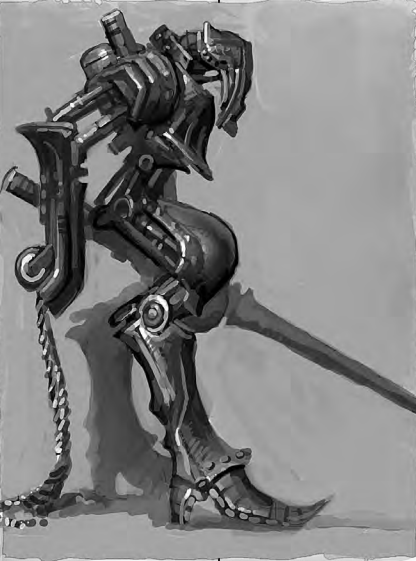
The Barbagula is an Irontooth Clans mech, a Huge steam mech that's 15 feet tall and coated in stone armor. It only needs the pilot, and it's a nasty little thing. It's fast, light and equipped with a right-arm-mounted changler whip and a left-arm-mounted giant lance. It's designed for ambushes, see, or pack tactics against larger mechs. It's fast for a steam mech, charging in with the lance and then using the changler to trip foes and knock them over for either boarding or stabbing to death with the lance. The mech's design is actually wildly variable - the basic concept is stable, but the Irontooths have several aesthetic variations. Other forces have copied the design at times, usually replacing the armor with iron or steel.
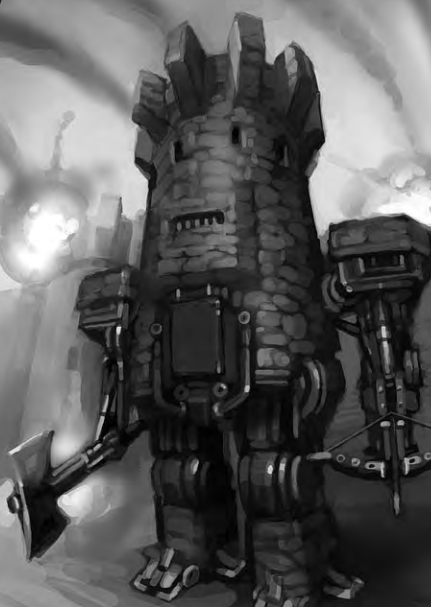
The Bastion is an old dwarven design, now obsolete. It was a Colossal machine that ran on steam and stood 35 feet tall. It was one of the first dwarven mechs ever made, and the design shows it. It's basically a tall, narrow walking castle tower with squat limbs. It's got no real head and merely stone armor on an iron frame. In fact, it was actually able to disguise itself as part of a castle by setting to a rest next to a castle wall. It is armed with a right-arm-mounted giant axe blade and a left-arm-mounted ballista.
Next time: A robot that headbutts people with a chainsaw.
Increasingly Silly Mechs
Original SA post Dragonmech: Increasingly Silly Mechs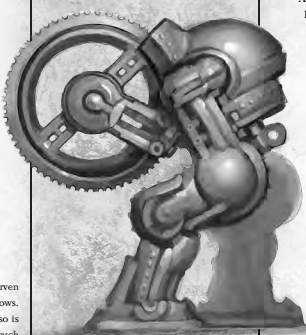
The Daughter is a Colossal clockwork mech that is approximately two-thirds buzzsaw, at least by height (and that's 35 feet, total). It's got a driver and another crewman, whose job, I can only assume, is to make it lean forward to cut things. It is a companion piece to a mech we'll learn about later, the Mother, and its main job is to harass other mechs that have become entangled by the Mother. We'll learn more about those tactics later, along with the history of both machines, which are Irontooth.
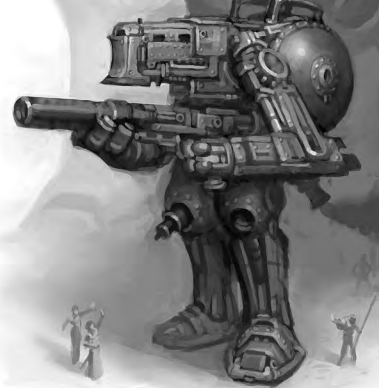
The Dignitary is a Colossal II steam mech, used primarily by human merchants out of the city of Edge. It's 50 feet tall and crews 3 - a pilot and two gunners, one for the left arm's giant steam cannon and one for the right leg's big ol' flamethrower. Its main job, however, is to serve as transport for a big iron vault in its chest, which is used to transport wealthy travelers to and from visiting citymechs. There are no sleeping quarters, though - it's a taxi, not a longterm traveler. It costs around 20 to 40 gp per hour of travel, and when citymechs show up at Edge small swarms will come out to bring people to visit them. A few models have been redesigned to have sleeping quarters for longer treks.
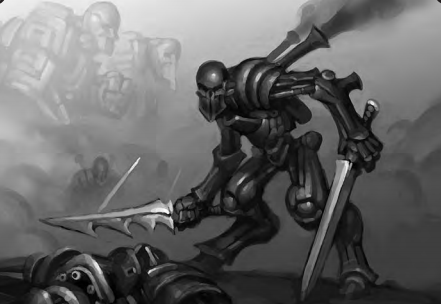
The Fangbiter is another 3-man mech, this time 25 feet tall, Gargantuan and steam-powered. It's got a big ol' sword in its left hand and a barbed blade in its right., and it's primarily used by the Irontooth clans and the rust riders, who often strip down other mechs to rebuild as fangbiters. This is because it's designed for capturing other mechs. It closes with them, and either uses the barbed blade to hold them in place or the standard blade to fight them. Meanwhile, the guys hanging off its legs or hidden in its crew jump over to the enemy mech and make their way inside to attack the enemy crew.
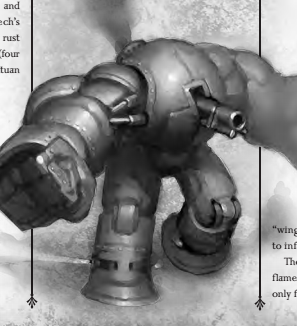
The Incinerator is a Colossal II steam mech and not a yellow devil, 50 feet tall and made by dwarves to fight infantry. Its primary armament is a giant steam cannon on its face, but it has two flamethrowers mounted on each foot, too. It needs backup to fight properly, as it can't handle other mechs, but is definitely good at stopping boarders. The name comes from the flamethrowers, but it's also good at using its oversized fists, each of which contains two firing ports for onboard gunners to shoot from if they feel like it, or pour oil out of. It can crew up to 8 people, in fact. Even the steam cannon is for anti-infantry use as a sniper rather than antimech fighting, but can do the job if it must. The main other thing about it is that its legs are extremely smooth, with the flamethrower nozzles no more than three inches long out of the leg, and the seams fit extremely snug. It makes the mech very hard to climb.
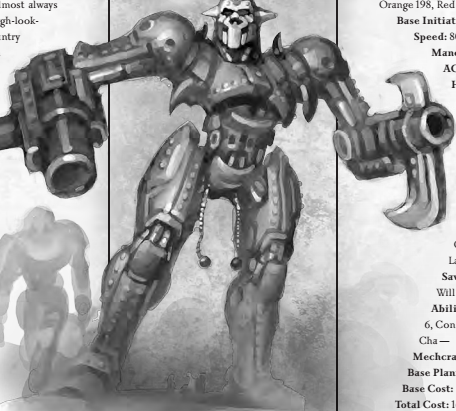
The Iron Maiden is one of the nastiest Irontooth designs, at 75 feet, Colossal III and steam-powered. It crews up to 16, but only 3 are used to man the weapons. The face is designed to mimic a skull, and the mech has only one job: capturing other mechs. It's coated in spikes, and its design is meant to intimidate. It usually goes into battle with 32 raiders aboard - 16 in each of its arm-mounted bore punchers - as well as being armed with a giant hooked axe blade. The idea is that it fires the bores into the enemy to get the raiders abord, then closes in to keep the mech distracted from the outside. It's also got crew armed to the teeth in case of enemy boarding actions.
Next time: Janzeter's amazing mobile cannon (mark I)
More Mechs
Original SA post Dragonmech: More Mechs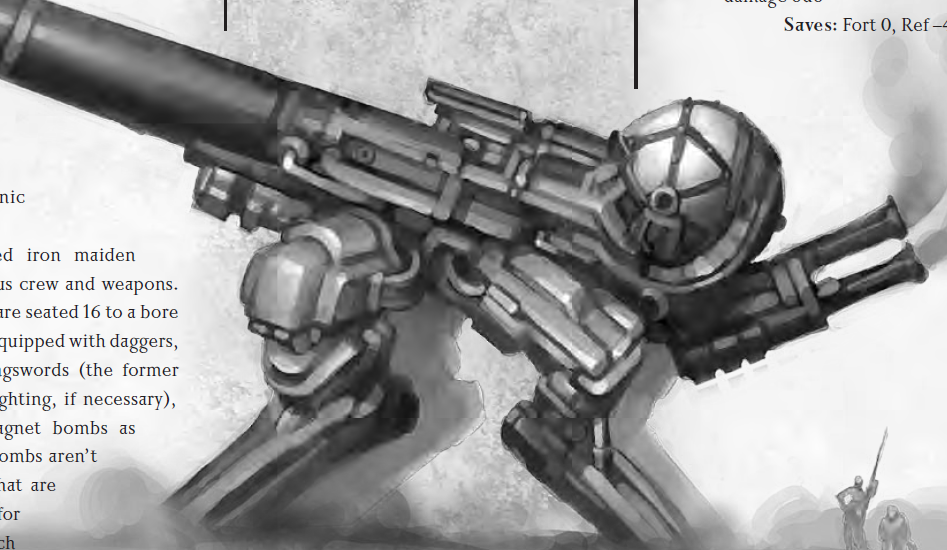
Janzeter's Amazing Mobile Cannon (Mark I) is exactly what it sounds like. It is a Colossal III steam-powered steam cannon on legs, standing 40 feet tall and with a cockpit in a glass sphere on the back. It needs 16 crew to keep the engines running, two of whom operate a pair of zeppelins to help it walk. See, the Mark I only had two legs as originally designed. The zeppelins were required to help it carry its own weight and not stagger around like a drunk when walking. It doesn't typically walk once it reaches a battle, however, planting itself and instead using its incredibly fine ability to adjust its targeting. It's the first mobile howitzer ever made in Highpoint, and even before he improved it, it made the Stenian dwarf Janzeter's name. The Mark II has four legs and no longer needs the zeppelins (though it also loses their ability to serve as spotters), and the Marks III and IV reduced the size of the cannon to make room for other guns. The entire thing remains unwieldy and slow, but it's much more mobile than horsedrawn cannons and vastly more powerful.
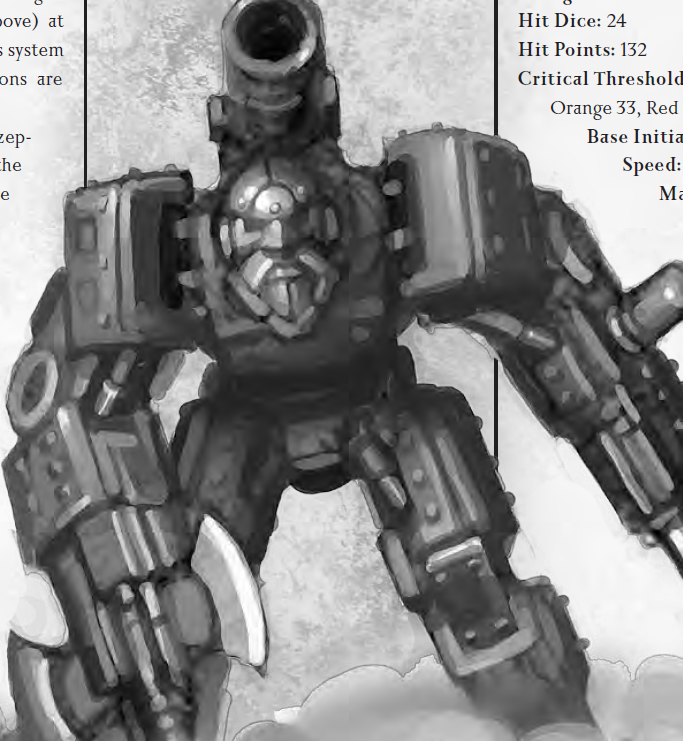
The Juggernaut is a Stenian mech, Gargantuan and steam-powered. It stands 25 feet tall and needs only 3 crew. It's the archetypal mech of the Stenian forces, designed to resemble a giant dwarf, and tends to lead just about any Stenian assault. Its right arm has a huge axe blade and a flamethrower, while the left arm has a pair of fire-linked flamethrowers, and there's a steam cannon built into the shoulders. The model is designed as an all-purpose mech, using the cannon against other mechs at range before swapping to axe and fist. Against infantry, the flamethrowers are excellent weapons - usually. Desperation sometimes leads to all three firing at once against an enemy mech, even though it risks the Juggernaut's own explosion.
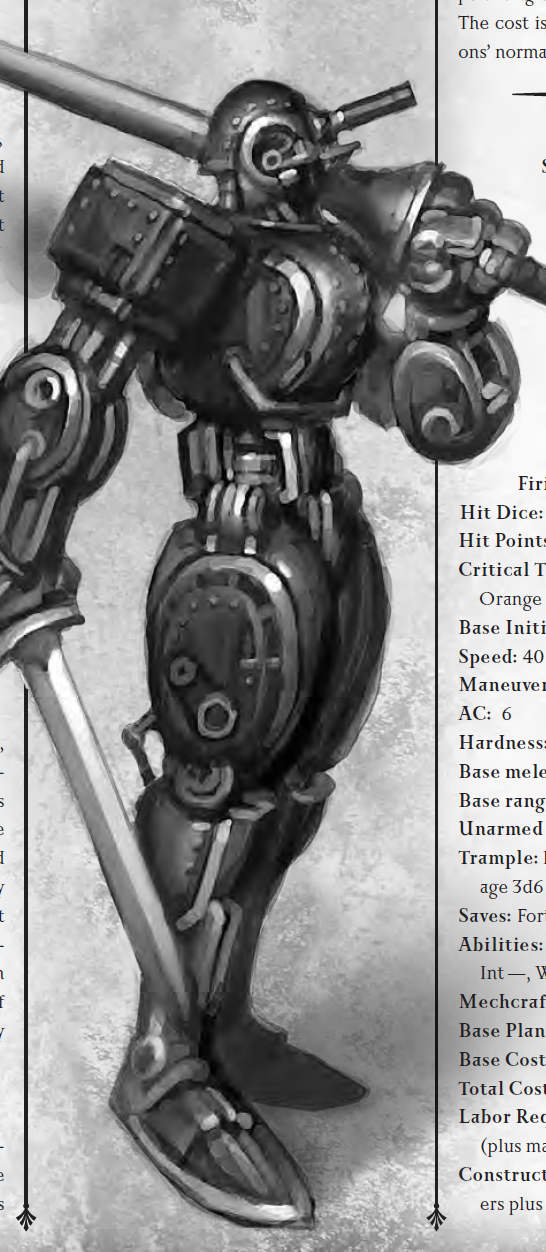
The Lancer was originally an elven mech, a Gargantuan animate design coated in mithral. That version needs only one crewman and stands 25 feet. The Stenian dwarves copied it as a Gargantuan steam mech, needing three crew and still 25 feet tall. Both versions mount the same weapons - a giant sword for the right arm, a lance in the left arm and a wand of magic missile in the head. The two appear largely identical, but the dwarf version is cheaper and more common. Both are intended for fighting against biological foes rather than other mechs, using their melee weapons for big hits and the wand for groups or really tough foes. They usually begin fights with a barrage of magic missiles before charging with the lance, then finishing with the sword.
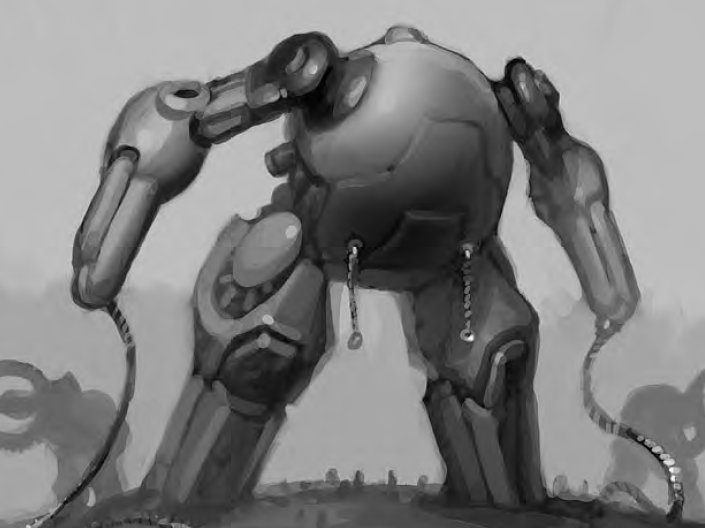
The Mother is the brainchild of the gnomish engineer Egwerd Turnscrew. He was a pioneer of clockwork mechs, and the Mother is a Colossal IV clockwork, weighing at 13 crew and 110 feet tall. Egwerd is a mercenary through and through, and he sold the Mother to the Irontooth Clans for a fortune, knowing they'd treat him like a king. The Stenians still have a price on his head for being a traitor. The Mother is big, fat and funny-looking, with one massive chain tentacle on each arm. The Irontooths thought it was a joke at first, but inside the Mother is a hangar containing two Daughters, and together, they're nearly unstoppable. The Mother grabs and drags in targets and the Daughters tear them apart. When fighting to capture, the Mother draws the mechs into its hangar and the Daughters harry defenders to keep them away. The Mother's hangar is what makes her so valuable - she can capture enemy mechs whole, without even needing to board them.
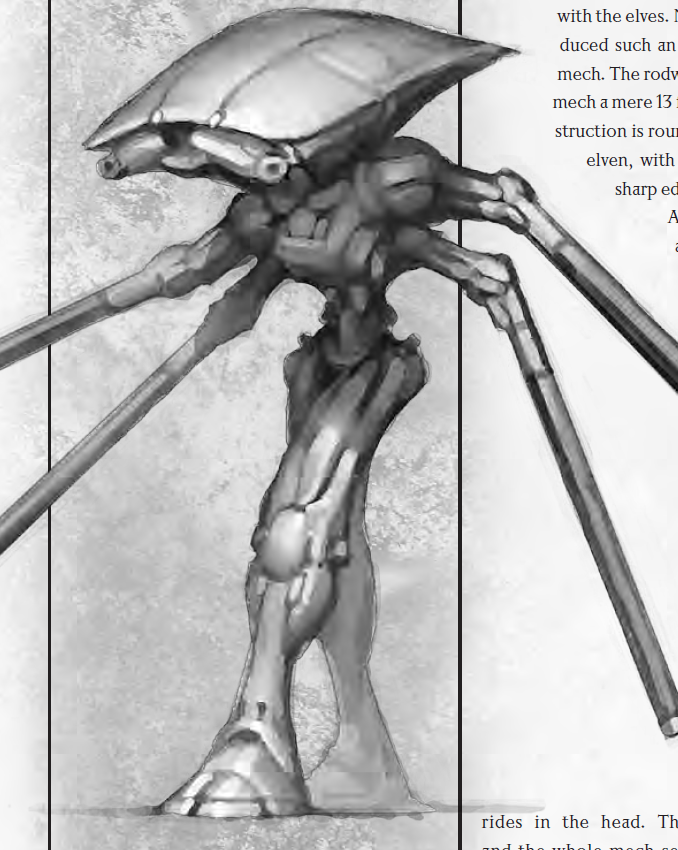
The Rodwalker is the name of this goofy-looking boy. It's a Huge, magically animated elven machine, a mere 13 feet tall and with barely enough room for the one pilot. It is also the elven signature mech. It's slim, fast and flowing. The bulbous head and hunched over build make it seem unstable, but it isn't. The four massive cylindrical arms are actually outsized wands of fireball that can, in an emergency, be used as rudimentary clubs. Not that, with a total of 50 charges per wand, they need to get into melee very often. The rodwalker was the first mech to make offensive use of magic, and now it's very common among elven forces. It's weak to dispellation, but its long range attacks usually keep it safe, and a team using overlapping fields of fire can burn down just about anything. Some variants use wands other than fireball for specialized missions. The wands can be fired one at a time, or they can be linked together to fire all four at once against one target. I love this stupid, stupid robot.
Next time: An orc mecha, which is exactly what you think it is, and an orc mecha, which isn't.
ORC
Original SA post Dragonmech: ORC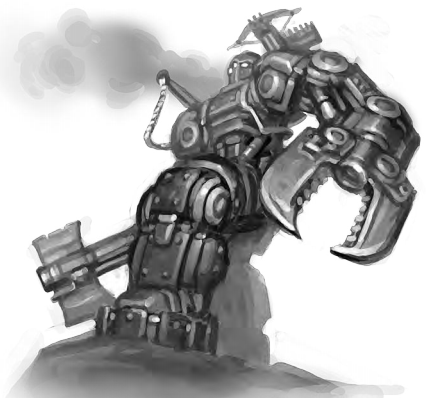
The Scale Hunter is a Stenian design with one job: killing dragons. It's a Colossal II steam-mech, fifty feet tall and with a crew of 8. It's got a shoulder-mounted javelin launcher on the right shoulder, a massive lobster claw on its left arm, a chain tentacle on the right shoulder, and a steam cannon and axe blade on the right arm. The idea is that it can fire continuosuly as the dragon gets close, survive the charge, then beat it to death in melee. Dragons that fight at range are hit with javelins and cannonballs until the mech can drag them closer with the chain tentacle.
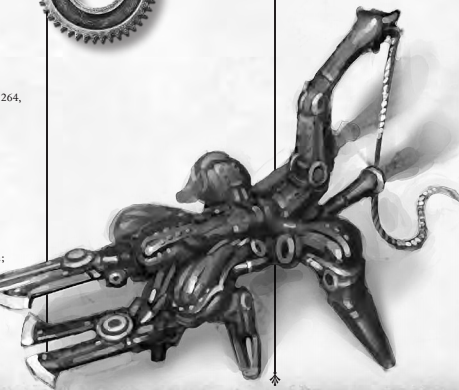
The Scorpion is another STenian mech, designed to fight other mechs - and destroy them. Both arms end in huge lobster claws, but the left arm also has a steam cannon. The tail mounts an immense chain tentacle on a turret that can attack with it in any direction. It's designed to capture mechs with the tentacle and tear them apart with the claws. However, the Scorpion line has been largely discontinued due to its complexity of design. They're very powerful, but also expensive and hard to build, so they were deemed too much for general use. They are, however, much harder than most mechs to trip, on account of their solid build and quadrapedal design.
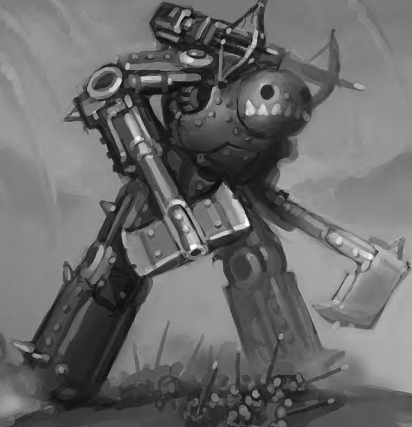
The Skull Crusher is the standard in orcish mech design - a Colossal IV man-powered mech, 110 feet tall and with a crew of 64. Well, 'crew.' It has a ballista on one shoulder, a catapult on the other, and axes for hands. Most of the crew are slaves who turn huge wheels to keep the mech moving. The design and construction are simple, but the tactics employed are surprisingly sophisticated. Skull Crushers primarily target small settlements and isolated nomads, using the mech more for intimidation than anything else, given that a tribe of 300 orcs follows it everywhere. Skull Crushers typically avoid mech combat as much as possible, but when forced into a fight, they charge as fast as they can and hit things with their axes.
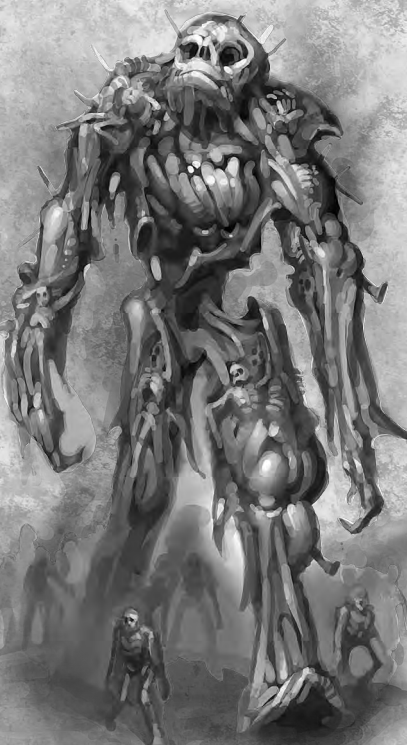
Slaughtergore is a one-off, a Gargantuan undead mech, 30 feet tall and crewed by one lone, unknown necromancer. Actually, I have no idea how the world even knows what it's called. It has been seen wandering around near the site of a large battle between orcs and humans, and it's believed the battlefield was actually where it was made, using both materials and zombie work crews raised on the spot. It appears to be a giant, gross humanoid zombie made out of the bodies of people, stitched and stapled together. It is unarmed, but most assume the creator's going to give it weapons at some point - they just didn't have the materials at the battlefield to make any. It has been spotted raiding tombs and cemetaries for parts, but has never directly attacked any living being. In the few fights it's gotten into, it's fought by punching things and running away. No one is clear on who made it, but it seems to be looking for certain corpses, though it's unclear why.
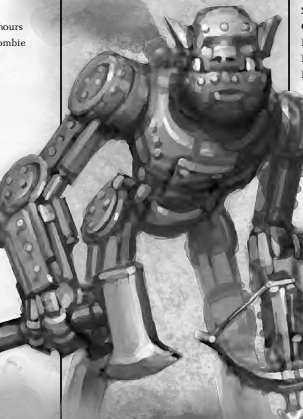
Smiggenbopper's Perambulatory Orc is a Gargantuan clockwork machine, 25 feet tall and with a single crewman. It was designed by Pobloppy Smiggenbopper, a gnome and early experimenter in clockwork mechs. It's designed to frighten orcs in battle, and it...looks like a giant orc. It has an axe in its right hand, and a concealed flamethrower in its upper arm. The left arm is a ballista designed to look like a crossbow. The intimidation tactic actually worked at first, scaring the orc tribes that faced it and fooling them into thinking it was a god...until they noticed it always got followed by gnomish and dwarven soldiers. Now, they just know it's good at hitting things. Smiggenbopper has actually built several variants with different racial designs, but none have caught on. This is because the ballista relies on an automatic reloader that requires a pilot skilled in using steam powers, so the Stenians never actually comnissioned more than a handful - and neither has anyone else.
Next time: The last mechs in the chapter.
MECHA OUT YOUR EARS
Original SA post Dragonmech: MECHA OUT YOUR EARS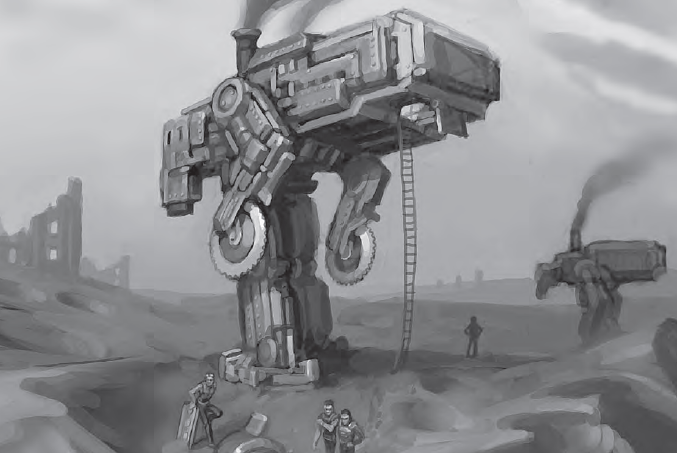
The Talon is a Colossal steam mech, 35 feet tall and crewed by 4, that is primarily used by dwarven merchants. It's a transport designed to be able to defend itself on dangerous routes, armed with a pair of buzzsaws, one to each arm. It's got room for four passengers to sleep comfortably, or three times that many if they're very cramped, and that area can be used to ship goods if there aren't passengers. Talons try to avoid combat when possible, but those buzzsaws are nasty if they're forced. They'll make use of terrain to avoid ranged weapons if possible. Fortunately, they are rarely forced into large battles - just fights against raiders or monsters.
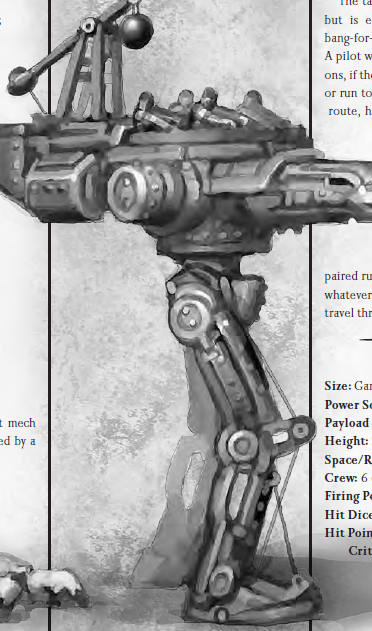
The Totem is a name to refer to the mechs most often found among nomadic mech tribes. They are usually Gargantuan, man-powered things around 25 feet tall and with a crew of 6. They are usually former steam mechs scavenged and converted to a cheaper power source: oar-based engines. The steamtech weapons get chucked to make space, leaving the thing armed with a single shoulder-mounted catapult, and often the armor is stripped to reduce weight. Totems are rarely able to survive combat with other mechs, but they're not raelly meant to fight them - they're transport and protection for the tribe against raiders and beasts. They will typically launch catapult shots until foes close, then do their best to punch them to death, but they're rarely much good at fighting due to lack of crew - there's barely enough room for the pilot and 'engine', let alone gunners. They're called Totems because the tribes usually decorate them with totemic iconography.
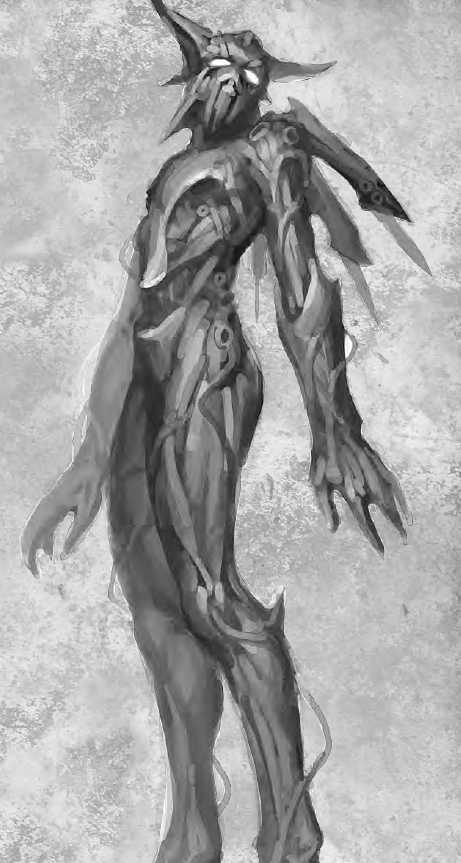
Verdant Fury is the personal machine of the elf ranger Juna Darkwalker. It's a Huge, magically animated machine, 15 feet tall and barely large enough for its one-man cockpit. Juna and his former adventuring companions each made their own mechs when the rains came, and each have gone to defend their ancestral lands. Verdant Fury is made of mithril with a layer of living bark on the outside, allowing it to disguise itself as a tree. It has no visible weapons, but stores four magical +1 dancing longswords in its torso to deply. It typically hides until an enemy is in ambush range, then charges and punches, pulling out one sword per round after that to minimize the periods in which there are no blades attacking. It is designed to fight monsters from the moon rather than other mechs, and is poorly armed to deal with other kinds of foes, but is quite good at taking on infantry and lunar monsters. I think Juna was one of the party members of the personal game that DragonMech was born out of.
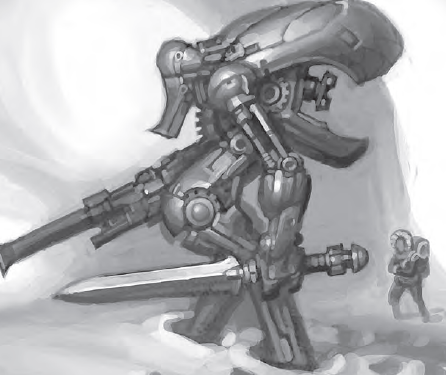
The Viper is an exceptionally common machine at this point. It's a Gargantuan clockwork mech, 25 feet tall and with only a pilot. It was originally built by a dwarf in Edge and quickly caught on as one of the best one-man mechs around. It's rarely seen in armies, but is great for travelers and mercenaries. It's got enough space for the pilot to sleep on board, plus good armaments in the form of a steam cannon and big sword. It's a pretty good mech for a one-man crew, and easy to maintain due to being clockwork and so not very fuel-hungry.
The next chapter is the equipment section. A bunch of new equipment is added - mostly siege weapons for mechs to wield and stats for mech-scale weapons, but there's also the hooked axe and barbed blade, which are sword and axe variants that increase critical damage and allow you to trap foes from moving away. There's also stats for stuff like bore punches (hydraulic blasters that fire a spike into the foe and then, if the foe doesn't move away, opens the spike up to allow boarders in), changlers (a bunch of chain whips all strapped together to better entangle mechs) and lobster claws (weaponized vises).
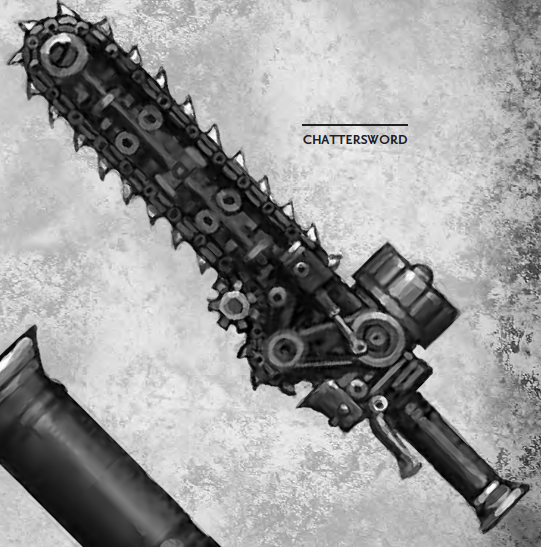
Oh, and chainswords. There's also a bunch of new bombs/grenades, ranging from explosives to things that cause massive rust to signal flares. There's flamethrowers and steamblasters. Armor also has some new entries - one designed for comfort in mech cockpits, less good (but cheaper) chainmail made out of discarded machine parts, and hydraulic power armor. The power armor is notable for the powers it grants: an air filter that gives +4 against gas attacks, a shaded visor for +4 against blindness, increased unarmed damage, +4 vs bull rushes from stability, a big penalty to Hide checks due the giant smoking steam engine (-8, so a really good rogue can still manage it) and a set of jumping springs that let you jump without an armor penalty as if you had Str 20.
Next time: Magic items, which can get weird.
Magic Shit
Original SA post Dragonmech: Magic ShitThe drow have developed magical engines that run on the blood of the living, draining it from captives. (The dwarves actually captured one of these and found a way to duplicate it nonmagically, but have outlawed it entirely.) A similar device, a variant spell furnace, can power a mech by draining the magic out of extraplanar or magical beings. Very nasty, but not too weird. One of the weirder ones is the ethereal catapult - a magically enchanted catapult meant to pierce mech armor. It turns its stones into ethereal matter when launched, which transform back after breaching their designated target. This makes it attack via touch AC, not that it's going to miss a mech at all - the big thing is, they bypass all hardness and have a threat range of 17-20 due to manifesting inside the target. In theory, any weapon could use the enchantment, but so far it's just catapults.
Or you could make an intelligent, self-aware steam engine by the same process that intelligent weapons are made. If you do, and then put that steam engine in a mech, it can pilot the mech without any human assistance. There are a few sentient mechs out there as a result - most notably, one that hunts orcs after its creator was killed in an orcish raid. This sitll isn't the weirdest magic item - and neither are the speaking engines, which are steam engines with magic mouths cast on them with conditions to speak under certain mechanical conditions, such as an overheating boiler or gears out of alignment. It makes diagnosing problems easier.
Nah, the weirdest is the elven experimental design: magnetized ring gates. They have yet to be deployed in battle, but they're very promising. They're a lot like three-foot diameter ring gates from the normal DMG, but one is anchored onto a mech. The other gets hurled out of a catapult. It's enchanted to magnetically staple itself to the first metal thing it touches - usually a mech. Once that happens, the power is activated. See, you can pass anything through the one gate to emerge out of the other, through any wall it's attached to - so you can send a boarding party into the enemy mech without even piercing the hull. Or you can throw grenades through. The elves have very high hopes for these things, but they do have problems. They are extremely difficult to make, requiring a 17th level caster, and they're not exactly easy to use, either.
You can also enchant mechs directly. Elves like to throw up Protection from Arrows against other mechs, while dwarves prefer Protection from Elements against elven forces due to their preference for fireball wands. Famously, one mech battle was won due to a mech being enchanted with the ability to use Rusting Grasp. This generally requires the Combine Spell feat and multiple casters, because mechs are stupidly big.
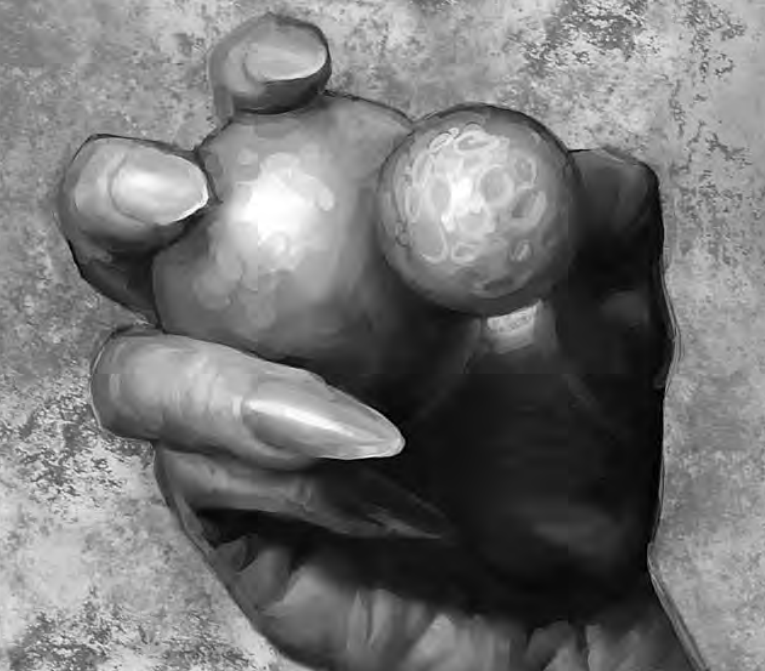
Now, let's talk about the world. Strictly speaking, the planet is DragonMech - or, rather, has many names and the game's narration text calls it that. Highpoint is the continent where all gameplay takes place, however. Only Highpoint has developed mechs - the other continents are just basically fucked by the lunar rains and the monsters from the moon. The reason it's called Highpoint is because of the tides. The oceans of the world rise and fall by over 30 feet each year due to massive temperature swings at the poles, which freeze and melt arctic ice regularly. The moon has also fucked with tidal patterns, making it even bigger. As a result, pretty much no settlements exist near waterways, as the coastlines shift wildly over the course of a year. This is part of why so many surface races were nomadic.
Before the lunar rains, amphibious races dominated the world. Even now, the amphibious races and their half-underwater settlements aren't too rare, and there are amphibious variants of all the normal races, on top of other weirdos. Trade routes ae also highly seasonal, as they are often underwater for large portions of the year. Highpoint's name comes from the fact that, on average, it has the highest distance above sea level. It's actually a bunch of plateaus with a mountain range on top, with only the lowest plateau, the western Wet Desert, going underwater for half the year. (The other half, it's a salty desert.) Historically, the eastern coastline has been tall enough that no floodwaters could ever breach it, though since the rains began, that hasn't been quite true.
Most of Highpoint is temperate or warm, getting cooler and wetter as one goes east. The northern forests are more tropical (and wet), and the southern swamps are also pretty wet, but the west is pretty dry, even in high-water months. The southern tip of the continent is colder than the rest, but still broadly temperate. Highpoint recognizes only two seasons - high-water and low-water, which broadly are spring/summer and autumn/winter respectively. The water isn't rain - it's flooding from the river that splits the continent or the ocean surrounding it. The west suffers it more heavily than the east, with mostly lakes and rivers expanding in the east. The east does get snow in the latter half of low-water, but the west rarely gets rain or snow at all.
The most common form of timekeeping is the Duerok system of the dwarves, largely because most human tribes don't actually use a set system at all. The dwarven system divides the year into seven months, each of six weeks, each of six days, for a total of 252 days per year. The first day is Diggon, traditionally the day in which delves began and a day of general communal activity. It remains so on mechs, though digging isn't really a thing that happens there. The second day is Axon, the day of martial training and still used on many mechs as the day of fighting drills. The third day is Digget, which is like Diggon. The fourth day is Suron, and it (and the two following days, Suret and Surol) are dedicated to personal labor. In the past, Surol was a day of rest, but that tradition ended with the lunar rains. The seven months are Arie (approximately spring, when the waters are at midpoint), Cammerce (as the waters rise and traditionally a month of trading and travel), Highwater (as the waters peak), Duerok (the month of holidays, when all dwarven holidays happen - one each week - to honor the dwarven virtues of Thrift, Discipline, Clan, Honor, Strength and Valor), Flero (the waters begin to recede), Jealo (the cold time when nothing is growing and stores are being depleted) and Lowwater (when the waters are at their weakest ebb).
The moon has approached close enough that it can sometimes take up as much as 3/4 of the sky and is visible even by day, though the moon does follow a regular cycle. While parts may be shaded, the entire surface is still visible, and on full moons, the night as near as bright as day. The rains have calmed some since they begin - in the early years, meteor rains were extremely common, blasting the surface constantly, or raining down red-hot particulate. The surface was utterly devastated save for the few settlements protected by terrain. Now, however, the rain is largely in the form of thick, soupy sandstorms that scrape at unprotected skin but is rarely lethal. The rare meteor shower does still happen, but not often except during the full moon. There's a random table you can roll on to determine the lunar rain each night.
Next time: The peoples of Highpoint.
Places That Aren't Mechs
Original SA post Dragonmech: Places That Aren't MechsMost of Highpoint's peoples have always been nomadic, with the exception of the elves and dwarves, who constructed permanent settlements far more often. However, the humans did found several city-states, even if nomadic tribes were much more common even before the rains came. With the coming of the lunar rains, however, almost all of these settlements have been destroyed - as have many of the elven ones, actually. In the wide, sweeping plains at the center of Highpoint, there are now only four surviving cities: Glatek, Edge, Stilt City and Chemak.
Glatek survived by being in a sheltered valley under the western plateau. It was built on a trade route between the elves, the humans and the aquatic slathem race, and at its peak it had more than 5000 permanent residents and thousands of nomads and traders passing through at any time. Now, it is approximately half that size. It is a vertical city, built downwards into the stone due to the carving of an immense underground channel by the slathem to connect the seas to the north and west to the trade city. While the tunnels are flooded constantly, the area directly around Glatek sees them ascend into natural caves, with the city 30 feet above the high water mark and 60 feet above the low water mark - so depending on season, there's 30 to 60 feet of usable airspace in the caves. Most buildings in Glatek are a mere story high but three stories deep, some much deeper. The underground area is known as the bottomcity, with the 'docks' as floating platforms at the very bottom. Slathem now come and go without ever seeing the sky.
Glatek is built defensively, with a series of three walls around it and most of its valuables stored in the bottomcity. The original wall is now within the city itself, with a twelve-foot second wall around the city proper and a third wall that is less of a wall and more a flat, foot-thick stone 'floor' that covers the streets to protect the bottomcity from invasion. (Buildings older than the second and third walls actually exist recessed about a foot into the ground as a result.) This defensive design is what allows the city to survive the rain, especially once the inner wall had ballistas mounted on it to drive off lunar monsters. The underground waterway provides a constant source of water - saltwater, but that can be purified with some effort. The slathem bring seafood for trade, though tensions are high thanks to slathem price-gouging. The areas outside the inner wall are heavily damaged by monster raids and are primarily occupied by refugees and scavengers not allowed past the inner wall. The city is still known for wealth and has to fight off tribal raiders fairly often, but the bottomcity has never been breached.
The bottomcity is easily the wealthiest part of the place, particularly the area closest to the docks, which is ruled by wealthy slathem brokers and middlemen. the surface is slums, progressively worse the closer to the walls you get. The city is still ruled by the merchant-council that was its government before the coming of the rains, and the council is entirely human. In theory is a hereditary seat, but wealth and commercial power are vastly more important than bloodline, and new traders can often find a seat by flexing their mercantile muscles, while those who are stricken by poverty tend to resign due to the threats of the other councillors. All members of the council must trade (in theory) in one of the city's major or former major commodities, though many are no longer viable - herbs, spices, fine fabric and elven arts don't come in much, nor do grains or livestock. Now, Glatek mostly trades in metals, spare parts and weapons, seafood and preserved meats, timber, and slaves.
Edge is built on a cliff face, on either side of a waterfall where the Endless River that splits Highpoint emerges from underground. It was originally a trade city built to circumvent the waterfall to allow merchants to cross the area with staircases, ropes and elevators, all toll-operated. The tolls fueled Edge's growth as a highway for travel up and down the waterfall. Within a mile of the waterfall in either direction, there are now hundreds of routes up and down the fliff, from half-orc porters to the toll-driven staircases and elevators to the occasional wizard with flight spells. The city's main industry is moving goods up and down the thousand foot cliff. Over the years, the cliff itself has been hollowed out to make homes, with struts added to support overhanging buildings. Many of the cliff homes are owned by the porters, tinkerers and tollmen who tend to the routes, while the rest are shops, inns and the craftsmen found in any settlement. Edge is a narrow and highly vertical city, and there are no public routes from the top to the bottom. Locals use the routes managed by friends and families; outsiders pay the tolls. You could, in theory, climb, but it's a misty, slippery climb and all the locals will come out to mock you and throw rotten food.
The waterfall's basin is home to a dock district and plenty of inns, taverns and so on. Goods come in and are traded there, both before and after crossing the waterfall and cliff. The top of the waterfall is a huge cave, widened out on both sides for boats to unload from the underdeep. The upper landing is smaller, however, due to the cave walls. There are also homes behind the waterfall itself, as well as the church of Fhurlin, the most powerful being in Edge. The city can only really exist thanks to the need for trade along the Endless River, which flows underground for miles, connecting all the major underdeep settlements of every underdeep race, from the dwarves to the drow. The lunar rains have slowed Edge down only slightly - they brought plenty of refugees to pass through to the underdeep, but Edge itself is barely big enough for its own residents. Instead, it mostly just lost toll revenue as the staircase guards were overwhelmed by the tide of people. The lunar dragons avoid the city for reasons entirely unclear. The residents believe that the cliffside is hard to attack and the caravan guards are a good deterrent...but mostly, they thank the city-god Fhurlin, whose worship remains far stronger than religions elsewhere.
The Church of Fhurlin is the nominal government of the city in the name of the god of roads and travel. Fhurlin has many names - mostly variants like 'Fharlan' or 'Flarygng' - and the church is not much of a government. Edge is a politically volatile, fractured place, and continues to exist only because many people have an interest in keeping it going. It's a natural anarchy, resistant to any organization and funding most things through the private wealth of the tollmen. Several attempts at government, from councils to mercantile rule to military takeover, have all failed. The church has emerged as a kind of unofficial ruler, as nearly three of every four people in Edge worships Fhurlin, and their parish guards are the de factor police of the city, with the head cleric as the unofficial mayor, though even he can only really settle disputes and maintain order, with any funds dependent on charity and tithes, which are wholly dependant on the goodwill of the people. The city itself only has around 1300 permanent residents, with a few hundred traders visiting at any given time.
Stilt City is a tiered city, and officially named Tyrat, for the river it's built on. The place is close enough that in highwater times, the river floods and leaves the city covered...so they built the place on stilts. The ground level area is only used for farming during low-water times. The second level, twenty feet off the ground, is a lattice of stilts and metal that are kept clear to allow sun through in low-water times and are used for farming in highwater times by bringing up reeds and mud. The reed mats dissolve from rot around the time the water recedes, allowing the mud to fall back down. The third level, 30 feet high, is the residential and business area, where most of city life happens and which never floods. It's much more solid, as a result. It is from here that the king of the city rules.
Stilt City is extremely powerful agriculturally, producing food for everyone for miles around. However, due to the city design, the area directly under the city center can't be farmed due to the constant cover from the city itself. This area is home to all kinds of squatters and criminals during low-water, and the guard are at constant war with them, only semi-successfully. There's not enough resources to chase them all off...and any time a farm gets abandoned, the squatters get more land. Most are nomads, but there's also small goblin tribes and even the occasional monster or dire beast.
The city itself is ruled by the unambitious King Lorshay who is mostly concerned with keping his people alive. His ancestors built the city, and his military isn't that weak, but he's an old man who is used to luxury and has never quite figured out how to handle the rains and dragons. Stilt City is regularly attacked by dragons, and while the armies of the city have kept the place intact, they take heavy losses every time the fields are assaulted. The lunar rains make maintaining the city itself ever more difficult. In the past gneeration, Stilt City has declined heavily and lost most of its population. Those that have remained are mostly the farmers with fields closest to shelter, and the city's days are almost certainly numbered. It does have about 3000 residents, but of those, only 500 are safe in the city center, while the rest live in the farms.
Next time: Fortress City Chemak and the ruins.
Orcs - The Worst
Original SA post Dragonmech: Orcs - The WorstChamek is a fortress on the eastern edge of Highpoint, sited on whath as always been the end of orc lands for millenia. See, thousands of years ago, the warlord Chemak organized giant tribal alliance against the orcs, and he conquered a lot of land. Chemak is the site where he built his castle. Even now, the society that lives there is militaristic, disciplined and obsessed with defense against the orcs, who have attacked the city many times but always been driven away. Most of Chemak's history is now forgotten, but for two things: the name and the war with the orcs. The fortress-city is now obsessed with defeating the orcs with overwhelming force.
Chemak is easily the most fortified city on the continent and perhaps the world. Its center is a 150 foot castle, surrounded by six sets of walls divided into eight sections, designed to allow successive retreats through city sections in order to prolong city defense. Legend holds that the orc warlord Therug managed to get through to the third ring, so the Chemak forces faked a retreat and lured the orcs through a false breach, then sealed the gates on him and trapped him in a wall section in the city. Then they burned that district to the ground, using arrows to kill any orc survivors and containing the fire with the walls. This is now an institutional strategy, the Therug Fire. It's really the core of Chemak strategy: sacrifice a finger for the thumb, sacrifice the thumb for the hand, sacrifice the hand for the whole and sacrifice the whole to destroy the enemy. Chemak doctrine is ruthless in all ways.
It's taken nearly three thousand years to get Chemak to its current state, and there's more stone in the walls than there ever was in the ground around them. Workable stone has been their main import for centuries. Not even orcs would consider attacking Chemak at this point, and there's no reason to continue building its defenses, but they still do, because it's what they've always done. The entire city but for the young, old and disbled, are part of the military, with 60% of the population on active duty at any time. This has actually served them well against the lunar rain - Chemak is utterly unchanged thanks to its solid defenses, and it's had anti-air emplacements of ballistas and catapults for centuries, which have driven off the dragons enough that they rarely attack any more.
The king, Krecham IX, traces his lineage back to Chemak himself, but leaves most of the city's governance to his council of generals, who are essentially nobles promoted for good military service. The truth is that the line of Chemak has blurred to the point that several times, powerful generals descending from him have fought over the throne, and military coups are not rare in Chemak's history. Further, Chemak's actual control is limited. Its tactics are fundamentally defensive, and it's never been any good at conquest. Every few generations, one of the generals tries, but their invasions invariably fail. First, there aren't actually any settlements nearby to conquer and hold, and second, the high-water season's floods make it very hard to maintain supply lines, especially around Chemak's closest neighbor, Stilt City. There are around 3,500 current residents of Chemak.
Beyond the standing cities, there are three major ruins that still hold some importance in Highpoint. First is Bessemer, once a magical elven city made of living trees guided over thousands of years of careful growth into an interlocking arboreal city. However, it was made for beauty, not defense. While the mages of Bessemer managed to, largely, survive the rains by fleeing with their magic, the city was far too delicate to withstand the lunar invasion. Now, it is a burned, twisted wasteland of flattened forest. The treants there have gone utterly mad, though some elves remain as refugees, hiding as best they can in the burned-out groves.
Rook was a mountain city that traded in gems, ore and wool with the nomadic tribes. However, as it turned out, the mountains around Rook were the highest point in the plains, and so the lunar dragons first roosted there. Rook had relied on the mountains for defense, but they were no help against the lunar dragons, and Rook was one of the first cities to fall. Now, the ruins are home to several dragons. However, the area is somewhat famous as the birthplace of Shar Thizdic, master of the Legion, whose parents were shepherds before the city was utterly lost. As Rook came under greater assault, Shar organized the youth of the city to make a stand so the nobles had time to gather for a fight. His ragtag army surprised a single dragon, grounding it and fatally wounding it. However, the dragon died by collapsing on top of Shar's family cottage, killing everyone related to him. The next day, five dragons came for revenge, flattened the city and managed, somehow, not to kill Shar, who fled to the plains with everything he had ever had in burning ruins behind him.
Lebra was a city in the Lilat Forest, once home to the White Congress, the greatest mages' association the elves ever had. Their library was stored there, and the city's entire economy was built on knowledge and magic. The library was actually only a mere two hundred books - but each book was two feet thick and usually three feet or more wide, along with being extremely magical. It is said that each book had a room of its own, and not even most mages could read more than eight to ten in their entire lives. Lebra's powerful mages fought well against the dragons, but the rain weakened the city, and the dragons refused to live Lebra alone as they had Glatek and Chemak once those cities showed some fight. For some reason, they were coordinated and persistent in fighting Lebra. In a final move of desperation, the White Congress called on immense power...and the library vanished. Then they left the city to be destroyed.
No one knows what happened there - perhaps not even the White Congress, some say. The truth of it is that the White Congress gave the library to a powerful extraplanar being to protect, reasoning that it would be safest if even they didn't know where it was. So that being now protects it somewhere that no one knows. It is said that it will return exactly 501 years after it vanished, assuming its current master keeps his promise. The White Congress has until then to clear the planet of dragons and make it safe. Lebra is a popular destination for adventurers seeking magic items left when the city was abandoned, or seeking out strange portals that are said to have been left when the library went away.
There are, of course, a number of nomadic peoples that have no city. The Stavians, for example. The Stavians are one tribe split in half - the horse riding Stavians and the dusk devil Stavians, who ride giant bugs. Once, they were one group, but split centuries ago. Now, the two clans are bitter rivals, each of which claims that their mount is the mark of a true Stavian. Between the two groups, the Stavians are the largest nomadic tribe in the world, with around 4000 people. All of them are great riders, practically raised on their mounts. They move constantly, never staying in one place for more than a week and surviving on hunting and foraging. They respect no boundary, believing that all of the world belongs to everyone, and the worst crime anyone can do is block the passage of another. The Stavians are fundamentally a peaceful group and rarely fight others, focusing on speed and agility when they must fight. They try to outflank and confuse foes until they can retreat, always relying on their superior riding skill and maneuverability. Stavian culture is built around riding. Disputes are solved by racing, obstacle courses or other contests. Their crafts are almost entirely those that can be done on horseback - they do not make pots or use forges, but rather prefer weaving and leatherworking. They are famous for their trading across the continent, and each group is led by a shaman (usually a cleric) and a headman (usually a fighter). They rarely possess any arcane magic at all.
The Thurd are a violent band of half-orcs. Originally, they were born out of the mating of orcs and humans - not especially rare, really, given that the nomadic orcs and nomadic humans basically lived alongside each other in the past. The half-orc children were rarely accepted by either group, and so the Thurd were born. They are a tribe of half-orcs who have, for the most part, had neither orc nor human parentage for generations - just half-orcs. They no longer, in fact, consider themselves crossbreeds - they are Thurd, their own race. The word 'Thurd' refers to someone whose ancestors are orcs and humans, not someone whose parents are orc and human - for that, the Thurd retain a word for 'half-orc.' However, the Thurd have done little to otherwise differentiate themselves from their raiding parents. They live largely by preying on orcs and humans alike. They worship reptiles, for reasons that no one actually remembers, and their gods and totems are always reptilian in shape, while their chiefs wear snake-headed cloaks. Every Thurd band is led by a chieftain, usually a mid-level barbarian. They are occasionally accompanied by humans or orcs, why might be family, lovers, friends or slaves.
Next time: More nomads.
WOOOOORM
Original SA post Dragonmech: WOOOOORMThe Wisps are a small tribe of wanderers, mostly human but with a few half-elves. They are masters of camouflage and stealth, hiding nearly constantly as they are on the move. They even wear cloaks that incorporate pockets full of sod, which they plant ivies in to grow over the cloak and let them pretend to be plants. They survive on hunting and gathering with little impact on their environment so as to be harder to track. They have a reputation for just appearing, then vanishing just as quickly. Most plains nomads know, however, that it's not magic - they're just that good at being rangers. While they are easily the smallest major tribe, they are well-regarded as trade partners and always have rare plants and other natural goods to trade. They are almost all trained rangers or rogues, with the leader of a band being the most experienced.
The Gur are nomadic farmers, either raising naturally occurring groves or farming fast-growing crops in cycles that match the seasons. Often in low-water they will grow crops on the banks of waterways and then retreat when the water comes, raising crops on the fringes of the flood. They are always the best-fed tribe, and highly valued by the others for the food they can sell - they have more variety than anyone else, as each group tends to specialize in specific crops and then intertrade them among themselves. They are also more likely than others to have arcane magic. Indeed, they've developed an entire school of (entirely unstatted) agricultural magic designed to improve their crop yields and exterminate pests. Almost all of the (quite populous) Gur are human, but there's a few Gur elves.
The Hypsies are a Roma stereotype. They are primarily halflings that travel in colorful wagon trains to trade and perform for others. They often bring exotic beasts and enslaved or magically charmed monstrous humanoids, and each family tends to specialize in an unusual entertainment skill. They are also known to cheat their trade partners when they have a chance and pass off fake magic for real, but they are welcome wherever they go because entertainment is so rare these days. So...not great, as Roma stereotypes go.
The Worm Farmers are a new people. Before the rains came, the many kinds of giant worm that live on Highpoint were seen as mere vermin, able to destroy farm fields easily but otherwise ignored. They're essentially forty-foot earthworms that travel in parks, and destroy the roots of plants they pass under. However, after the rain started, the farmers took shelter in the worm tunnels, and discovered many things. Most notably: the worms don't eat roots - they eat the earth itself, including anything that happens to be in it, and shit out any plant or mineral residue, along with most nutrients in the soil. In fact, they were competing with the plants for the dirt rather than the humans for the plants. Further, their shit was useful for al kinds of stuff depending on the soil. You could work it as metal if there was plenty of ore, you might eat it if there were lots of roots, since in that case it'd come out as mostly plant matter in a soup of nutrients. So, the worm farmers began to follow the worms, who didn't care because they're big stupid worms. Now they are a mix of pretty much every race, and after a few generations they've learned to herd and breed the worms, creating the deep-divers that never come up to the surface and the shakers, which can fire sonic attacks. The worm farmers have an entire underground economy about thirty feet below the surface, and several human families are starting to lose their color and develop darkvision to adapt to the underground.
The Tortogs are essentially giant turtle people. They're about five feet tall but very wide, with legs the size of a human torso. They have tortoise faces, and their 'shell' is really more of an armadillo-like mass of overlapping bands that covers their whole body. They are slow, but extremely strong, and short of being hit by a falling meteor they are essentially immune to the lunar rains due to their natural armor. They aren't immune to lunar dragons, though, so they've learned to travel at night, when the rains are at their peak and the dragons are usually at home. They were once found only in the deserts, but are now proliferating, both as traders and as raiders. See, other races tend to let their guard down at night, and the tortogs have developed a certain reputation for brigandry due to taking advantage of that.
The Dusk Runners are a world-wandering nomadic culture, once seen only about once a generation, always bearing rare goods and tales of far-off lands. Most of them are dead now, but the remnant continue their traditions. They travel ever westward, rising and sleeping with the sun. They ride the dusk devils, massive insects native to the opposite side of the planet which are very fast, very strong and able to run at twice a horse's pace for several days straight as well as lifting ten times their own weight. The name 'dusk runner' is because these riders love to race the dusk, though it's rarely witnessed. See, when the lunar rain comes, they race west as fast as possible, trying to outrun the oncoming stones. They always get caught and forced to take shelter, but it can take quite a while. When they arrive at a city, all work comes to a halt for a massive trade festival. They aren't trusted, but they are always welcomed.
The Endless Traders are named for the Endless River, which they head up and down over the course of the year. They start at Edge or further east, then head overland to the west, towards the mouth of the river, where it enters the underground. Usually, they arrive around low-water, buying boats and salt from the slathem of the West Desert. Then they sail back up the Endless River, heading underground back to where they came from. They trade the goods they gathered on the overland journey, selling them to the races in the underdeep, then sell their boats at the other side of the journey and start over. The trade has been going on as long as Highpoint has had civilization, and several tribes partake in it, but few outsiders can tell them apart. They have their own trade language and magical rituals built around trade - largely illusions to make their goods look better, but also conjuration of trade goods, transformation of defective goods into good condition or even working with extraplanar forces to determine pricing.
The plains orcs have been around as long as anyone can recall, and they've never really built anything greater. They've just been orc tribes - until now. For the orcs, mechs represent power, an obvious and immediately useful tool. Anyone can steal a mech, nearly anyone can build one, even if it's a shitty one. The orcs love mechs, and work to make their own. First, they captured enemy mechs, then developed their own (rather primitive) engineering. Most orc mechs are powered by slaves using all kinds of means, and so orcm echs are slow, underpowered and inefficient...but they're still mechs. They're weaker, pound for pound, than another mech - but they can take most organic beings on, especially other nomad tribes. Orc mechs are easy targets for other mech forces...but also prone to dangerous and unpredictable attacks, such as rams or suicide dives. An orc tends to see destroying their own mech as worth it if they can capture the other, after all. Most of their tactics revolve around breaking into enemy mechs and sending orc swarms to take them over, after all. The orcs have always been trouble...but their wholesale adoption of mechs have made them uniquely dangerous when they work en masse. Fortunately, they almost never do - they're still chaotic and disorganized and mostly dumb. There's only a dozen or so functioning orc mechs at any given time and they never cooperate. However, if a leader could unite them, they could endanger everyone.
Then you have the flatlanders, who live in the lands between the mountains and the plains. Mechs were first made on the flatlands, and they're still home to the dwarven city of Duerok and most of the Stenian citymechs. Dwarves run the flatlands, for the most part. With the cliffs and mountains surrounding them, it's not easy to trade and travel across the flatlands, but people have made trails, at least for foot traffic. Getting mechs across the cliffs is much harder. The Stenians are happy with that - it maintains their control. However, other factions want more land, and it's believed that the Legion is trying to develop routes into the flatlands to invade. Certainly there are now several 'staircases' that a good mech jockey can use to cross the cliffs, and while the Stenians guard them, they're not all-seeing. At this point, the flatlands belong largely to the Sttenians, the Irontooth clans, the rust riders and a few mech tribes.
Duerok is the oldest and greatest dwarven city, home to more than three hundred thousand dwarves within a massive underground complex. Once, it had many smaller settlements around it, but most fell in the rains. Duerok itself has actually shrunk by about half, both in land and population, in the past few decades, with the dwarf clans largely retreating to better positions. They also have a lot of arguments with the Stenian Confederacy over traditional clan rule, but they know that the Stenians are their best hope for survival.
Next time: The roughlands and the mechdoms.
oh by the way this game has a little bit of martial dictatorship apologia i guess
Original SA post Dragonmech: oh by the way this game has a little bit of martial dictatorship apologia i guessVermil is the 'city' of the worm farmers - or, at least, their largest settlement. It's entirely disorganized and made of criss-crossing worm tunnels, none of which are flat. The worms in the area tend to gather together, so rather than any central market or similar, the worm farmers set up shop and see merchants and traders wherever the worms have gathered this week. Vermil isn't that big, but it is notable for having discovered a way to defeat mech invaders - digging tunnels around them. Most mech pilots are afraid to go anywhere near Vermil, as the ground above it is very thin and fragile as a result of the many, many tunnels not far below its surface.
Edge is the point which divides the flatland from the plains below, and on one section of the cliff near edge is also a particularly bizarre standing stone - the Great Standing Dwarf, a massive sculpture that takes up a thousand feet of cliff face. It's been there as long as anyone can remember, and Duerok legends hold that it is a relic of the ancients, meant to remind all dwarves that they came from the earth. However, now some believe it is a carving of an ancient mech from the First Age of Walkers, to remind the world that they existed. Some Dotrak-worshippers claim it is actually a real mech, magically transformed and melded with the rock. Several adventuring parties have hunted for secret entrances to its interior, but as yet, no one has found anything.
The Boundary Peaks rise from the center of Highpoint - a mountain range that splits the continent in half. To the east is the flatland and the plains, and to the west the barbarians of the Wet Desert. The area around the peaks is known as the roughlands due to its irregular structure and frequent boulders. There are no regular trails or trade routes through the area, and the ground isn't flat enough for most mechs to walk on. Only the endless traders pass through the area every year, and they change up routes often due to the flash floods in the peaks every few months. It's a difficult journey, and some whisper of a hidden, ancient civilization within the peaks, but so far, the traders have never found any proof that this civilization exists.
The Wet Desert is the farthest west of the continent, and most people see it only as a distant land to be wondered about. Only the traders and the residents of the desert ever go there, though that may change soon. As the lowest part of Highpoint, it is the only area that is entirely underwater during high-water season. The rest of the year, it is a scorching desert covered in salt deposits. The salt is exeptionally valuable and can be literally scraped off rocks for the first few months of low-water, so the endless traders start each journey by buying up tons of salt before heading upriver. There are no mechs in the Desert, as none of its inhabitants even approach the technology of building them. The most populouse of the intelligent people there are the zuleps, a kind of primitive dinosaur-people that are very warlike. They are so violent, in fact, that they are in almost constant civil war out of boredom. There's also a bunch of other primitive creatures out there, giant bugs and the occasional dragon.
Ancient lore holds that lost ruins and evil necromancers also live in the desert, but no one's ever bothered to go exploring to find out, except possibly the zuleps. Most people never go to the Wet Desert at all, and the far westernmost parts of it are entirely untouched by humans, dwarves and elves. However, the stories of the Pretominin Heads, named for the zuleps that live near them, may change that. They are massive sculptures of dwarven heads, none less than thirty feet wide. It is believed that they are actually buried mechs from the First Age of Walkers. Certainly, they are metal, caked in rust but intact, and still smooth enough to scrape the salt off easily. The Gearwrights claim to know the truth of them, but efuse to reveal it or finance any expeditions to discover the secrets of these machines.
Now, the mechdoms. These are fluid territories, defined by the ability of the mechs that make them up to keep order. They range from the massive Stenian Confederacy to small areas around a set of Irontooth mechs or even single-mech wandering tribes. The Stenian Confederacy is an organized alliance of mechs dedicated to order, through force if needed. It was founded by Duerok dwarves, and its people believe that only an organized and united society can survive now. They believe that the collapse of society was not the result of the apocalypse but a cause. Their main goal is to bring order to their slowly expanding territory. The five city-mechs that make up the Stenians are constantly building new mechs to serve as enforcers and patrollers. Some even want to build a sixth city-mech. All of the Stenian mechs are strictly regimented, and mech crews are military units. Each city-mech claims over 40,000 square miles of territory, and by current standards, these areas are exceptionally safe due to the patrolling mech armies.
Outside the safe zones, however, Stenian lands aren't very safe. Aisde from the rains and lunar monster invasions, there's plenty of other monsters around to cause problems, along with bandits and petty warlords along with raiders like the rust riders or Irontooths. However, they're still safer than most other places, particularly in the direct vicinity of a city-mech. The mech patrols that sweep out from them are mobile police, judges and executioners. If they find a really big problem, they might call for reinforcements, and eventually, they all report back to a city-mech, which are now social and political centers as well as military ones. The Stenians are actually attracting dwarves out of the underground, in search of protecting and safety even if they have to spend money to bribe their way aboard. However, all that safety has a price, and that price is totalitarianism. The Stenians are feared as much as loved, and a mech crew has final say on all matters of justice and order. They're hardly immune to corruption, and there's often tension between the primarily dwarven crews and the primarily human surface population they lead. The dive city-mechs are also in theory equal, but in practice are not, and they bicker quite a bit. They might choose to chase raiders into each others' territories, for example.
The five Stenian city-mechs are Durgan-lok, Nedderpik, Lokag, Thuron and Goria. Durgan-lok is the first of them, and while it is aging it is still the most distinguished mech in the entire Stenian fleet, with more prestige than any other. There have actually been bidding wars over residency on Durgan-lok, which has caused problems of wealth taking over the city-mech rather than it serving as an actual haven. However, despite all this, the Stenians are still mostly a positive force for the world - they protect people from the lunar dragons in their safe zones and at least stop the worst of things happening in the rest of their territory. Their internal squabbles also give them something to pay attention to besides survival. Officially, the Stenians tolerate all religions and have no official one. In practice, they're mostly atheists or followers of Dotrak. Each city-mech is commanded by two co-officers - the mech commander, who oversees all daily operations of the military, construction and navigation, and the policy commander (or sometimes a policy council) that oversees interaction with the other city-mechs, taxation, crime and housing. Below these are massive military organizations of middle management. The mech commanders are, so far, each the gearwright responsible for designing and constructing the city-mech they command, and there is no established succession, though odds are the Gearwrights Guild would end up appointing the next candidate. There are believed to be 18,000 Stenians in the city-mechs and another 10,000 in smaller mechs, with command over an area containing perhaps 300,000 surface residents.
Next time: The Irontooth Clans and the L'Arile elves.
Kung Fu Mech Jousting
Original SA post Dragonmech: Kung Fu Mech JoustingThe Irontooth Clans are obsessed with mechs. They want to make ever better, bigger, stronger mechs. Their founders were dwarves who hated the methods of traditional dwarven society, seeking power through engineering and innovation. Their rebelliousness and chaotic viewpoints left them open to strange new social ideas, unheard of among other dwarves. They became nomads withonly small social units and even accepted other races as members of their clans. The Irontooth Clans are many clans with no central government. Rather, each clan has three to six mechs, usually none too large, and ranges across some territory in the flatlands or plains. While they all fly the Irontooth flag and tend to have common views, they have no other organization. They will unite to face outsiders, but when they have no one to unite against they're prone to internal fights. However, these fights are not brutal - rather, they are performed by ritual mech combat, or 'jousting.'
A mech joust is used for training and entertainment as well as conflict. Nearby clans will gather for a joust on just about any holiday or to celebrate a victory. In a joust, mechs use only melee weapons, and dull them with thick layers of clay or leather, with a thin layer of dye on them. Then they attack at half power - enough to dent and stain, but that's all. This minimizes the advantages of mech size and focuses mainly on skill. The winner is declared by the observers, typically via mass shouting. Disagreement often leads to small riots within the joust, which are seen as part of the fun. Outsiders often attend jousts to get practice in a safe environment. Officially, none of them ever win, as no Irontooth will ever cheer for them over an Irontooth, but the best ones often receive invitations to join a clan after fighting well.
Most members of a clan are related by blood, but many will also accept likeminded members of other races. Dwarves still maintain most of the control in all of the clans, but other races are viewed as equals. A clan is ruled, nominally, by its eldest male. In practice, it's usually one of that guy's kids who's really in charge. Mechs are communal property, handed out for use by the clan's ruler. The Irontooths mainly survive by a combination of raiding others and threatening to raid others for protection money. They don't take their oaths to 'protect' seriously, however, and will quickly relocate if a real threat shows up. The name of the clans, Irontooth, comes from their mechs - they're ornamented with spikes, barbs and blades. This plus their use of mech fu means that they are often more skilled in close mech combat than any other group. They also obsess over customizing their mechs, modding them into all kinds of different designs. Many are chosen to aesthetically resemble skeletons, giants or dragons. Just about every Irontooth is a decent tinkerer and most have levels in coglayer or mech jockey. They also have a fair few steamborgs, given how openminded they tend to be. It's believed that there are about 50 clans, with a total of about 10,000 total members.
The L'Arile Nation is a loose band of elves in the Lilat and Hereal forests. They made a huge effort to turn their villages into walking fortresses when the rains came, and their thin, mobile mechs have little resemblance to those of other races. Each village made one or more mechs to house the hundred or so elves that usually lived in them, generally out of the ancient tree that village had been built around. Each village planted a sapling from the tree they used in the heart of their mech, where it is cared for now in every way. The hope is that after the rains end, they can abandon the mechs, plant the saplings and grow new villages. The L'Arile generally believe in avoiding and preventing danger before it happens, preferring to avoid most threats and hide in the forests. When the enemy is weak or alone - that's when they strike, with massive and coordinated assaults to utterly annihilate their foes.
L'Arile combat doctrine focuses heavily on stealth and ranged attacks. They are extremely good at camouflage, both magical and nonmagical, and while they have some big mechs they have very few city-mechs - it's harder for those to flee and hide. In the forests, it is possible to conceal L'Arile mechs at a distance by pretending they're trees, and they typically travel in widely spread groups to avoid detection, using magic to predict the movements of the lunar dragons. Most of these mechs have terraced sides to allow living plantlife to grow on them as camouflage, and some even have trees growing from them. Life aboard them is similar to the way life in elven villages once went. The elves rarely fight amongst themselves, and most decisions are made informally by elders. Of course, many elves never had the chance to complete a mech before their villages were ruined. These refugees stay in the mechs that have extra space, and the L'Arile go out of their way to protect what elves they can. The forest-dwellers in general tend to quite like them. The flagship (and only citymech) of the L'Arile Nation is Tannanliel, a massive and largely independent mech that is still very protective of its L'Arile allies and works to ensure their safety. It is believed that about 10,000 elves live in mechs, with another 30,000 in the forests around them.
The Rust Riders are bandits, outlaws and rogues. Among themselves, they're just 'the boys' or 'the gang' or whatever. Everyone else calls them rust riders, because their mechs are usually visibly damaged or rusty. They haven't the wealth, connections or land to maintain their mechs properly, and they are usually quite lazy and irresponsible. As a result, they've never really been able to manage the disciplined labor needed to make new mechs or repair old ones. They survive entirely on raid and plunder. They're scavengers, attacking surface-dwellers and mechs for supplies and parts, particularly lone and unprotected mechs. They travel in large groups, usually 20 to 30 mechs to a gang, leaving behind those that break and picking up new outcasts as they go.
Life among the rust riders is brutal, nasty and violent, but no one else will have them. Getting into the gangs is pretty easy, though. You hang around, take a bit of hazing and, if you can defend yourself and your shit, you're one of them. The big advantage is that they are utter masters of fighting on the run, as they are always fleeing capture. They are more accurate than most when moving and skilled at fighting while hanging off a mech. They specialize in hit-and-run raids, and anyone that lasts with them learns to be good at it. If not, well, they don't last. At any given time, it's believe there are around 5000 rust riders out there.
The Legion is a growing and highly militarized group centered on the plains and led by the human warlord Shar Thizdic. They have only one virtue: military power. Shar has convinced many tribes to follow him due to charisma, ambition and his own personal tragedy. He's making the largest human army ever known. It's organized into nine chapters of 2000 soldiers each, plus several hundred support staff and noncombatants. In theory, each has a city-mech associated with a nomadic tribe. In practice, they've only built two city-mechs, one of which is assigned to Shar and his personal companions. All but one of the chapters are spread through smaller mechs until their cities are built. Still, the chapters are Shar's big triumph, with each made from fighting men from up to a dozen tribes rather than organizing them around single tribe loyalties. Shar's kept the tribes splintered, so that all the soldiers are loyal to the Legion rather than their tribe.
The nine chapters are each named for what Shar has decided are the 'Fighting Virtues'. Honor, Valor, Strength, Ferocity, Friendship, Loyalty, Speed, Discipline and Insight. However, they all receive the same training, and officers rotate through different chapters to keep them loyal to Shar rather than any one chapter. Shar's goal is simple: retake the plains from the dragons. At least, that's what he says. However, while he's never publically stated it, his policies are viciously pro-human, to the extent that non-humans are barred from living on chapter mechs. He loves talking about ancient legends of humans owning all of Highpoint and other races being offshoots of humanity. The training his men get is good for a lot more than fighting lunar dragons. However, he is very popular among the human tribes that follow him, who worship him almost like a god. The Stenians are quite worried about his rise, and the L'Arile are already planning for the war they believe he will inevitably bring down on them. The Legion has about 4000 people on its city-mechs, 8000 more on smaller mechs, and 80,000 affiliated tribesmen through the plains.
Last, technically, are the Mech Tribes - a catchall for, well, any nomadic tribe lucky enough to have a mech. They'll often crowd themselves on board all ato nce, taking cramped space in relative safety over sleeping outside. These groups, usually centered on one or two mechs, are generally but not always related and rarely have more than three or four mechs - even that's a lot. They're generally users of small mechs and can barely fit aboard, often needing to hang out of or onto the mech itself. Often a herd of goats or cows will be lashed to the mech, with a few horses pulling wagons alongside it and kids playing around near it during daylight hours. Sometimes these mechs are damaged wrecks that are barely repaired, sometimes they're bought, often they're stolen or captured by a tribe lucky enough to get inside a mech and kill the crew...or to sneak in and steal the mech by night. They rarely have much in the way of spare parts, so their mechs are usually in poor repair, and often are forced to be stationary for long periods by damage or lack of fuel. Sometimes, they'll even put in man-powered systems similar to those on orc mechs, as the mech is just too valuable to give up. The Stenians and Legion automatically stop mech tribes for questioning when encountered, on the assumption that their mech is probably stolen. A tribe usually has no more than 10 to 40 people per mech, but can have up to four times that number.
Next time: Life on the citymechs.
The Big City
Original SA post Dragonmech: The Big CityStrictly speaking, city-mechs are more like town-mechs - none of them have a population more than 4000 at the most. However, they're the largest above-ground permanent settlements and the largest self-contained mobile ones, so they're city-mechs. The best known of them are the first four built and the most recent. That'd be Durgan-lok and Nedderpik of the dwarves, Tannanliel of the elves, and Rebirth and Haven of the Legion.
Durgan-lok was made from desperation. Parilus emerged from chaos, claiming to have gone more than a thousand miles underground to come and help the city of Duerok in its time of need. He brought four immense technical tomes, and the desperate times made the city turn to him with hope rather than see him as mad. The first mech he made was a small one, piloted by Parilus' hand-picked student, the warrior Sereg, who went up against a lunar dragon...and while Sereg didn't survive, nor did the dragon, which was felled by a battleaxe blow as it destroyed the mech. Sereg became a hero, and Parilus got all the resources he needed. He used half to make mechs and half to begin work on something else - something new, something secret that he never explaned even to his workers. He had the mechs the other group made clear out a mile-wide circle and took all the materials made by his secrete group, putting them together. That is how Durgan-lok was made. Stories of the giant mechanical dwarf spread wildly - everyone heard about it, a machine so large that even a dragon couldn't fight it.
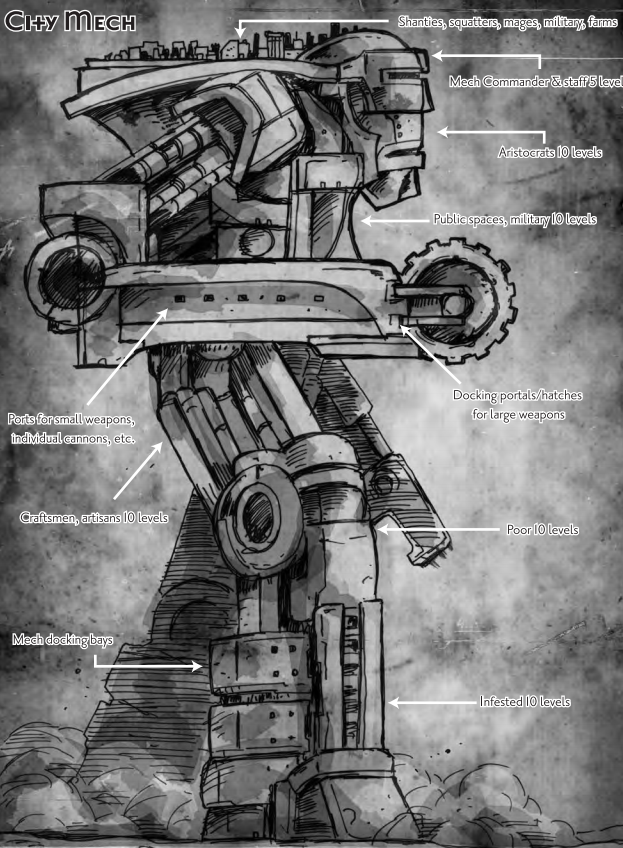
Parilus vanished soon after, taking back his books. Only three junior gearwrights were left behind to continue his work. The name Parilus became common among the dwarves of Durgan-lok in his honor. The city is fully self-sufficient, with areas for agriculture, livestock, living quarters, trade and the military. It can make anything it needs except fuel and metal, and both of those are easily found by mining. It is laid out like a mountain stronghold - vertical faces, tunnels, crawlspaces. It's very cramped and tight, but dwarves like it. It's a stronghold that walks. Physically, it is the smallest of any city-mech - squat, wide and thick. It's practically a walking castle, some 500 feet tall and designed with ceilings low enough for dwarves to make best use of the space. It has a permanent population of 950, and Parilus never explained all its secrets, leaving them to be discovered by the dwarves. In theory, it is part of the Stenian Confederacy; in practice, it is the voice of Duerok, and continues to follow the traditionalist clan model of Duerok.
Nedderpik was born after Parilus left. The Gearwrights grew quickly in power, as their work is what saved the dwarves...but now, they had also upended dwarven social structure. Clerics and axemen were ignored in favor of engineers and pilots. When the Gearwrights proposed the building of a second citymech, outside Duerok's control, there was a public rift. Nedderpik was intended from the start to be totally independent, and the resentment against it during its construction helped form the Stenian Confederacy, whose founding members were Nedderpik and Durgan-lok. The design of Nedderpik was intended to be a pioneer homestead, built for those who constructed it, at the cost of forever leaving Duerok and serving the Gearwrights. It's a radical departure from the design of Durgan-lok, built with the principles of mechanical walkers in mind rather than as a mobile castle. Its interior is scaled to dwarves still, but is nothing like a dwarven stronghold, instead taking advantage of the mech's physical characteristics. Living quarters and vital areas are buried in the center, with the outer frame reserved for shops, livestock, workshops and farms. The upper levels were intentionally set apart for the aristocracy, while the bottom level is a dungeon, or a sewer of sorts, used for engine rooms, refuse and sewage but sealed away from the rest of the mech as a buffer against invasion.
Culturally, Nedderpik is much more independent than Durgan-lok, with its governance managed by a council representing the various interests of the 'crew,' with a mix of dwarven can leaders, military voices and the Gearwrights in order to prevent mutiny from any side. Nedderpik is officially dwarven but will accept any race that will serve the Guild, and so it has many gnomes and halflings aboard as well as a few humans, though they tend to find the place very cramped indeed. It's an idealistic city-mech, with everyone aboard knowing they're building a whole new kind of life. The mech is just a bit over 1200 feet tall, and is more metal than stone, so it has plenty of space for its population of 3,500 or so.
Tannanliel is the largest elven mech ever made, and the only city-mech. Most elven mechs are smaller and meant to house no more than a hundred at the largest. However, the archmage Tannan swore to take the fight to the enemy, and so he set about shaping the living wood of Lilat forest into an immense weapon. This creation is the strongest mech any elf has ever created, and in the elven tongue its name means 'the walking tree of Tannan.' It is taller than any other mech anywhere on Highpoint, almost 2,200 feet tall at the height of its tallest tower. It is a slim, sleek machine that simultaneously resembles a tower, a tree and a golem. (BTW? That's nearly half a mile tall.) Tannanliel is constructed entirely of still-living enchanted trees, bound together to match Tannan's visions. The trees draw nourishment from the earth the machine walks on, putting forth vines when it stops fro the night and drawing in nutrients to grow and repair the trees of the mech as needed.
Tannanliel's interior is equally elven. Its vertical levels aren't based on use or function, but on magical hierarchy. The mech itself is ruled by the five archmages that created it, who live in the highest levels - the head and the towers that grow from the shoulders. These towers are protected by Tannan's magic and repel even the largest chunks of lunar rain. Below them are the mage residential quarters, from top to bottom by rank in the Order of Tannanliel, a magical council devoted to golems, constructs and mechs, who are responsible for making the mech stay running. They occupy the arms and upper torso. Below them are the warriors, archers and defenders of the mech, drawn from the dozen or so villages that have taken refuge aboard. They accept any and all elves in need of protection, but require all inhabitants to contribute to Tannanliel's defense when needed and to practice their magic until they can make their own mechs. Due to the efficiency of magical animation, there's a lot more space for living quarters than in most city-mechs, so the military gets to live in the middle of the torso.
The lower torso and thighs of the mech are home to traders and craftsmen who contribute to the maintenance of the citymech. In the legs are the peasants who farm small terraces that hang from it. Tannanliel itself is perhaps the most powerful mech in existence, and its living nature allows it to heal itself and even grow. It's a massive conduit of magic through which the mages aboard can launch powerful batteries of spell attacks, and nothing has ever beaten it in battle. However, it is vulnerable from the inside. Tannan is tied to the mech itself, with his will directing and sustaining it. The magical energy is so great he often needs others to help. He is slowly growing more drained, and urumor has it that the burden of the mech's creation was too much. Some say he had to take favors from extraplanar beings, and those favors are now being called in. Others believe the strain is just too much. However, everything Tannan and Tannanliel have done has been to help the elven people, and everyone that would harm an elf has learned to fear its power.
Next time: Rebirth, Haven and the major organizations of the world.
Humans Suck
Original SA post Dragonmech: Humans SuckShar Thizdic talked the human tribes together, speaking to them about resentment, anger and revenge. BHe made friends - but not until he heard about the dwarven city-mechs did he find a way to make his dream real. He sought out the dwarves, though he disliked them intensely, and made his way to Edge. They told him that, should he pay enough, they could build a mech for him. He convinced the humans of the plains to come together and work under dwarven direction - but not for the dwarves. For themselves. It didn't work quite as planned - the nomads weren't very disciplined or good at engineering and the dwarves hated the way the humans treated them - as servants, which Shar seemed to encourage. The mechs were failures for a long time.
The first success, however, energized the tribes. Shar played up their pride, even though the design was entirely dwarven. Shar was also careful not to use the new mech to fight any dragons - he couldn't risk it. Not yet. He rushed production of several more of these smaller mechs and, in secret, formally enslaved the dwarves - if they didn't work for him, he would kill them. This is how the Legion was born, and its first city-mech, Rebirth, was eventually completed with the aid of the enslaved engineers. Rebirth is the least advanced of any extant city-mech, made under duress and constructed by unskilled, self-taught labor. Humans were more involved in its construction than any prior Legion mechs, largely because the dwarven engineers kept getting killed, and their lack of expertise is clear. Rebirth routinely suffers mechanical failures, and is powered mostly by the had labor of Legion soldiers and orc slaves. Against any other city-mech, it would surely lose. However, it has thousands of human tribesmen and a fleet of smaller mechs backing it, making it the most powerful human structure on the plains. Only Tannanliel could match it for power there, and Tannanliel stays in elven lands.
Brief sidebar: a common goal for adventurers is seeking wealth through beauty. Finding any kind of pretty flower is a chance for a payday, as beautiful things are now so rare that the master of a mechdom will often pay highly for anything pretty. Hunting for flowers, cute animals and other rare signs of beauty is a good idea for anyone wanting to make a buck. Back to Rebirth. With it and the mech fleet completed, the human tribes are resurging. The dragons have been pushed back, and Rebirth is now Shar's mobile fortress, drawing ore and more tribes to him. Shar is aware of its weaknesses - but he allows no one else in the Legion to be.
Haven is their most recent work, the second human city-mech. Haven worries the Stenians and the L'Arile far more than Rebirth. Rebirth was weak - a symbol, little more. Haven, however, corrected the mistakes of the human coglayers. It is on par with the weaker dwarven city-mechs. This is a huge accomplishment for humans, who have no history in engineering or mechanics. If they continue this rapid progress, their next offerings may will rival even Nedderpik. Both Haven and Rebirth are tall for city-mechs - Rebirth at 900 feet and Haven at 1300. Each is home to a little over 2000 humans.
The Gearwrights Guild, now. These are an ancient order of dwarven engineers, dedicated to the 'gear-driven arts.' They have been powerful and weak over the years, and now they are quite powerful, as their knowledge is now vital to survival. Many believe the current age to be the first coming of mechs, but the Guild claims otherwise - they believe the steam engine predates even the elves, and that dwarves were using them before magic was given by the gods. They hid underground only once elven wizards became powerful, as their primitive mechs could not stand against the wizards. It was only then that dwarves instead turned to fighting and the gods in the depths. However, they say, the Gearwrights Guild was formed to preserve the ancient knowledge. The elves, of course, say this is bullshit, and even many dwarves think it's just a lie to gain legitimacy. Steamtech, they say, is still widely distrusted and misunderstood. Any claim at primal origins is just to make people accept it.
However, the Gearwrights do have some evidence. First, they have the Master Repository, their library, which appears to be a prehistoric construction - floor to ceiling bookshelves in an area the size of a small town. Every book focuses on machines and mechanics in an immense array of topics, from simulation of flight with mechanical wings to steam tanks to walking machines. Some of these have never even been attempted in the modern era. Most are printed on a mechanical press the Guild only allows members to use, and by conservative estimate, the time needed to study, collect and print all the books in the library would be over 50,000 years. The few volumes that have left the library, usually by theft, are stamped metal pieces rather than printed - able to last far longer than paper. The languages cover so many different variants of dwarven that it's hard to tell when they were made, and their publication dates are only listed in two formats - the Guild system and one of a variety of old dwarven systems used in the past. If, using these older methods to triangulate, the Guild system is accurate...well, some of the books are tens of thousands of years old.
The Master Repository lies in the depths of the underdeep, far below any dwarven settlement. Its general area is common knowledge, but its specific location is hidden by a terrible maze of passages and both living and mechanical guards, buried under layer after layer of ancient ruins. Then, there's the walkers. The Guild claims it has relics from the First Age of Walkers, and some of these were the first mechs to be used. Their design is archaic, using dwarven imagery predating any living society. Some say it's merely a cosmetic deceit, of course, but these Gearwright mechs are undoubtedly superior to others, using secret technology of the Guild. And, of course, there appear to be buried walkers. In the past, they were believed to just be unusually shaped dungeons - but now, on revisiting, these things are believed to be ancient, buried mechs - things like the Pretominin Heads, the STanding Dwarf, and rumors of dungeons in strangely humanoid shape. The Gearwrights say these are, in fact, testaments to the steam engine, whose power can rival even the best magic in the right circumstances.
The Guild is structured as most craft guilds are - apprentice, journeyman, and then five ranks of gearwright, as we've discussed before. The knowledge that the Master Gearwrights possess on engineering, physics and technology is insane. They could, should they choose, make mechs far more efficient than any that exist now, using only physics, not magic. They rarely do more than design these, however, to keep the knowledge secret and out of the wrong hands. The Guild has its own mechs, some of the best around, but the ones the Masters could make are at least an order of magnitude beyond even these. The Guild's size has varied wildly over the years, but it is now growing rapidly, and few large mechs don't have at least one gearwright, while city-mechs usually maintain a small Guild library. However, all gearwrights swear loyalty only to the Guild. For now, they are given freedom of passage even in war...but that could easily change.
Next time: Thieves' guilds and the DragonMechs.
CRIME TIME
Original SA post Dragonmech: CRIME TIMEThere's not that many places to hide in a city-mech, and the organized criminal underworld has to exist knowing that, should the cops try hard enough, they can always be found. As a result, the role of the thieves' guild has changed. Diplomacy and brokerage are more important than stealth now, and for the most part, thieves' guilds have business relationships with the leaders of a city-mech, acting as a kind of unofficial extension of power. In exchange for regulating the slums and controlling serious crime as well as doing some light espionage, they get to take part in minor theft and extortion for profit. It's a necessary evil for most mech commanders, easier to deal with than fighting the criminals. It keeps things at least nominally under control internally. These relationships aren't public, of course - hell, most of the thieves and crew of the mech won't be aware of it. It becomes clear only situationally, when the top pressures the guards to stop looking into certain crimes or the thieves pass on anonymous alerts about certain problems. It's delicate, and it relies on the thieves keeping their crime at a 'tolerable' level, so they try to keep things from getting out of hand. Sometimes, more ruthlessly than the law does. As aresult, most crime in city-mechs is burglary, extortion via protection rackets and enforcing monopolies.
A good example would be that one one of the Stenian city-mechs, the thieves run the blacksmithing trade. Blacksmiths now charge three times their normal prices, and pay a sizable cut to the thieves, who ensure that no rogue discount blacksmiths ever get set up. Another city-mech has thieves that specialize in luring the walthy into social events whenever the mech stops somewhere, then run pickpockets in the crowd. Another is just a fence, serving as middleman for imported stolen goods. You might wonder what rogue PCs have to do, then - they can get by on petty crime for a while, but a crime spree's going to get stopped by the guild. So, you have two options. First, join a guild, or second, work where they don't control. Or, I guess, fight the guild, but that's rarely a good idea.
Rogues themselves have changed, with the rise of mechs. Breaking into a mech is different from breaking into a fort or home. Some rogues specialize in handling machines and entering mechs, and they have informally become known as stalkers. They aren't organized in any real way, but tend to know each other socially as fellow craftsmen. Most were mentored by other stalkers. They terrify mech commanders, as a single skilled stalker can get into a mech, make their way to the control room without detection, kill the commander and sabotage the mech before anyone knows what's happening. However, they also value stalkers, for the same reason. Stalkers aren't going away any more - not when the value of a stealthy saboteur is so high.
For our final organization, we'll talk about the DragonMechs, a specialized Stenian military unit of lunar dragon-slayers. Membership is a point of pride for a Stenian soldier, and only offered to the best, who are known as dragon hunters. There's normally no more than 10 dragon hunter mechs active in the Confederacy at any time, and all of the pilots are at least 14th level mech jockeys, most of whom have spent time training with the Irontooths. This is officially punishable, but an informal requirement to join the DragonMechs. They are trained in group tactics, and when deployed, tend to operate in pairs or trios of complementary mechs that can take advantage of each other's strengths. Legally, the DragonMechs can commandeer any mech they want. They're a unit that reports only to the top, outside the normal chain of command and with immense discretionary power over which missions they take. This lets them react very quickly to reports of dragons. Among the Stenians, the DragonMechs are celebrities. Every dwarf boy that dreams of becoming a pilot dreams of becoming a DragonMech.
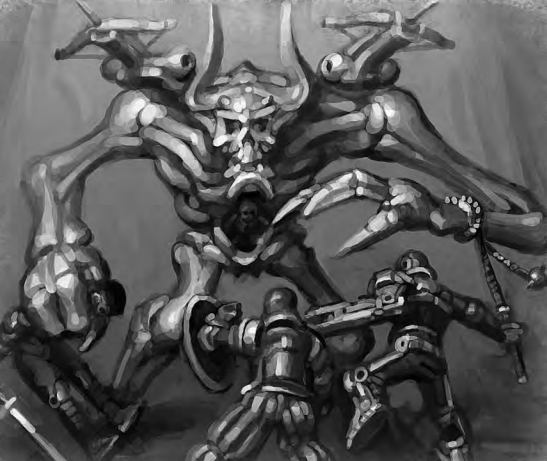
Now, monsters. First, we get a list of traits that apply to any and all lunar creatures. First: they have alien psychology. They're rational but their minds and nervous systems work on entirely different methods, and so they get +10 to all savces against mind-influencing effects, mind blasts, psionic attacks and attempts to detect thoughts or read minds. Second, they take half damage from air-, fire- and water-based attacks, but double damage from earth-based attacks, due to their subtly different elemental structure. They do need to breathe air and eat, but extract utterly different nutrients from food, and need not drink water, though it is believed that they need some other form of sustenance that is invisible to normal beings. Their skin is full of large, ribbed blood vessels that undulate slightly, and their blood is an oily, semi-translucent white. They cannot be affected by lycanthropy in any circumstances due to apparently having a different form of lycanthropy virus in their blood which does not cause shapechanging; it is believed that lycanthropy may be a mutated form of lunar traits. Clerics and paladins of earthly gods can sense if a creature is lunar in origin with a Wisdom check. We also get a note that due to the closeness of the moon, all attempts by Lycanthropes to control their shape are at -5, with another -1 if a lunar creature is nearby.
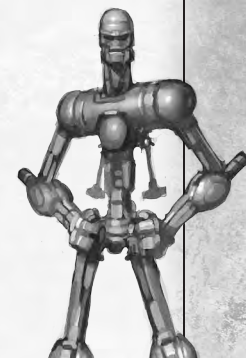
The Warder is a specialized form of clockwork puppet used to stop trespassing. They are designed to have a stern-looking face, and are a Medium Construct, CR 0.5. They guard a fixed area which they will never leave, and are programmed to give a predetermined warning to anyone that gets within 20 feet. If something tries to pass them, the warder attacks, but will not pursue - get more than 20 feet away and it breaks off its attack.
Next time: THE SHOCKER, and other stories.
Shock and Horror
Original SA post Dragonmech: Shock and Horror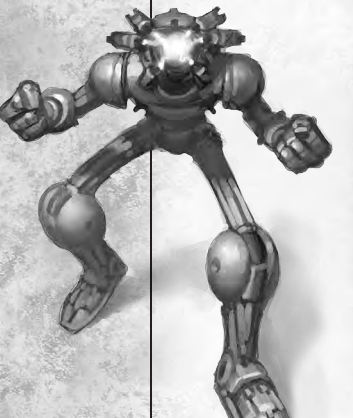
The Shocker is a Large Construct and designed as your basic assault clockwork. It's got an electrical shock built into its face and typically is programmed to attack anyone that comes near it, possibly with an exception for allies but not always. It can shoot lightning or it can charge itself to deliver the shock on hit with its punches. It is otherwise notable mostly for looking really goofy and being CR 1.
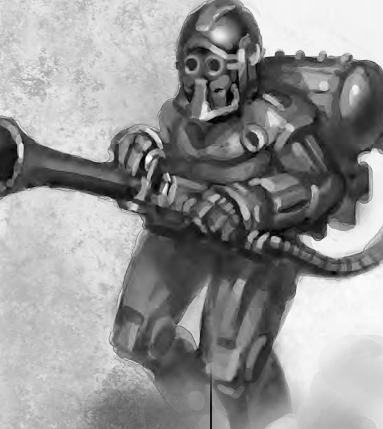
Coglings, like normal halflings, are Small Humanoids with class levels. This is because they're feral halflings that live in the gear forests. However, they are rapidly evolving into something new. Their culture is far less trusting and more hostile than most halflings, due to the dangers in the hot, polluted engine rooms they live in, but they are tougher and stronger. They are abnormally pale for halflings and tend to be covered in grease and sludge. They usually spend their time sneaking about unseen, attacking from the most dangerous spots in the gear forest to maximize the danger to their enemies - oil slicks, dangerous gears, that kind of thing. They also raise and domesticate grease lizards as pets and guards and commonly utilize homemade clockwork puppets with implanted smoke bombs. Coglings live in small groups that patrol set territories in the gear forests, and while some are employed by city-mechs, most are stowaways who hide from the other inhabitants. If found, they are often evicted, which usually happens as a result of a repair crew getting ambushed while doing engine repair. However, if left alone, the coglings will often do engine maintenance on their own to ensure they're left alone. They tend to ignore intruders that don't seem to be trouble, but are ruthless in taking out anyone that seems hostile or dangerous to the gear forest itself. Their bands almost always have at least one coglayer and are led by clockwork rangers.
You can play as a cogling if you want. They are identical to halflings statistically in most respects, except as follows. First, they get a +1 bonus to Reflex saves on top of the normal halfling +1 to saves in general. Second, they have low-light vision. Third, they do not get the halfling bonuses against fear or to Listen checks. Fourth, they get the Gearstride feat for free. Last, their favored class is Clockwork Ranger.
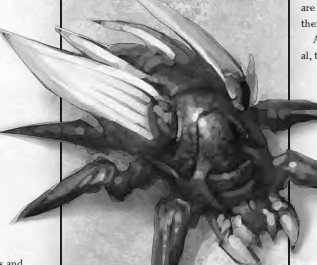
The Crumble Bug is a Dimunitive Vermin, a foot-long bug that eats metal and is CR 1/8. Mech-dwellers kill them on sight and often train cats or dogs to hunt out and kill them. Fortunately, the bugs reproduce slowly and don't eat much, so they're usually exterminated before they do too much damage. They are pretty slow to react to threats, too, and not very brave. The problem is that they exude a slow-acting acid that rusts metal so they can eat it, and while a single bug won't cause much damage, in numbers, they can destroy plenty. Each bite can rust an area about equal to the creature's size - 24 square inches. Further, in areas of dense metal, crumble bugs can dig tunnels for travel. These things are illegal to raise or harbor aboard most mechs, and anyone who has them is assumed to be thief or saboteur, which is usually true. Most thieves' guilds keep a small swarm of them to sabotage or blackmail engineers, or to cover up intentional damage.
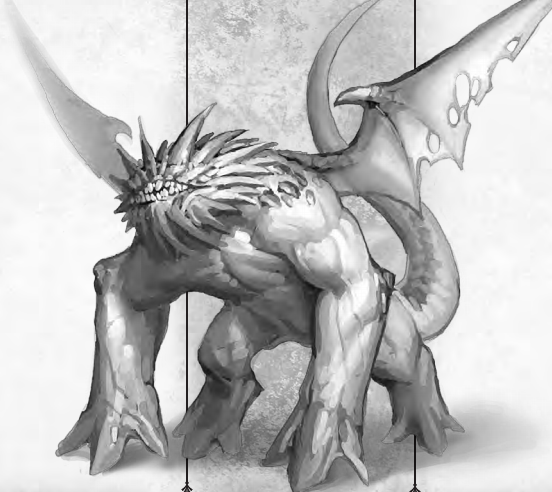
Unlike most lunar beings, a Lunar Dragon is a True Dragon rather than an Aberration. They are immense creatures, larger than terrestrial dragons of equivalent age, and resemble rhinos or elephants more than the cats or reptiles that other dragons do. Their skin is an unhealthy white, and their blood vessels writh not far beneath it. Their face is covered in horns around an asymmetrical maw, and their wings are actually too small to lift them properly on the planet rather than the moon, and their flight is clumsy at best. They do not keep lairs, for the most part - they just wander around and destroy whatever they find. They usually eat it, but don't seme to like the taste of terrestrial flesh. They do not value treasure of any kind. They have a natural resistance to the lunar rain, but will burrow into the earth to avoid meteors. Other kinds of lunar dragon do exist, but this is the most common type. Their breath weapon is a cone of lunar energy resembling white fire, but it has no elemental equivalent. It bypasses all elemental resistances besides a blanket energy resistance.
Next time: Aberrations, so many Aberrations.
It's big and angry, what more do you want?
Original SA post Dragonmech: It's big and angry, what more do you want?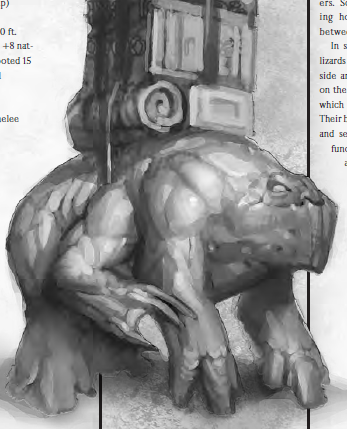
The Dronog is a Large Aberration (Lunar) which is, essentially, a beast of burden. It probably has a natural state, but no one knows what that is, as on Highpoint they are invariably encountered as pets/tools of the lunar skinstealers, a malevolent lunar race. It is believed that the two species have had a host/parasite relation for a long time. A dronog resembles a five-legged lizard, three legs to one side and two to the other. The middle leg actually has a hand on the end, usable for grasping. These things are big and chalky-looking, with a bunch of orifices that have no clear purpose, no neck and dull teeth. Their intestines are visible below the skin and occasionally break it, only to remerge into the body. In the wild, they appear to spend most of their time burrowing through dirt and eating minerals, attacking any other cerature that approaches. Under the control of a lunar skinstealer, they do whatever the skinstealer wants. They appear to have some form of limited empathy or telepathy audible only to terrestrial beings as a form of disturbing mental static, which drops the Intelligence of anyone hearing it by 1d4 for as long as it is 'audible' and rendering it difficult to cast spells or anything else requiring concentration.
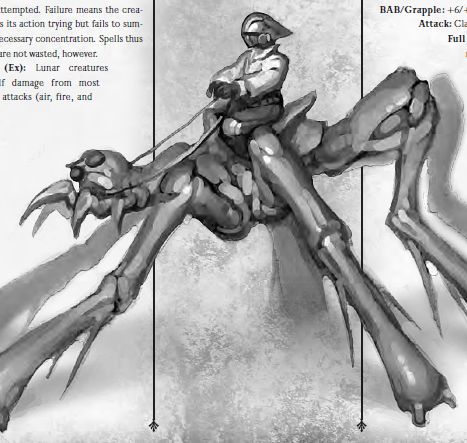
The Dusk Devil is a Huge Aberration (for the wild ones) or a Large one (for one bred by the Stavians). They are giant insects that are built vaguely like a daddy longlegs, with legs that carry their proportionally smaller body eight feet off the ground. Besides this, they have wildly variable appearances, all of them gross. The smaller kind is about the size of a horse, but the larger ones can be more than 20 feet long. It's unclear where the dusk runners first found these things or how they first tamed them, and most scholars believe the dusk devils originate on another plane. Wild ones are rare but not impossible, and will be active mostly around sunrise and sunset. They will attack humans when hungry, and in the wild form simple hunting packs. Their constant movement generates a cloud of dust devils around them in areas that have loose dirt, providing them with excellent concealment, though they're able to see clearly in it. They are surprisingly easy to domesticate, which is part of why many scholars believe they were the servants of some extraplanar people.
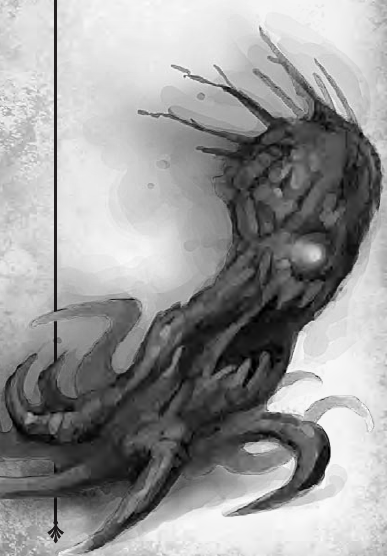
The Forestrati are Huge Plants, and what's left of the treants of Highpoint. The lunar rain destroyed most of their groves, and that loss drove the forestrati utterly insane. Now, they are evil, twisted beings that resemble the charred and blackened wood they live in. They have no charity or goodwill for any living creature, and they do not even hunger for revenge - only mindless destruction. They are clever, cunning, but not rational beings, acting more like very clever animals, and some even eat meat. The elves of the forests avoid or kill them when possible, as the forestrati will attack anything living and seem to enjoy causing horrible destruction. Unlike normal treants, they have no bonus to hiding, but also lack the treant fire weakness - in fact, they're resistant to fire. They also like to throw rocks.
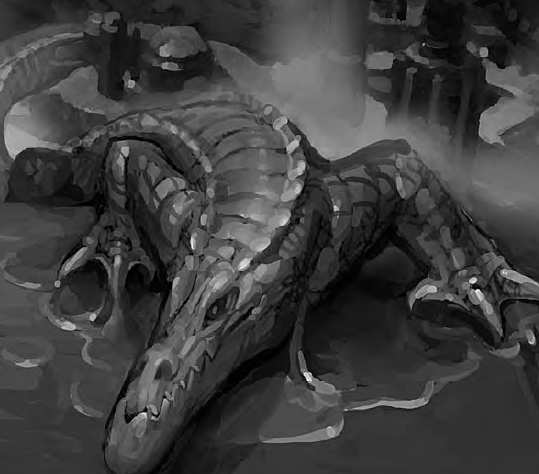
The Grease Lizard is a Medium Animal, something like a five-foot crocodile with brown or gray skin. However, they typically are covered in a thick layer of oil. They inhabit, at this point, mostly mech engine rooms, where they are at home in the sludge. It is unclear where they came from, but they like to lurk in the oil and lunge at passers-by that look tasty. They're very good at hiding, but also extremely flammable, due to being mostly covered in grease and oil.
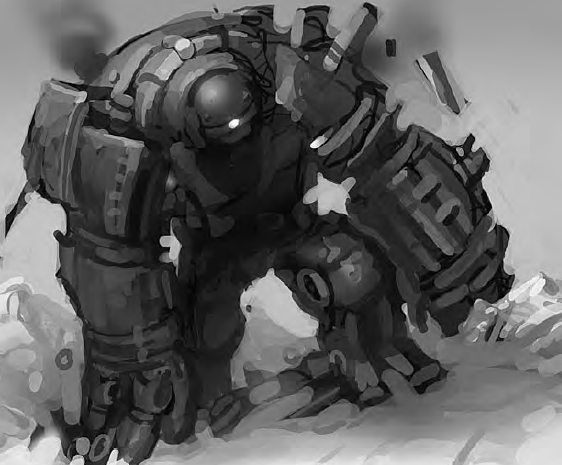
The Iron Shambler is a Medium Construct, a sort of clumsy, vaguely humanoid pile of metal, created by the spell 'Animate gears'. Most are controlled by a wizard or clockwork ranger, but some just wander aimlessly. They're usually made from rusty and unusable parts, but any pile of scrap metal weighing at least 200 pounds is a viable shambler in a pinch. In combat, they primarily just hit things really hard. They aren't very smart.
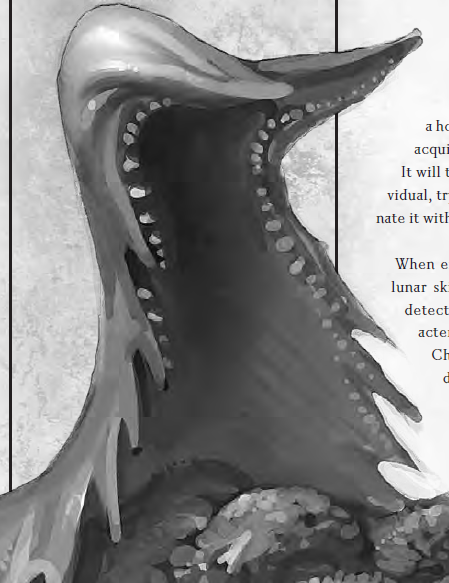
The Lunar Skinstealer is a Medium Aberration (Lunar). In its natural state, it is a parasite that vaguely resembles a stingray - a massive flap of skin some six to eight feet wide and about two inches thick. One side is a chalky gray, the other is covered in natural velcro hooks. They move like a worm but are strong enough to rear up when needed. However, they are mostly found on a host. They survive, see, by wrapping themselves around a host creature, overwhelming the victim's nervous system and taking over the body. Their society is a mystery, as they cannot communicate in any intelligible way, though they are clearly intelligent. On their own, they aren't especially dangerous, but they are fully capable of using all of their host's abilities once they surround the host's body with themselves. You can save the host by beating the skinstealer to death - only piercing attacks risk damaging the host. A dominated victim has control of their mind still - just not their body. Skinstealers avoid combat when possible, and if they lose control of the host, they will use their hooks to try and kill the host. You cannot play a skinstealer.
Next time: mo' monsters, mo' problems.
Fishman
Original SA post Dragonmech: Fishman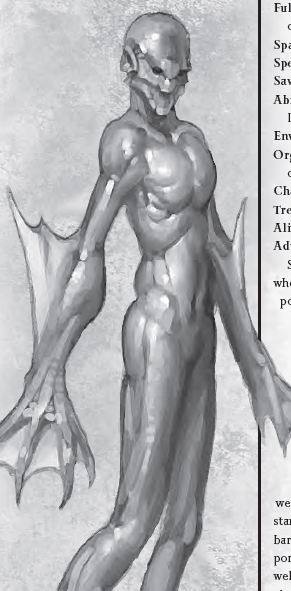
Slathem are Medium Humanoids. They are amphibious ocean-dwellers that live in cities of wood, stone and bone atop coral islands that spend half the year underwater. They are bulbous, soft creatures with webbed but dexterous hands, and stand about seven feet tall. They can breathe water and air equally well. Their cities are designed oddly - no stairs at all, with structures on top of coral that often need replacing. That's why they trade with land dwellers - mostly for building material. Some cities have extensive sewers and dungeons in the coral, which remain submerged even when the upper levels dry out. In highwater, the cities are buried under 40 feet of water and the slathem can easily swim from floor to floor. In low-water times, however, they have to awkwardly climb and scramble. As a result, ground level is the most prestigious and expensive, easily accessed all year.
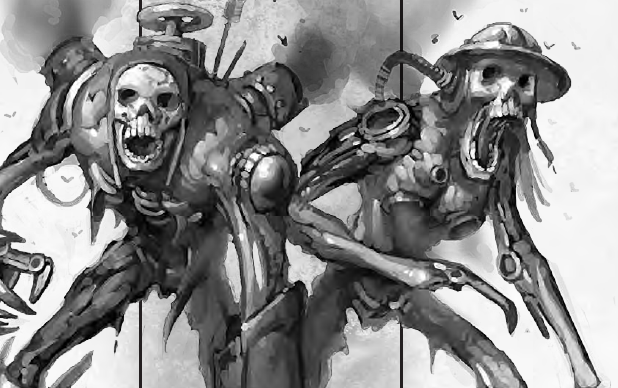
The Smoking Dead are Medium or Large Undead that come in skeleton and zombie variations. They are essentially a merging of necromancy and steamtech, reanimating corpses with steam engines and using metal to replace lost body parts. Their chest contains the smoking engine that gives them their name, and the magic keeps them from falling apart. Just about any corpse, really, can become a smoking dead. Rarer are the 'meat racks' - iron, man-made skeletons with reanimated muscle welded to them. All three types - skeleton, zombie and meat rack - are tougher but slower than normal undead, and often armed with extremely dangerous weapons welded to their forms. Also, because D&D, the steam engine used to make any of them must be made, specifically, by an evil craftsman. After it animates a body, that engine is now permanently tainted with evil and a sticky crust, which will both infect anything you plug into the engine.
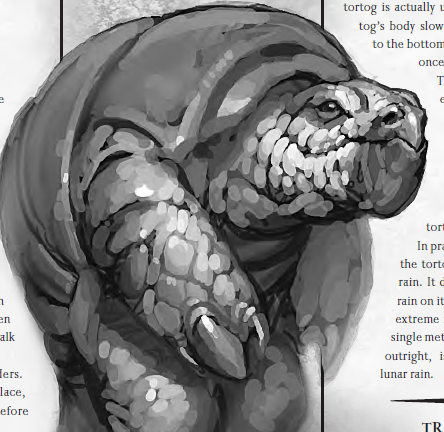
Tortogs are giant turtle people. They are Large Humanoids (Tortog), and while only five feet tall are extremely broad and weigh up to 600 pounds due to their extremely thick armor. They usually are bipedal but can drop to all fours as needed, and in the event of danger can retract their head into their shell and walk on all fours for safety. They tend to be wandering traders, who carry their sacks of goods within their shells. When they retract into the shell, they usually have skin folds their goods can be safely hidden in. They are slow but immensely strong, favoring clubs in one hand and their mighty jaws and claws to assist. When they retract fully into their shell, they get a massive AC boost and immunity to crits, but cannot move or attack and are considered prone. They also do not feel pain unless their shell is pierced, which largely immunizes them to the lunar rain.
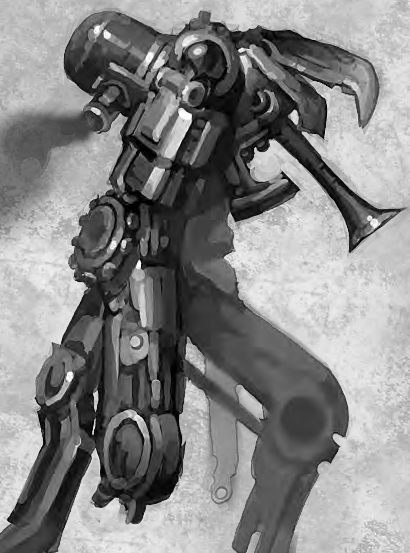
A trak trak is a naturally occurring Medium Aberration made of random scrap parts. None of them look alike, but they usually assume vaguely dwarven shapes, though not always. They animate spontaneously without any clear cause, generally in the spare parts of mechs or in workspaces. They wander around for a random period of time, ranging from hours to days, then collapse into parts again. Most believe they are supernatural somehow, but only the followers of Dotrak believe they know the cause: their god. This is correct - the energies formed by Dotrak birthing itself is expressed in the form of animated metal gears. They are entirely harmless, fighting only if attacked and breaking off the fight if the attacker stops.
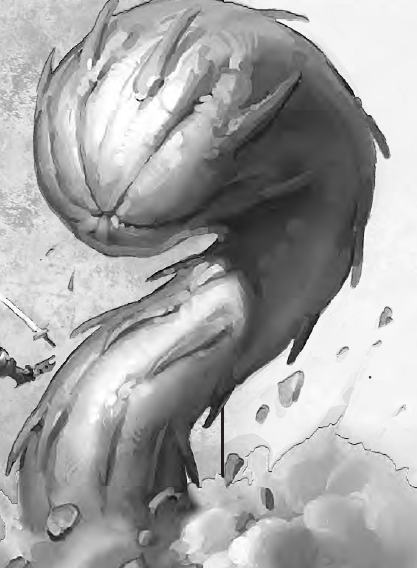
Last up, worms. They come in three types: Giant Worms. Deep Divers and Shakers, all Huge Magical Beasts. They're three breeds of the same worm species, traveling in the same herds. Together, deep divers and shakers are about 10% of the worms, but the worm farmers have been breeding them up. Your average worm is around five feet in diameter, but deep divers are thicker. Shakers are the same size but visibly weaker and emitting a constant subsonic hum. Worms aren't aggressive, and in fact rarely notice others at all unless attacked. The normal worms just bite people, but aren't good at it. Shakers, however, can emit a sonic blast against enemies. Worms are pretty easy to tame, and breed by live birth, though most die within three months.
Next time: Nedderpik in detail.
Nedderpik is a silly name
Original SA post Dragonmech: Nedderpik is a silly nameThe next chapter is all about what campaigns you might run. It's got some charts for random terrain problems in a city-mech or shit you might run into in the gear forests, but mostly it's just discussing, like, how you can run a campaign with mechs, or if the whole party has one mech, or if it's normal adventures but on a city-mech or whatever. How to keep folks involved with the plot, why you might go hunting dragons or fixing the lunar rain and so on. Noting all that interesting or special.
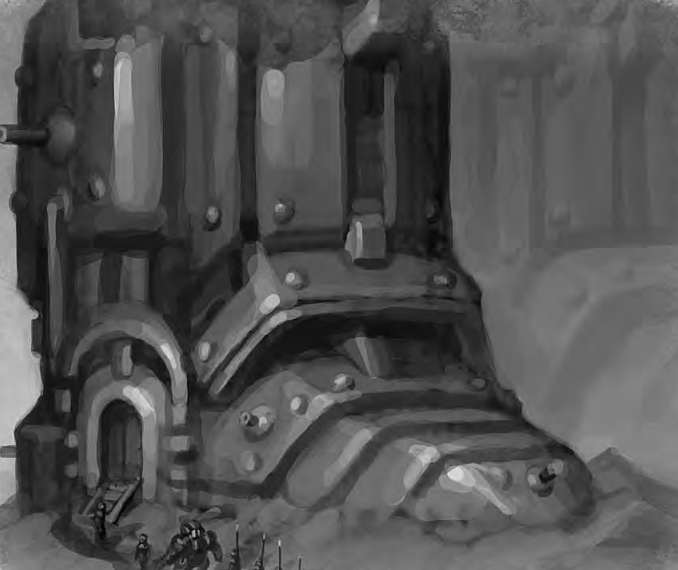
Now, Nedderpik! We get a detailed look at Nedderpik. It is size City-Mech E, at 1200 feet tall and a crew of 2056. It is a very dangerous machine, between its arsenal of weapons, its defensive mech fleet and its sheer size. Its fleet is focused on relatively small mechs, on average Gargantuan, which constantly patrol the area around its feet. Its legs each have 10 mounted steam guns a few dozen feet off the ground, which are manned at all times and have overlapping fields of fire. If those fail, there's a steambreather as backup on a track that can rotate to any side of the leg. The left arm also has a humongous flamethrower, and as a last resort there are 987 firing ports on the torso from which crew might rain down small arms fire. Against dragons, it also uses six leg-mounted steam cannons, plus nine more on the torso and head, and an array of javelin launchers on the torso. Against larger mechs, it uses an oversized, head-mounted cannon. the firing arc is limited but extremely powerful. Its arms also each have a mounted bore puncher and the right has a lobster claw, to better allow its assault teams to board enemy mechs. The city-mech's biggest weakness is its speed and clumsiness. It is vulnerable from the rear, armed only with a mounted chain tentacle, two cannons and a buzzsaw.
Of course, attack is not really the main threat Nedderpik tends to worry about. Sabotage is. Thus, the commanders and Gearwrights Guild maintain strong ties with a powerful thieves guild that is a major player in the mech's politics. In exchange for ignoring their protection rackets, the guild patrols the lower levels, focusing on finding those who can bypass mech defenses. The Guild would prefer nicer methods, but you do what you must. On the outside, Nedderpik is a bulky, vaguely dwarven shape coated in smokestacks and chimneys. The hull is cast iron with limited mithral plating on entry points and critical areas. The feet and shins function as mech hangars, with the engine rooms in the knees and lower thighs. Above that is where habitation areas begin. Transport uses steam elevators, four per leg, but typically only military personnel use them. Inside, things are small - five foot ceilings in most areas, and not much lightning in restricted areas due to dwarven darkvision. Businesses are usually lit by torches, while public areas use gas lamps or ensconced lanterns. Travelers without darkvision use lanterns just in case. Air is recycled throiugh the mech via immense metal fans on the exterior, which can be heard at all times. The air, despite best efforts, is always muggy and warm, and the centeral areas have very little air circulation, so it is often sweltering. Dwarves are used to that, though, in the mines.
Getting aboard the mech isn't that difficult - you need a medallion matched against a master list, but a stolen medallion will work pretty well if you use it fast enough. Thus, residents protect their medallions viciously. Getting aboard without one is harder, as all people are either essenctial ('has useful skills') or nonessential ('doesn't'). Essential applicants have to pass an interview and detect evil check, but then get in. Most coglayers, mech jockeys, warriors and medics can get on this way, as can engineers and blacksmiths. Wizards and sorcerers occasionally can. Everyone else is nonessential, and are evaluated based on how much they'll contribute compared to the cost of feeding and housing them. Being skilled in a craft is a big help here - unskilled labor is cheap. Traders can get on temporarily without much trouble, as can adventurers, as long as they're not covered in blood at the time. Temporary stays last from one day to six months, with forms for extension. Housing is very expensive, however, and to buy your way on will cost at least 5000 gp. The very top and bottom of the city-mech are Guild property, as well. The top pays rent; the lower level is lawless, as officially no one lives there and the Guild will reclaim it for use as needed. The rest of the mech has 'land' that can be purchased, but it's never on the market for long, and the prices always go up. Any given person can't own too much space, however, and the Guild always has the right of first refusal on all space. The mech's constant motion also has a tendency to cause seasickness in those not used to it - characters that have not been on a city-mech before have a -1 penalty to Dex for the first month and have to make a Reflex save not to fall over if they move above a walk.
Nedderpik is ruled by three factions. First is the Admiral Navigator that commands the mech, second the three-dwarf Council of Navigators, and then the Gearwrights. The Council manage policy and law as well as deciding where Nedderpik goes. The Admiral manages day to day life and piloting. The Gearwrights maintain the mech and officially own it. The politics of power are in constant flux, and while the fights aren't too nasty, they are often confusing and bureaucratic. The mech is outside the dwarven clan structure, so no one has any firm sense of how things should be done. The current Admiral Navigator is "Steel" Dworgen, a level 17 mech jockey who earned his nickname for his piloting skills and nerves. He commands a vast legion of jockeys who each manage some small aspect of Nedderpik's piloting, and usually doesn't need to take command directly. The Council is made of an elder cclansman, a gearwright and a general. Currently, that's Lord Thulin (Fighter 6/Aristocrat 8), Gearwright Trigius (Coglayer 9/Gearwright 9) and General Gunnar (Fighter 19). Each has an indefinite term.
The social hierarchy of Nedderpik places them at the top, followed by aristocrats of the clans and mech jockeys, then technical crew and clergy, then the military in general and most warriors, then wizards and most merchants, then craftsmen, then farmers, then laborers. Nedderpik is run as a military base, importing metal, food, wood and coal, and selling protection and shelter, though also finished metal goods. Internally, however, it's mostly traditional dwarven labor and maintaining the mech itself. The military divides itself into three main forces - the Footman Guard for ground troops, the Mechanized Assault for the mech fleet, and the Mechanized Defense for the city-mech's direct crew. The Footman Guard serve as police and military judges, with no other legal system existing, and are in charge of immigration as well. The Mechanized Assault maintains the outer patrol and escort. Mechanized Defense is the Admiral Navigator's boys and the hangar crews.
At any given time, there are also usually two or three DragonMech pilots aboard, and there's a lab for the College of Constructors. On top of that, they have three local organizations on board. First, the Ball and Bolt, a military club dedicated to ranged weapons and mobile combat in mechs. Members are all officers, mostly mech jockeys or fighters with piloting skills, and their main occupation is talking their way into the spare gunner seats of any mech patrol they can, to better practice. Then there's the Jousting Crows, an informal social club for mech jockeys rather than a club of mech jousters. They're named for a pub in the upper levels. Any mech jockey may join, even if they are neither a military officer nor even a citizen. Finally, there's the Cannoneers, a set of artillery mathematicians, primarily mech jockeys or siege fighters, who train with the steam cannons. They are dedicated both to physical training and the math of artillery fire, and have discovered several rules of geomety so far. They're on the road to developing trigonometry, and while initially seen as esoteric nerds, they are rapidly earning respect for the practical uses of their discoveries. Anyone can join, but Int 16 or below is going to make it hard to follow what they say.
Finally, we get a letter from the creator of the game about the group he first ran DragonMech for and how much fun they were, and how he would do stuff like enforce rules that people underwater couldn't speak so neither could their players. Honestly, it seems weird to me but his group apparently enjoyed it, stole their own mechand so on. The goal for mechs was not to be anime mechs of Battletech stuff, but clumsy, oafish metal giants that remain upright through luck as much as anything else, which triumph by main strength...except for the Irontooth Clans, who are anime as hell.
The End.
So, do you guys want MORE DRAGONMECH next, or a detour into another weird setting - specifically, Council of Wyrms, the 2e setting for playing dragons?